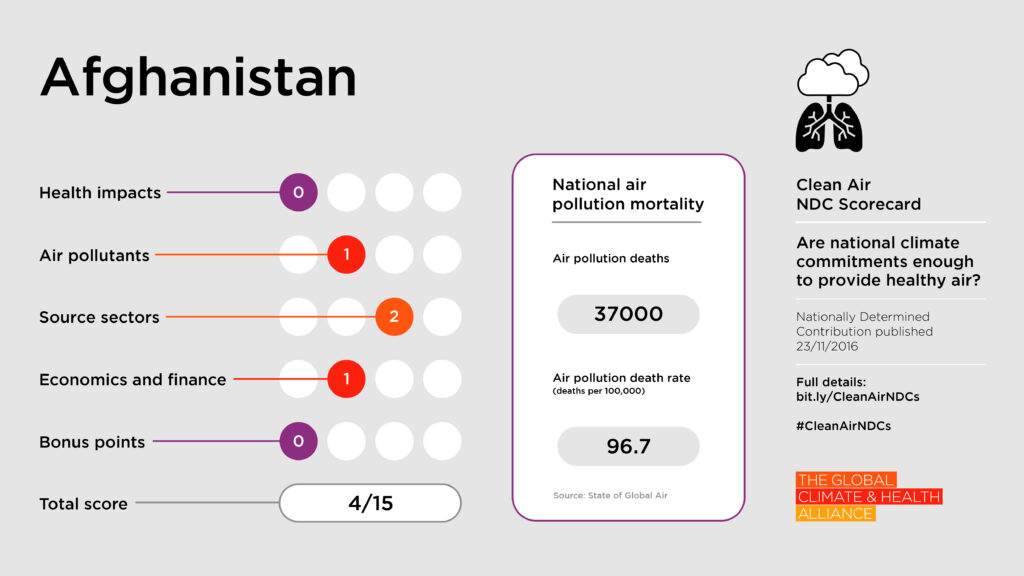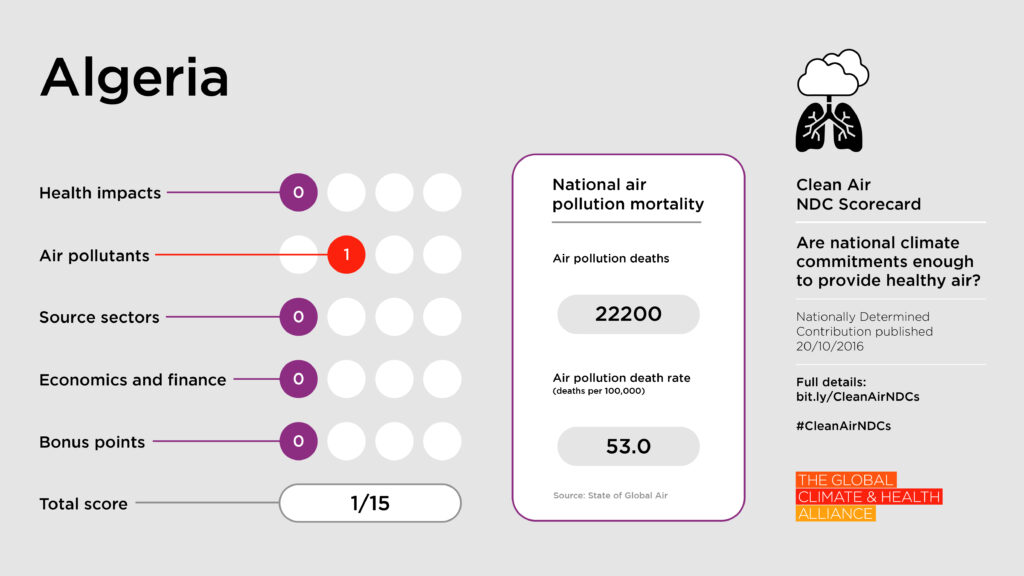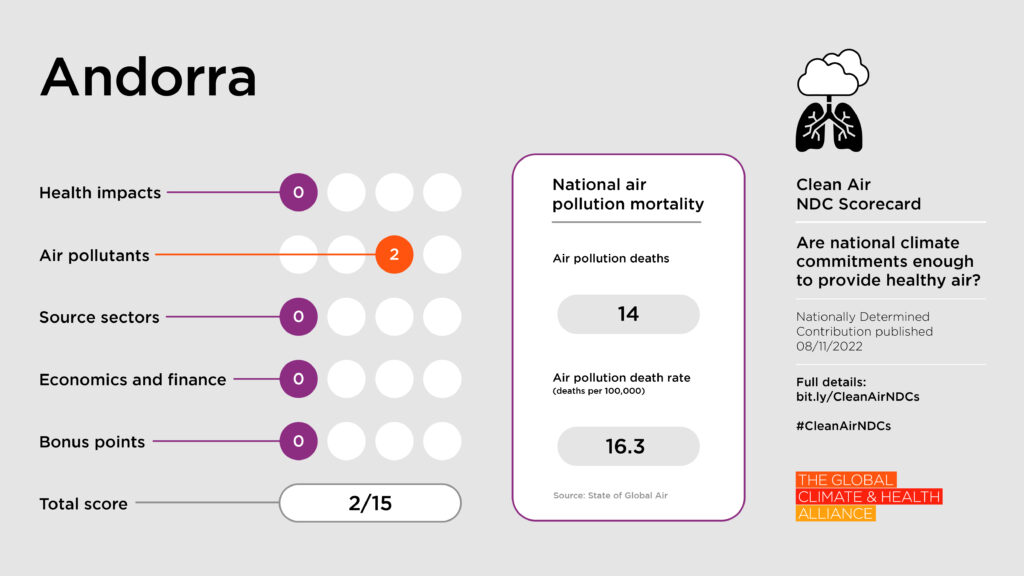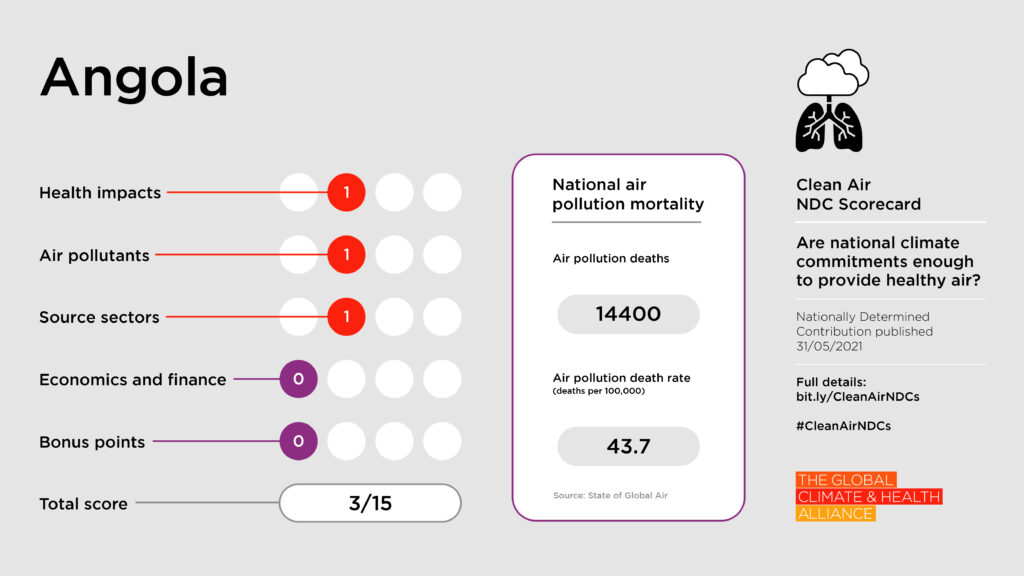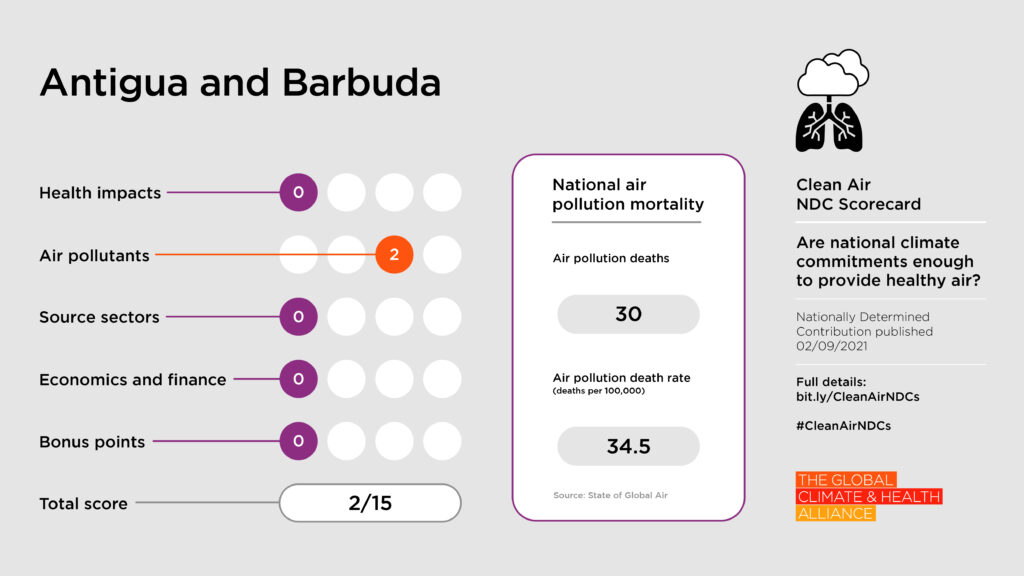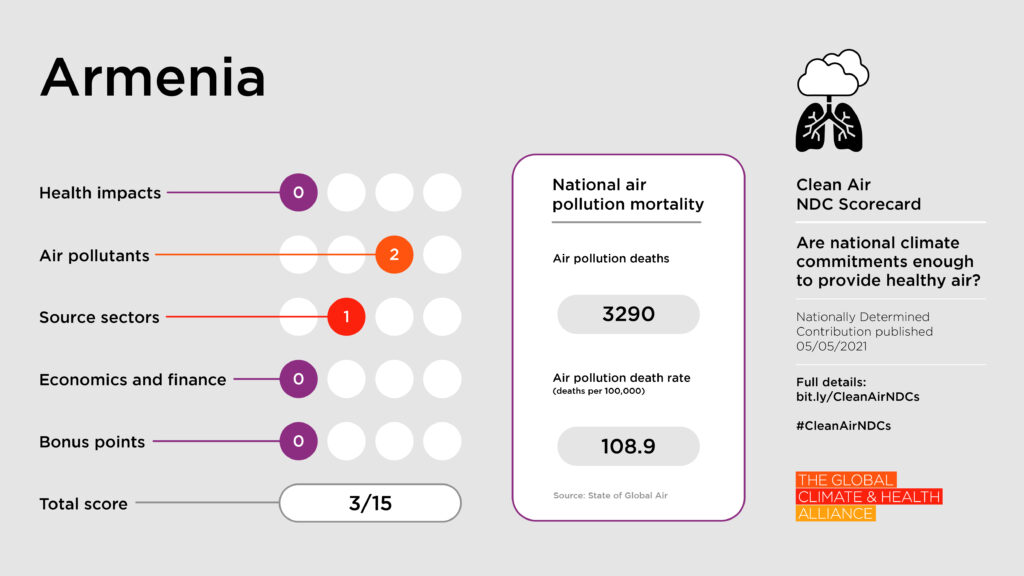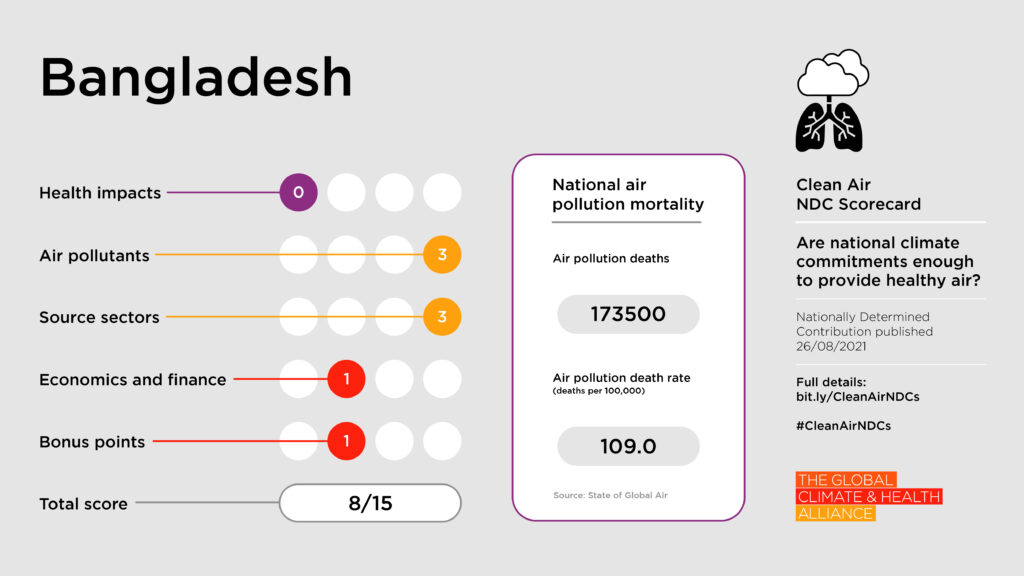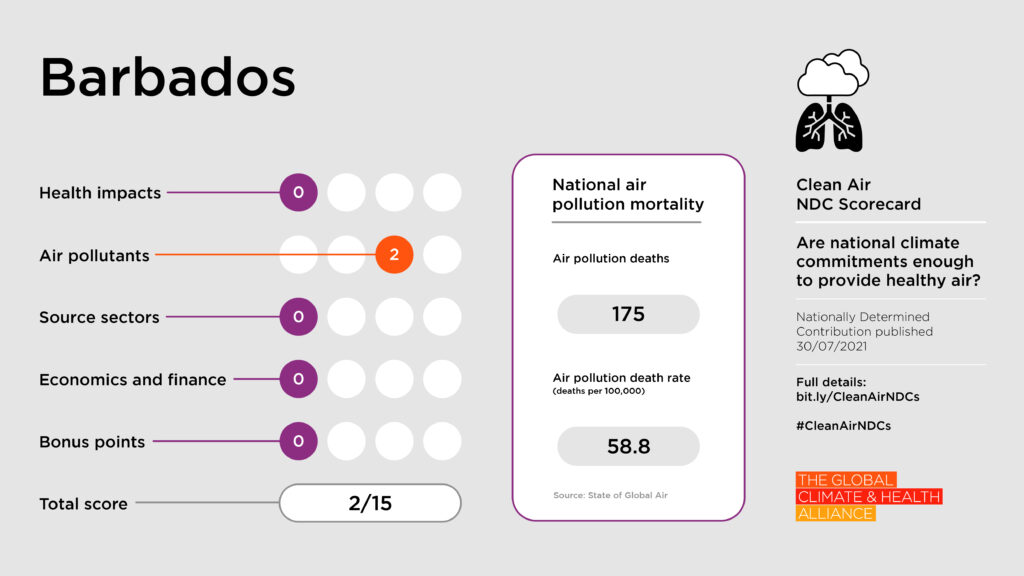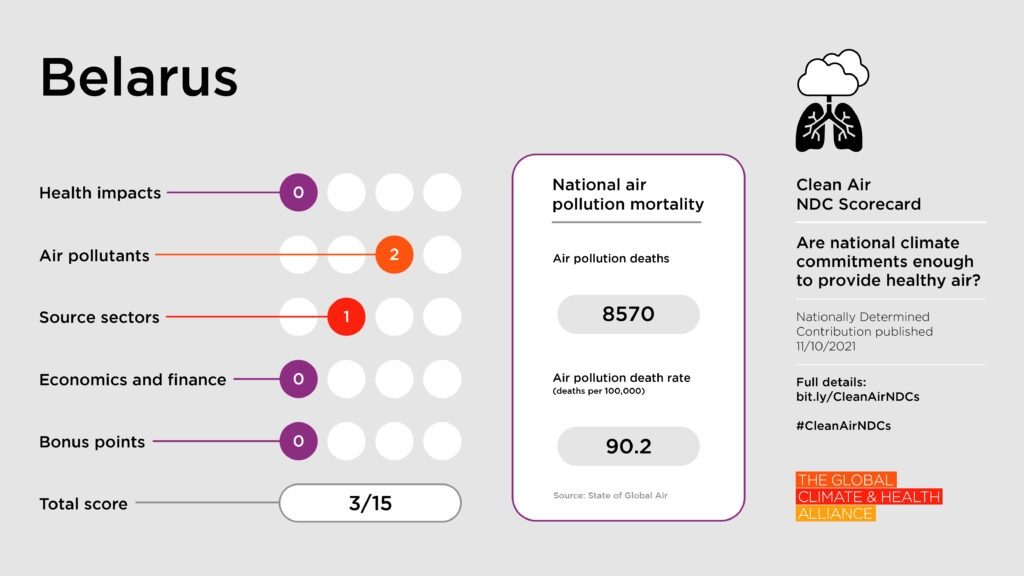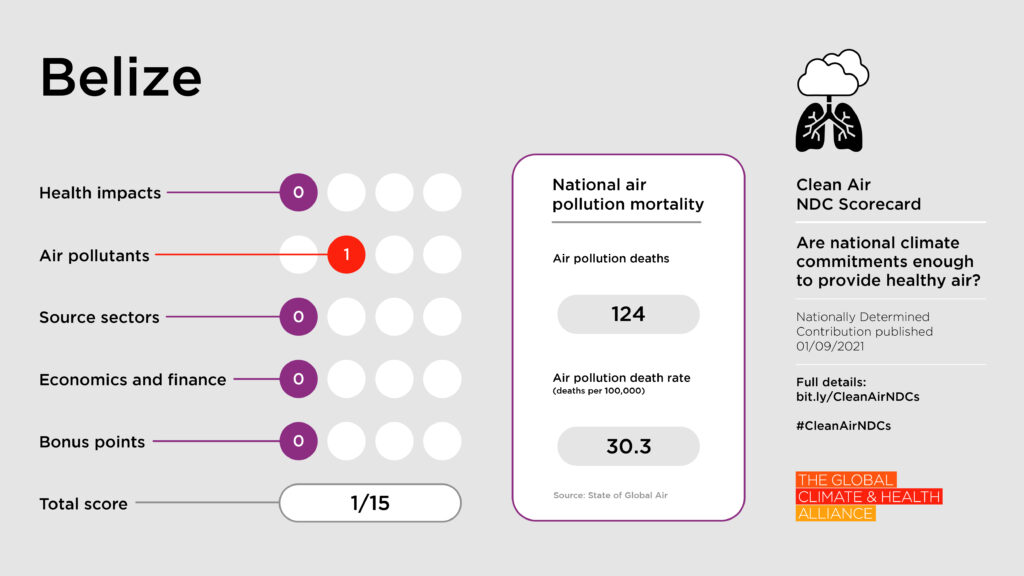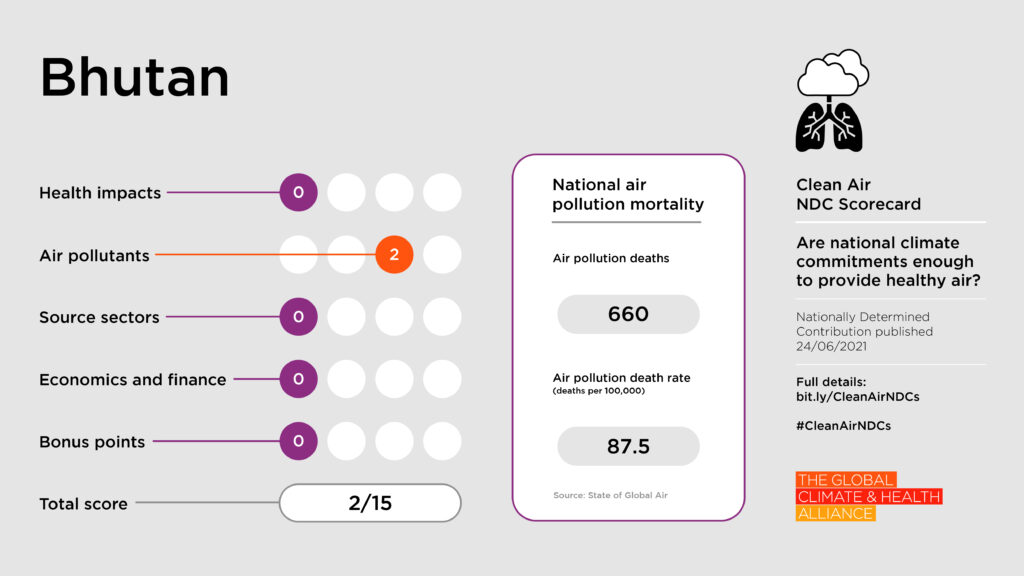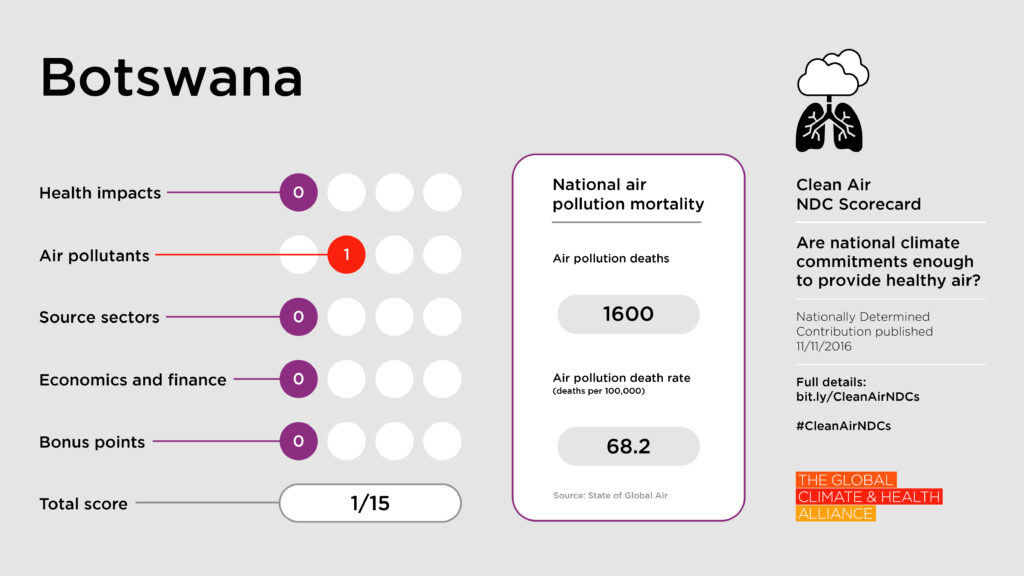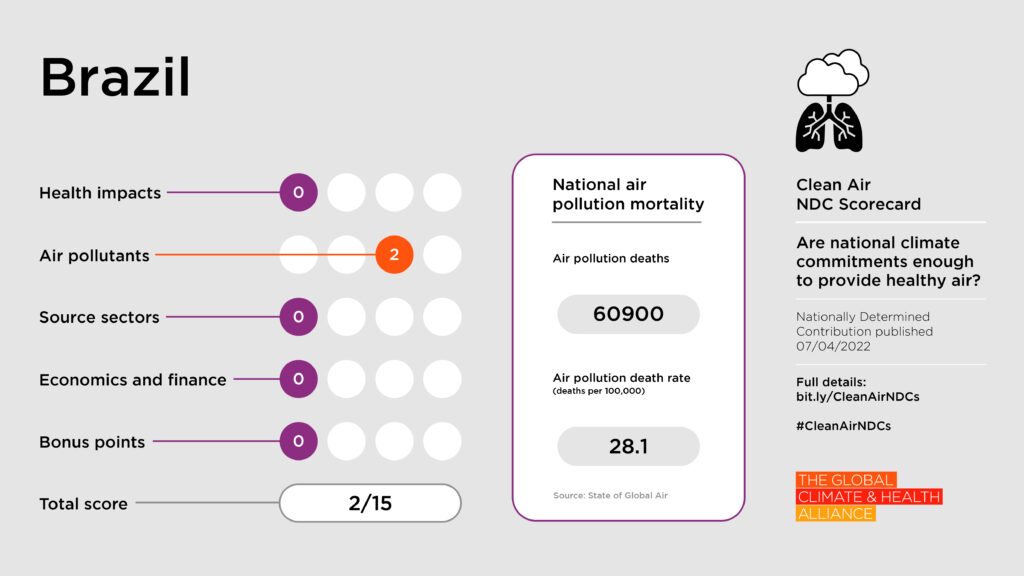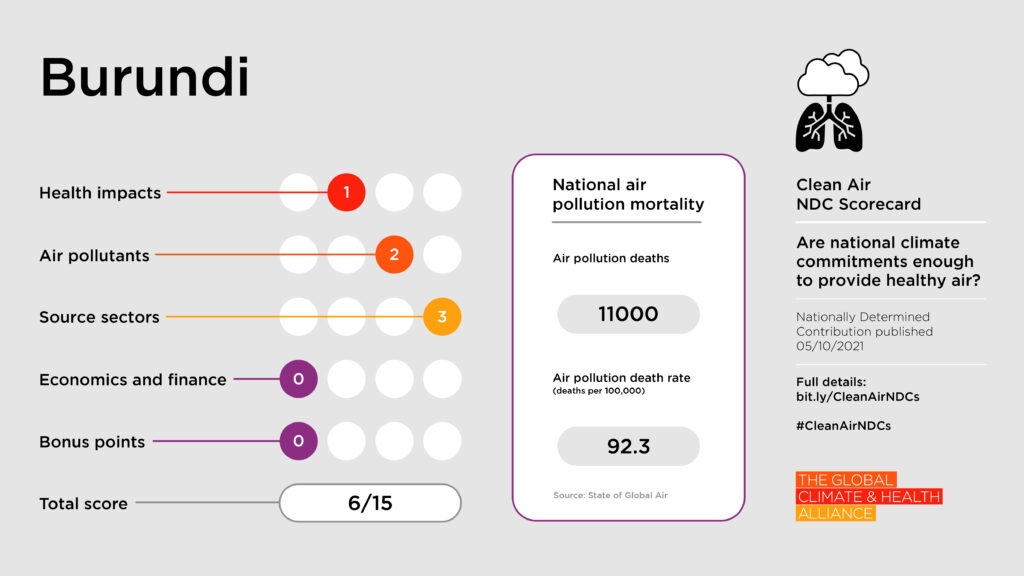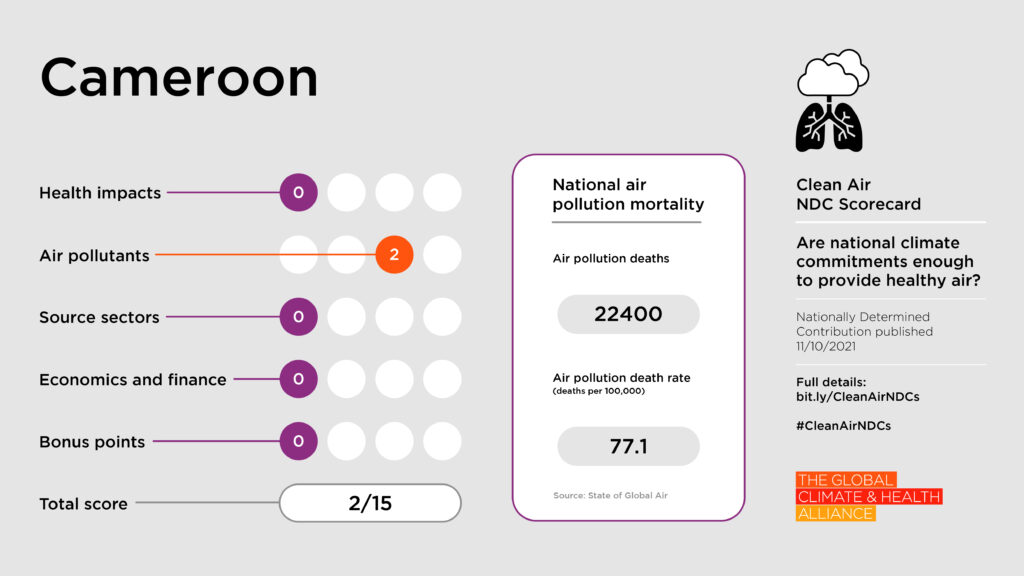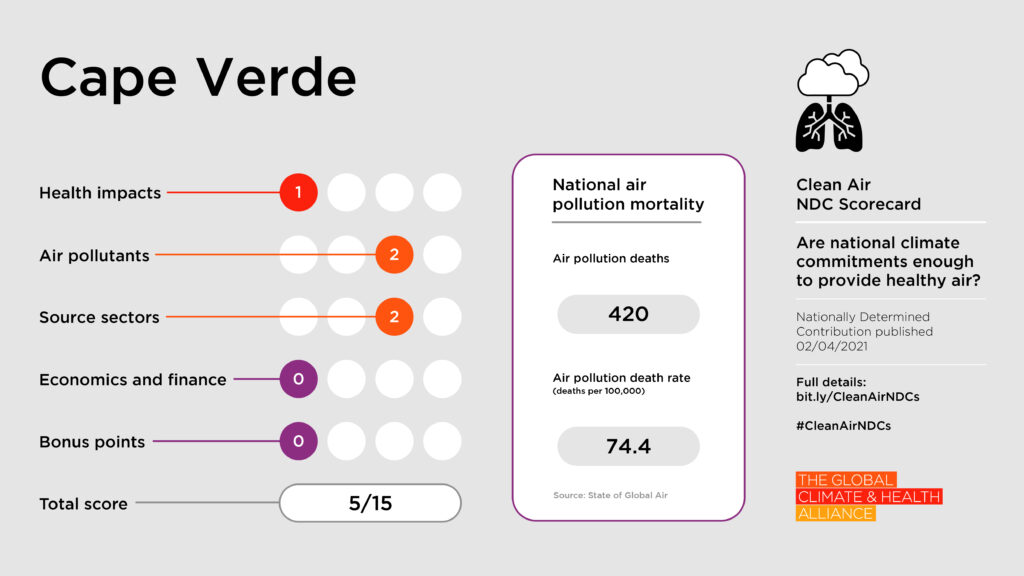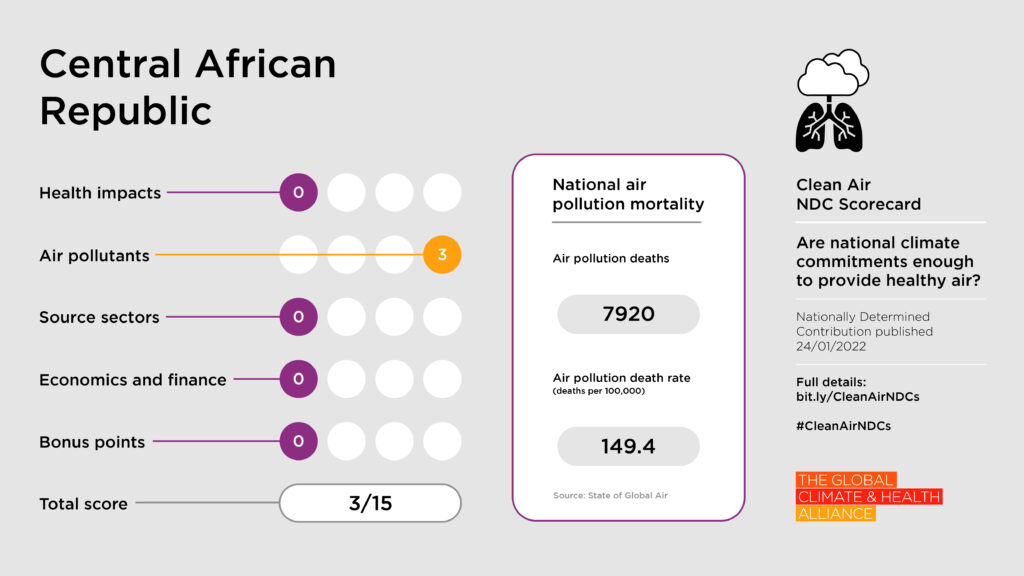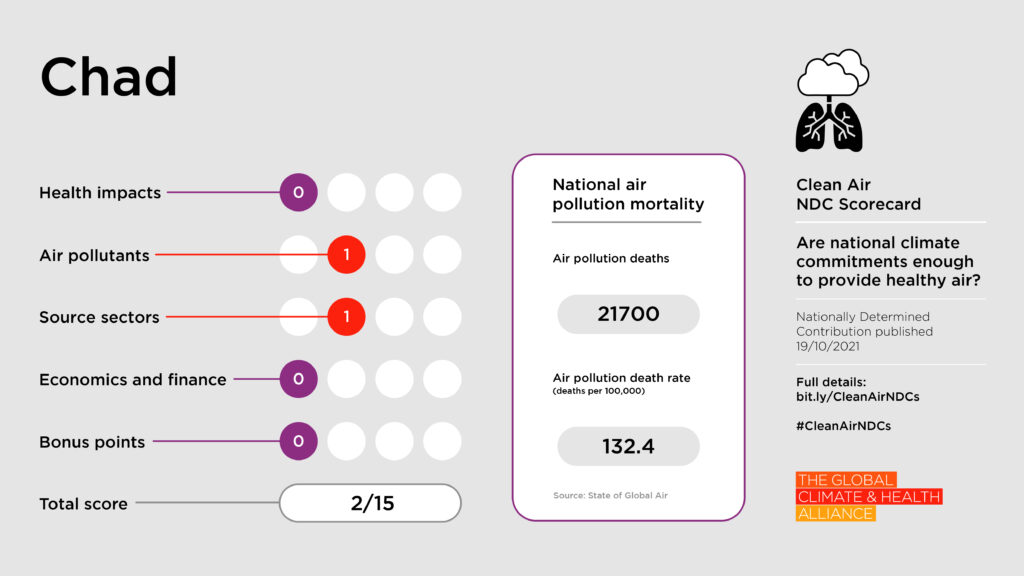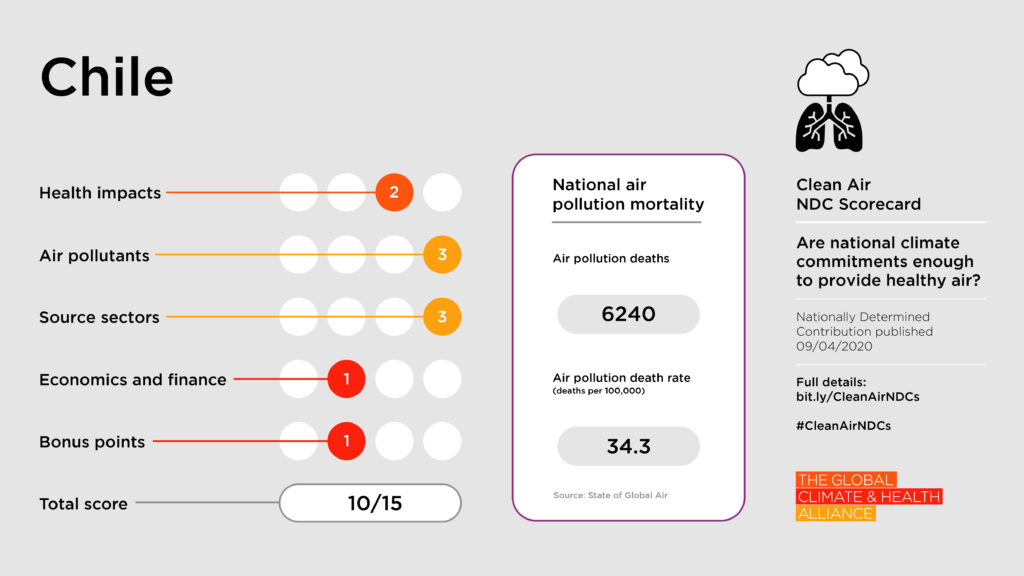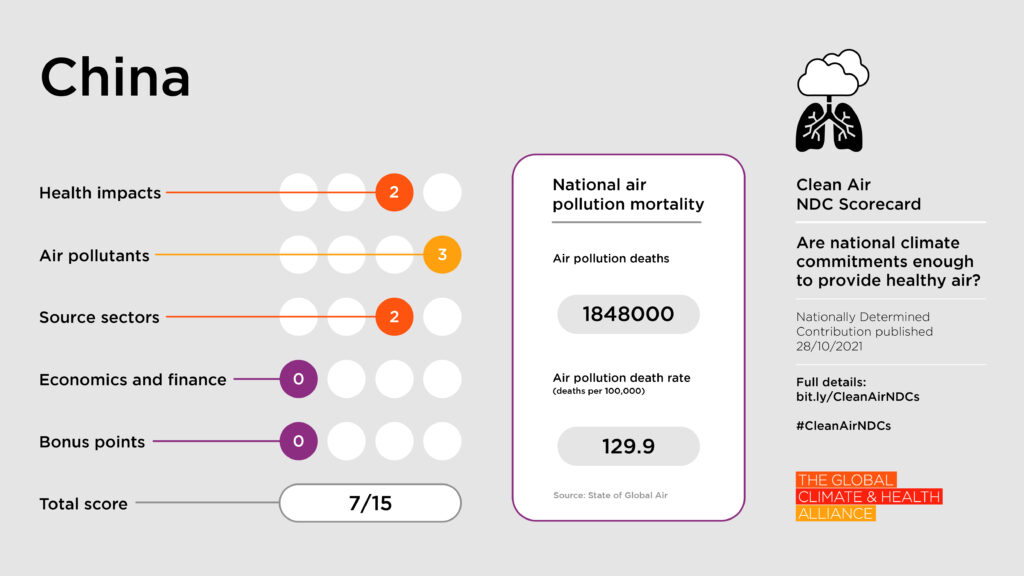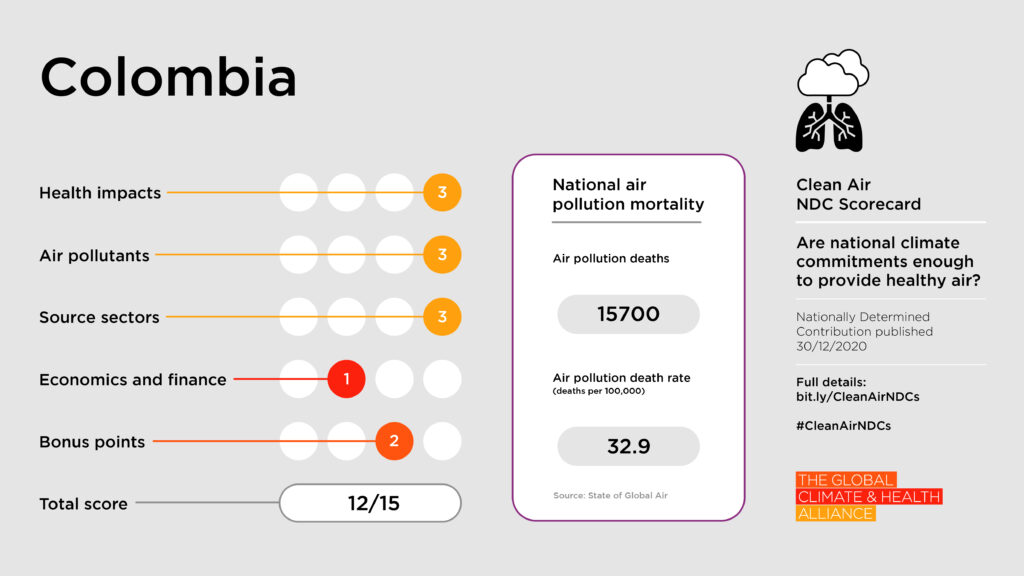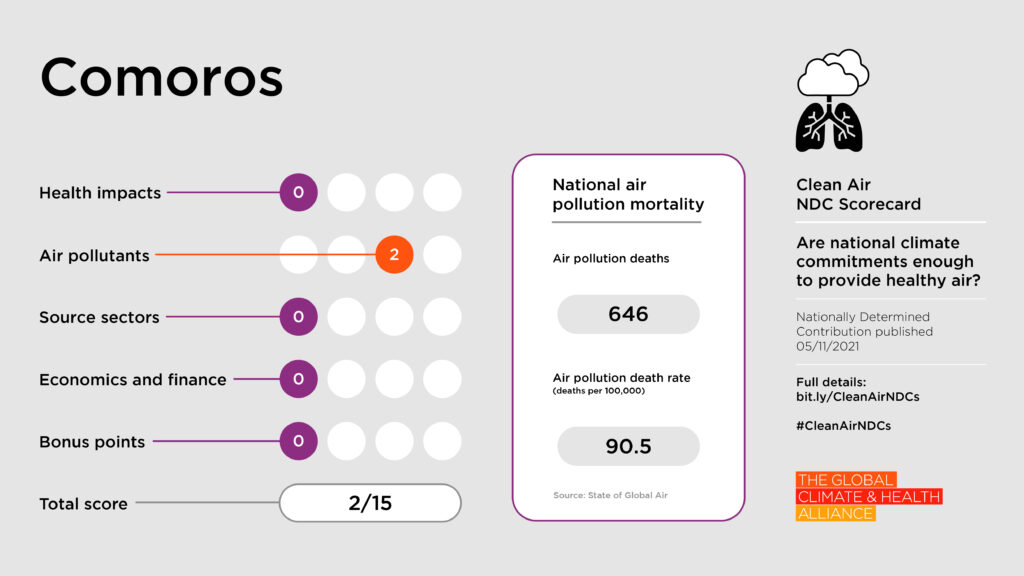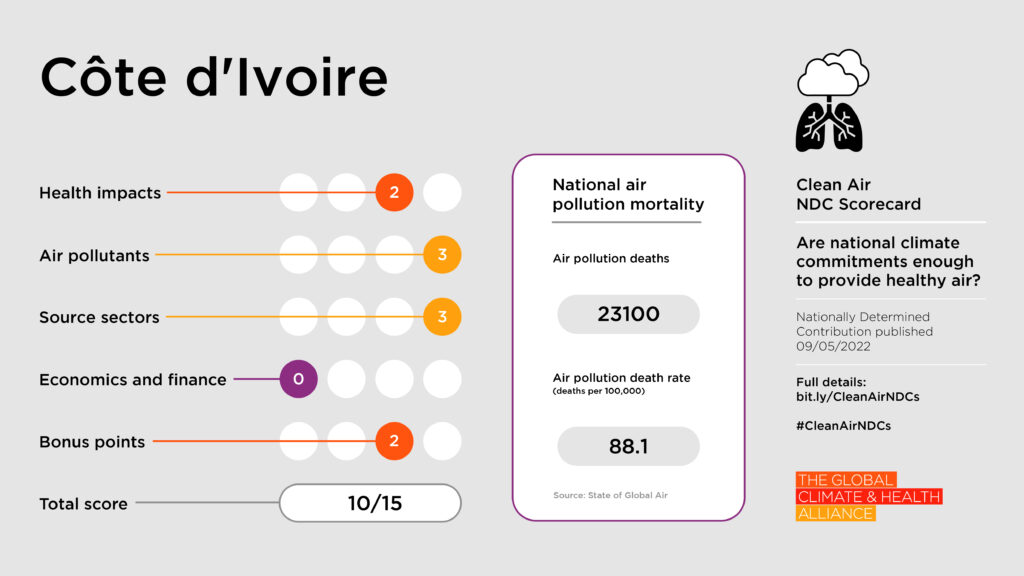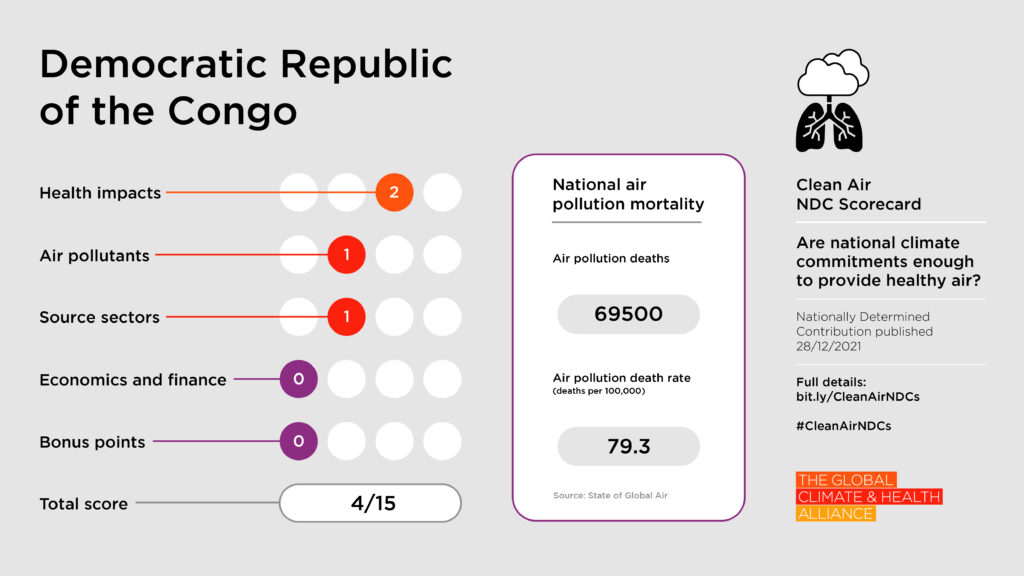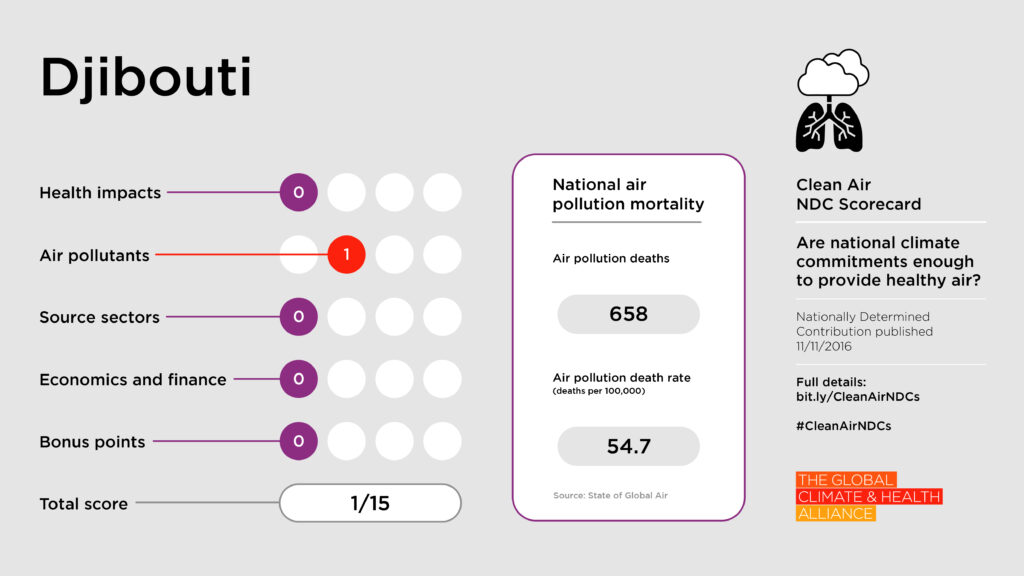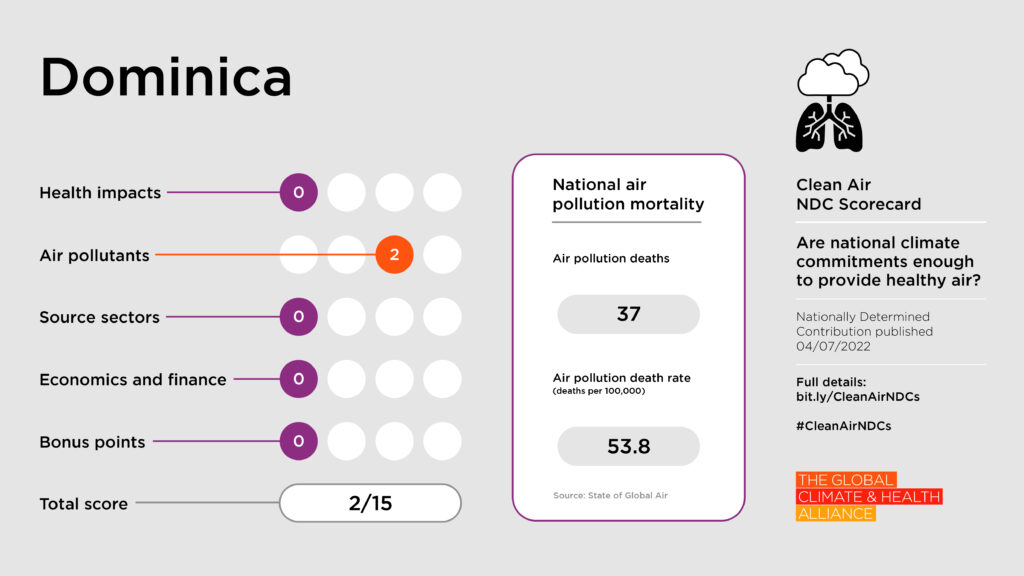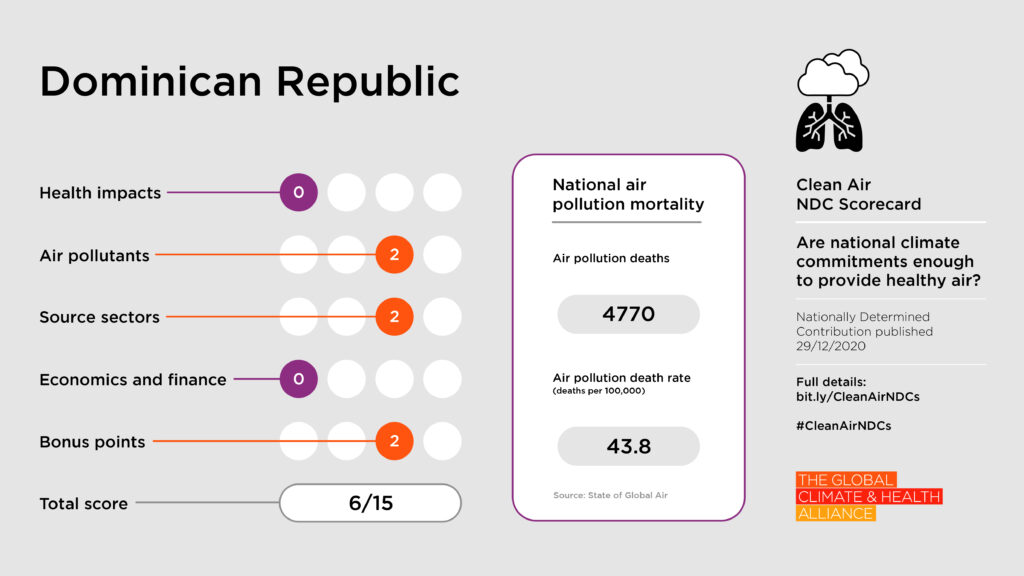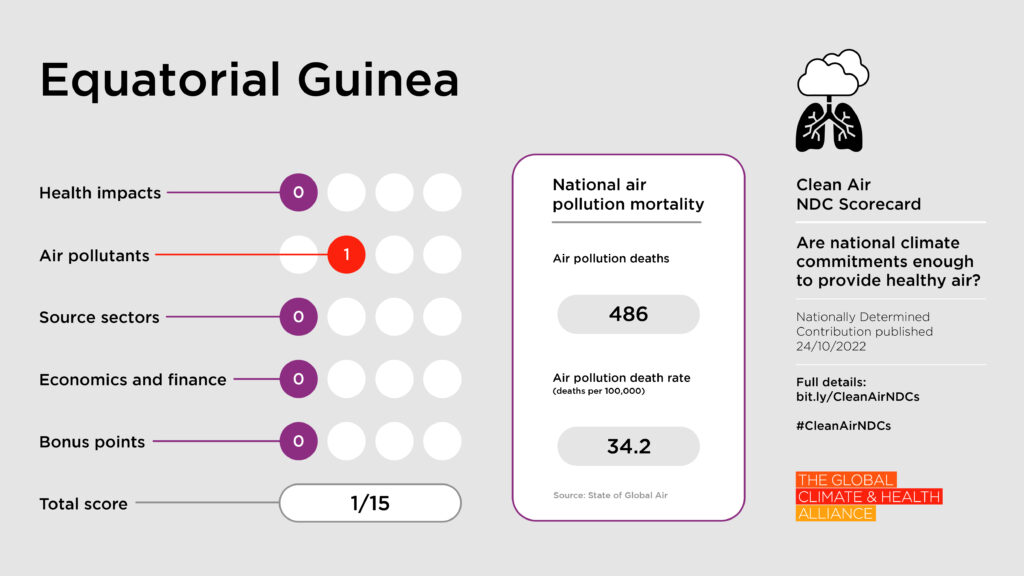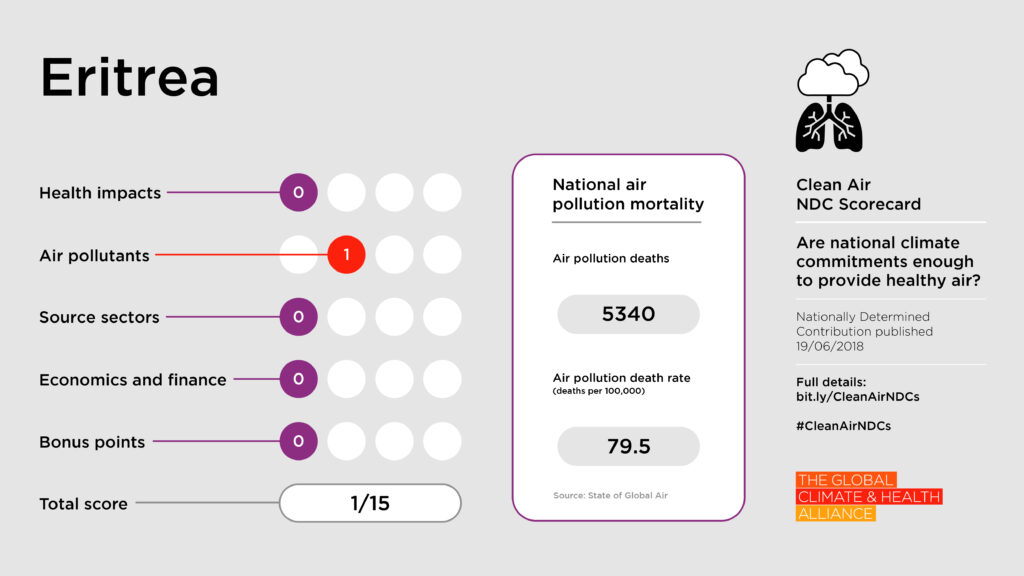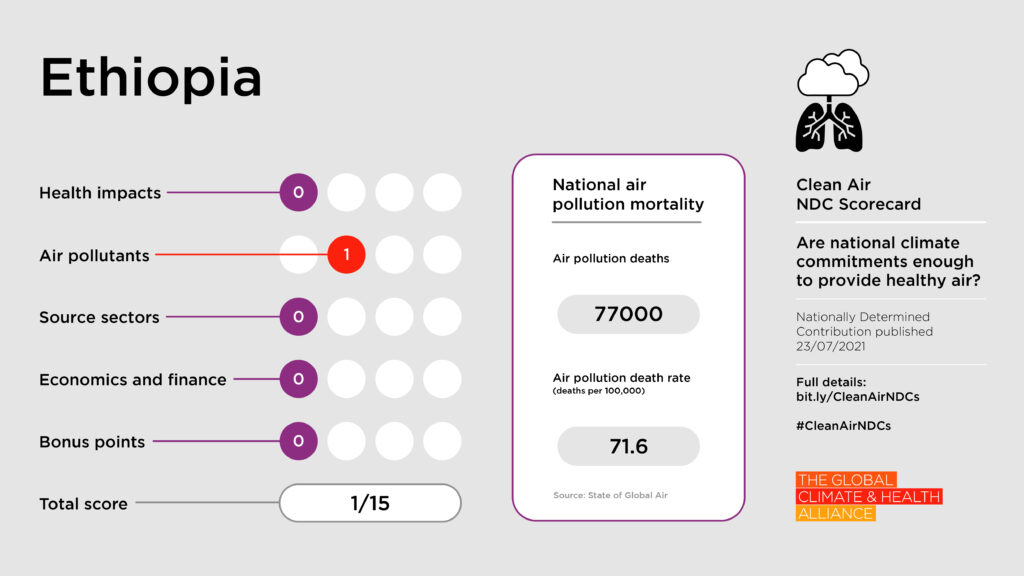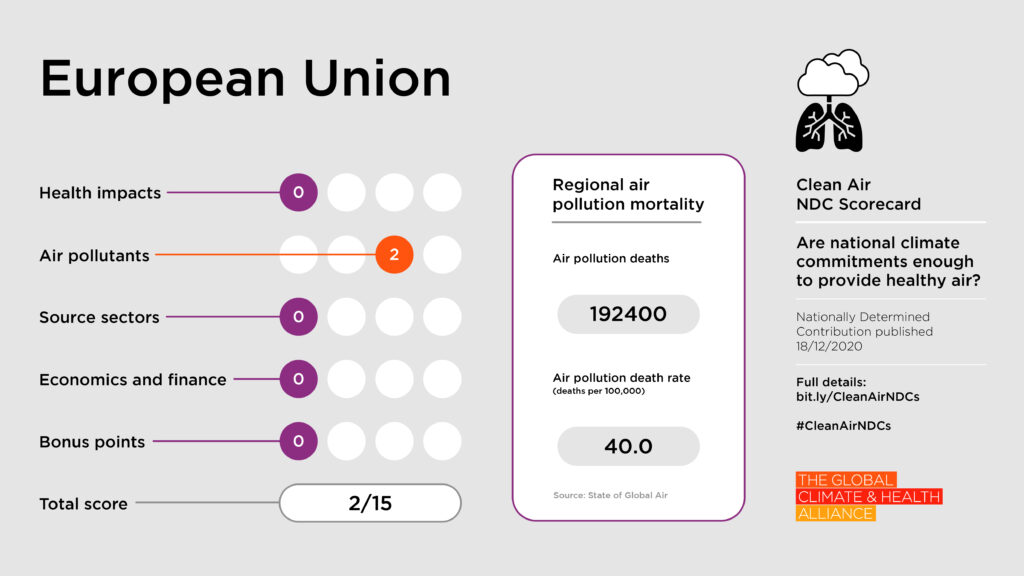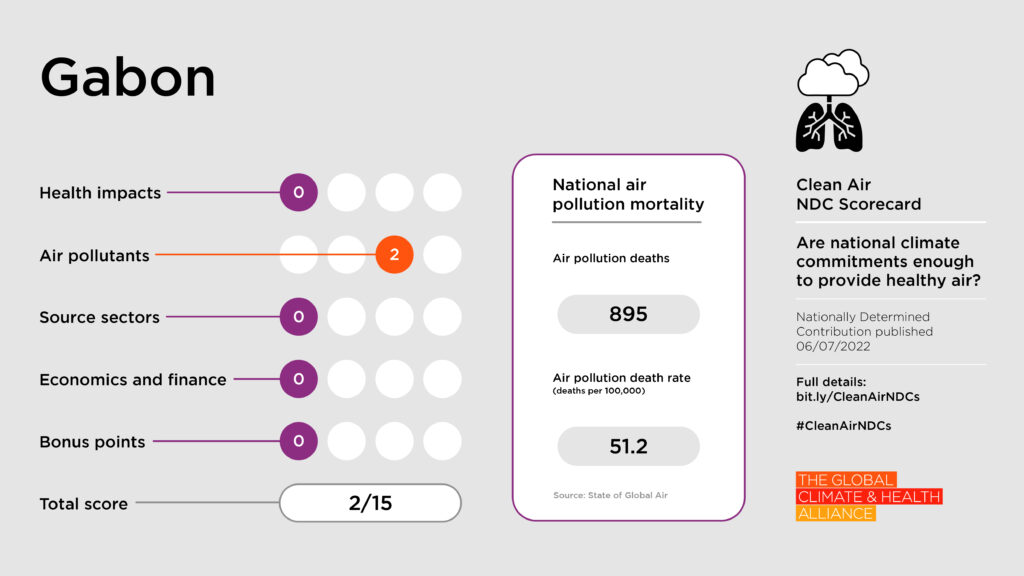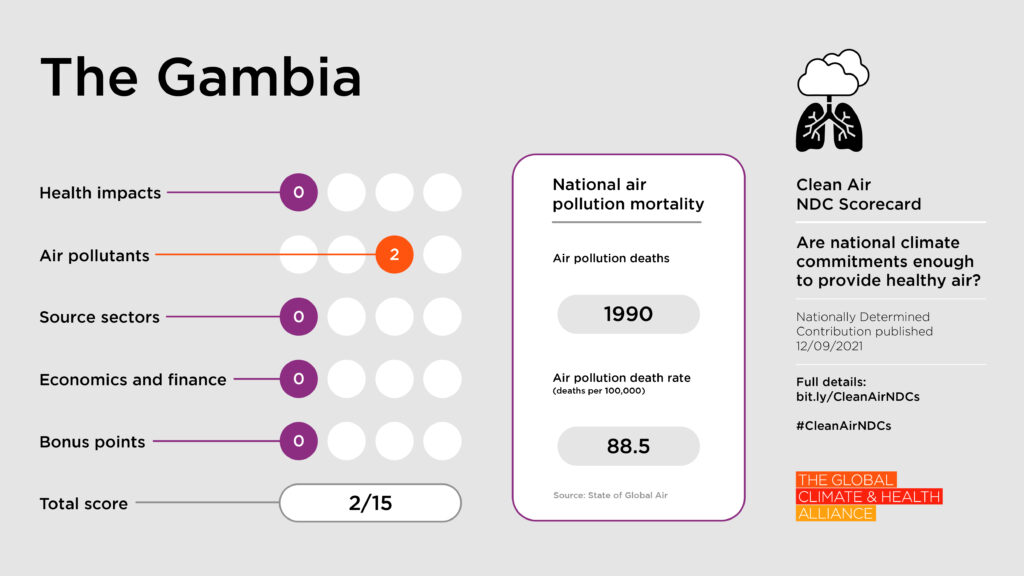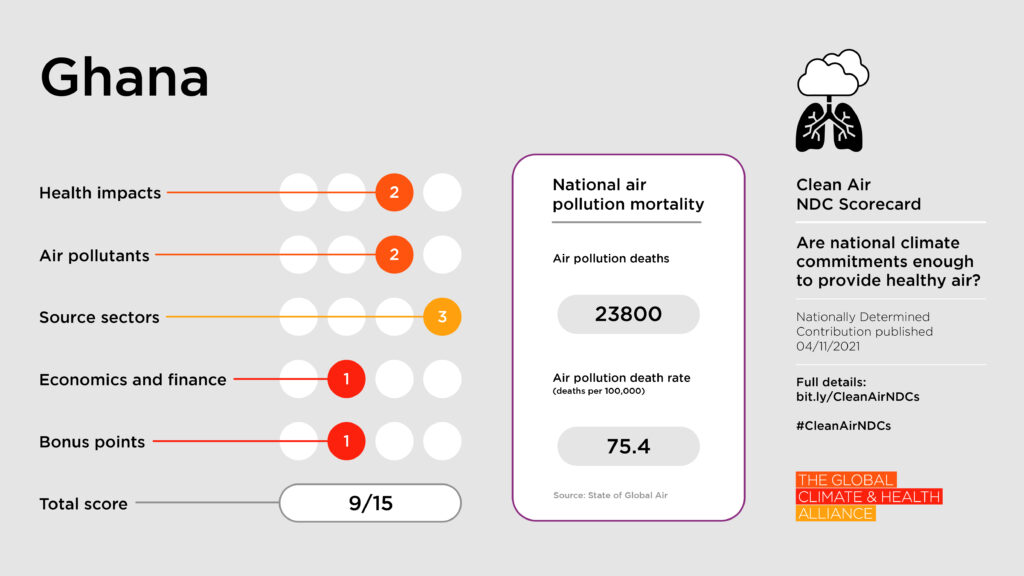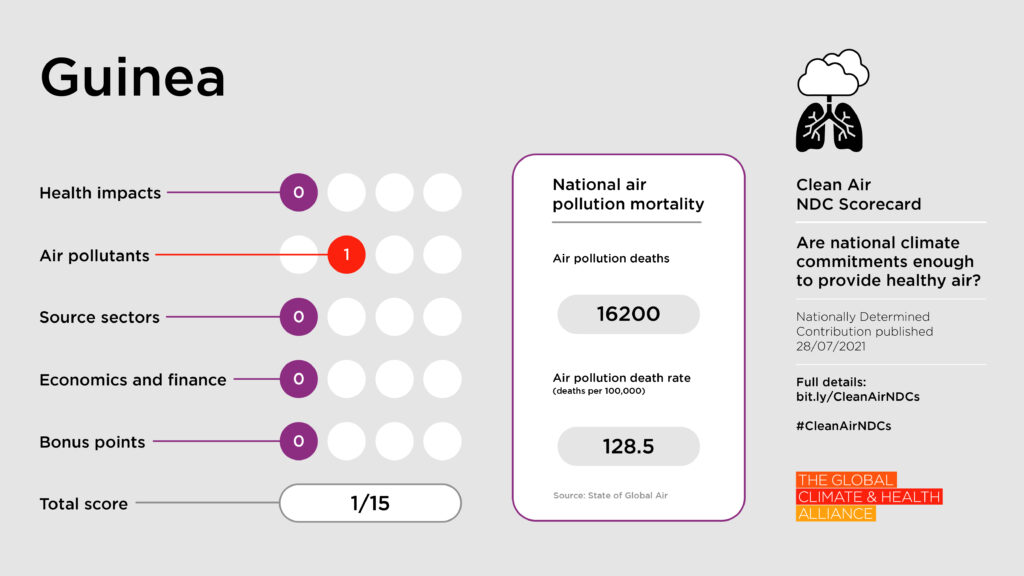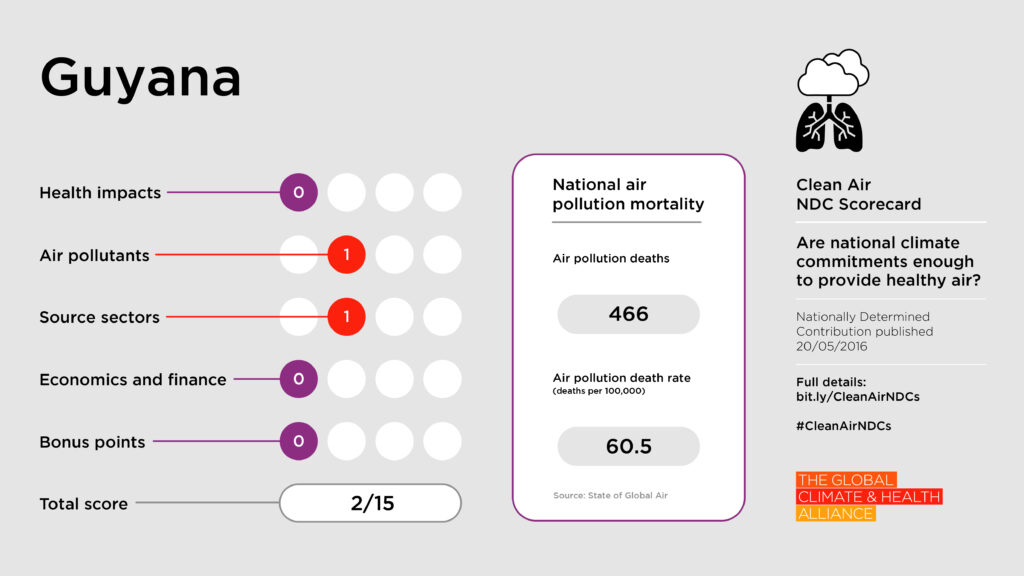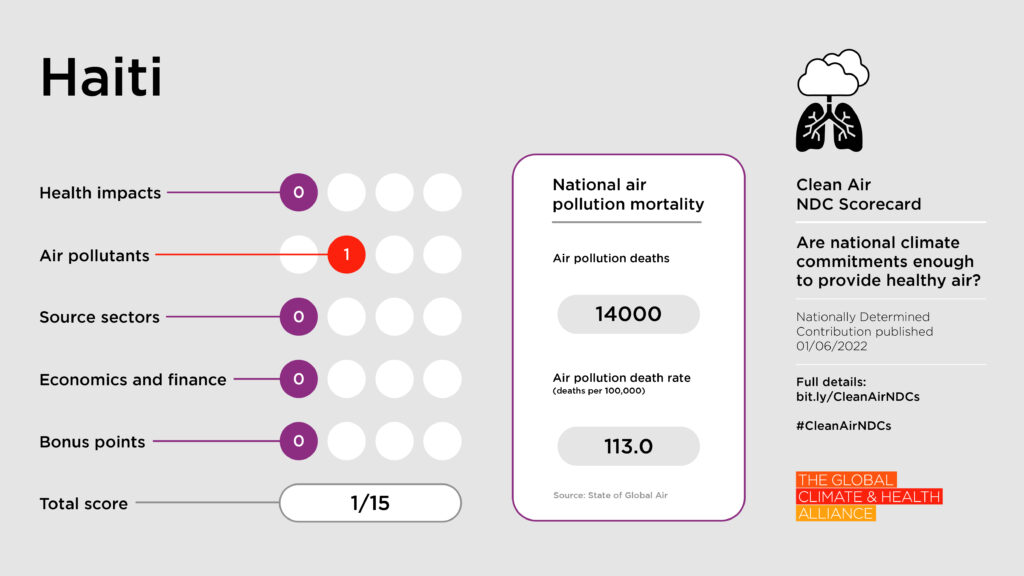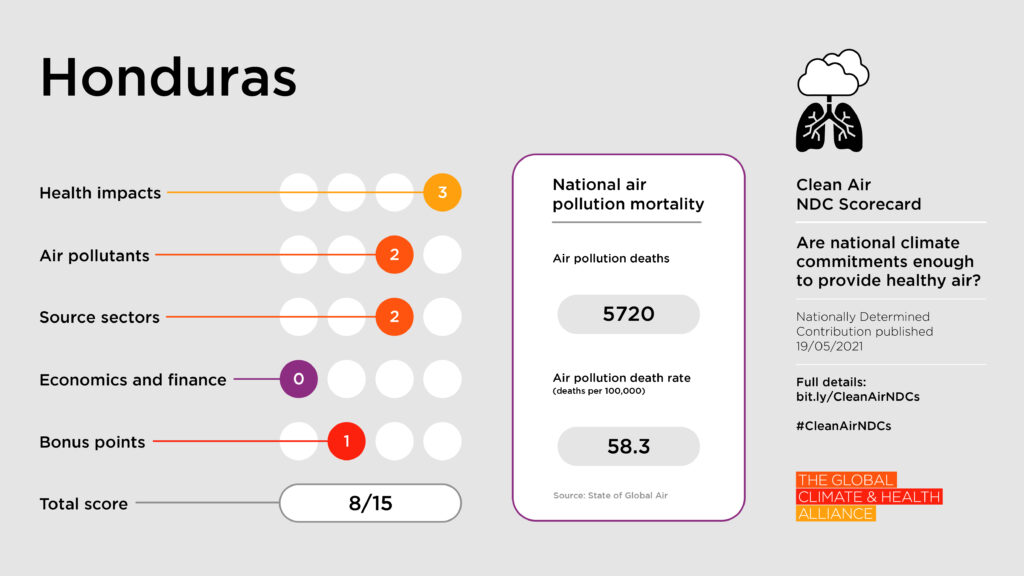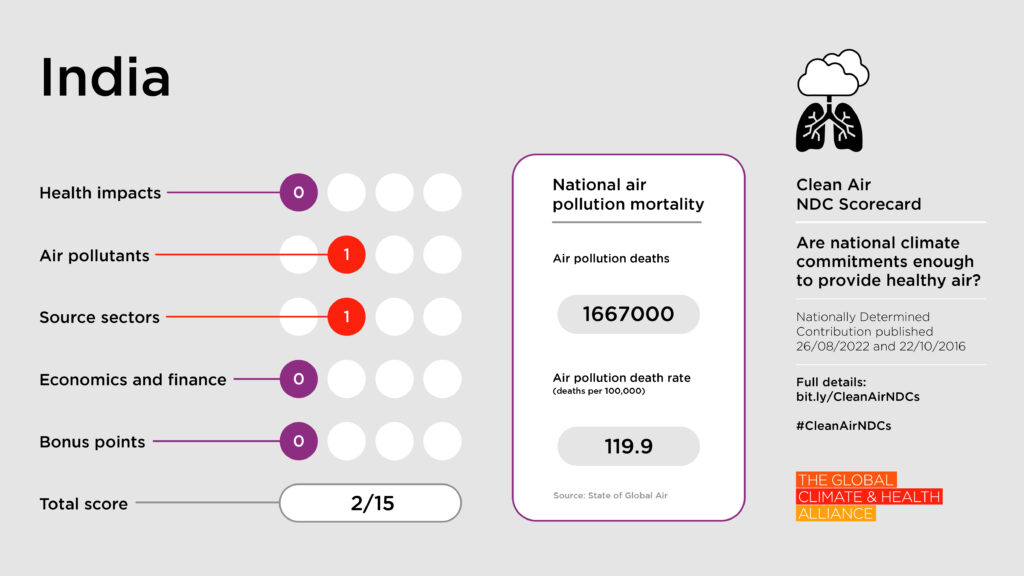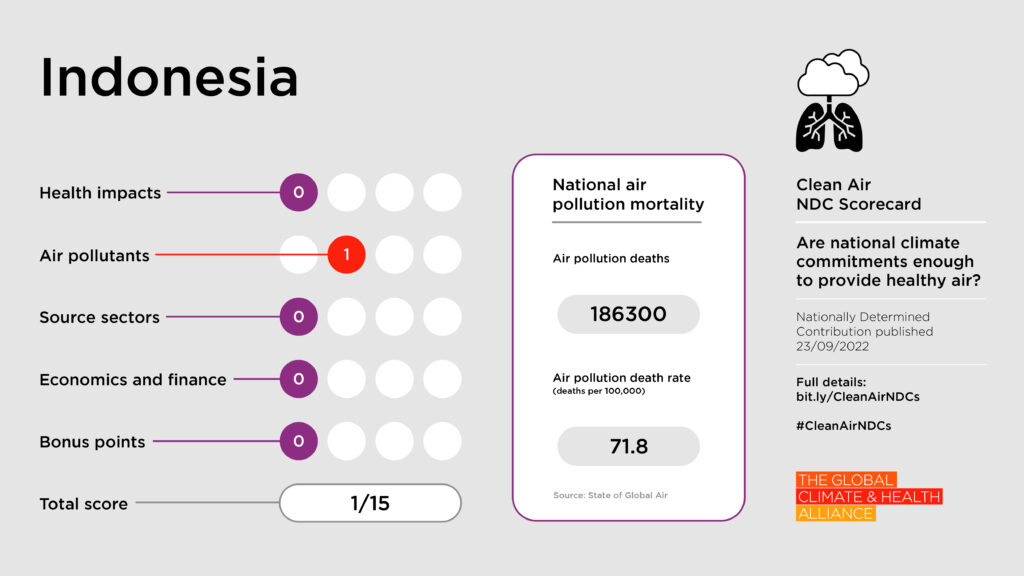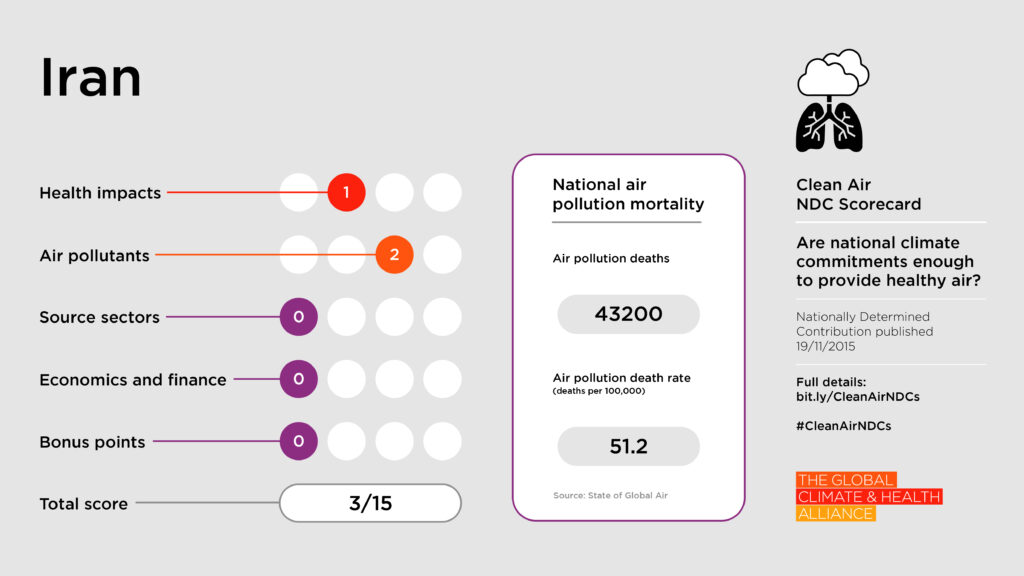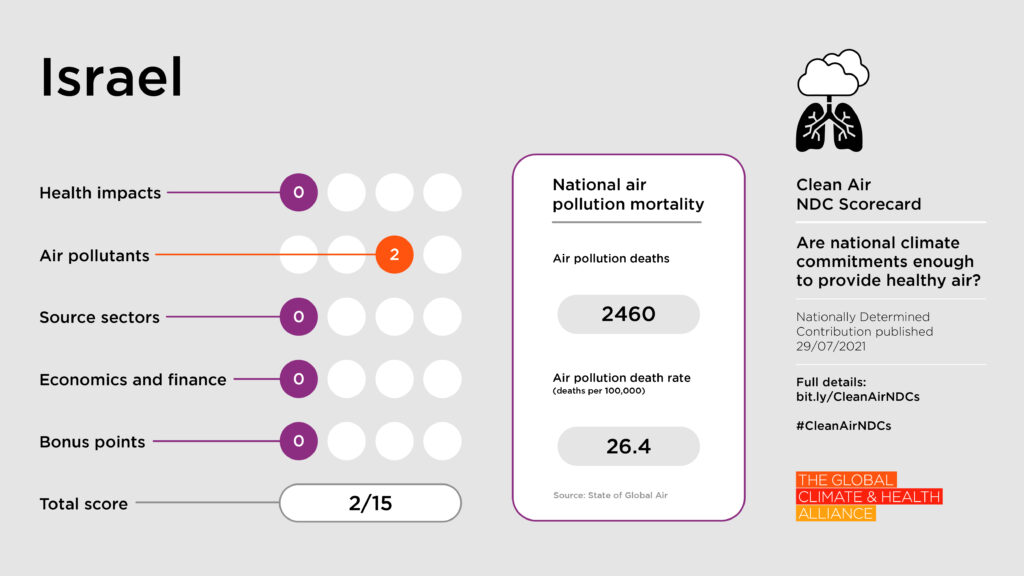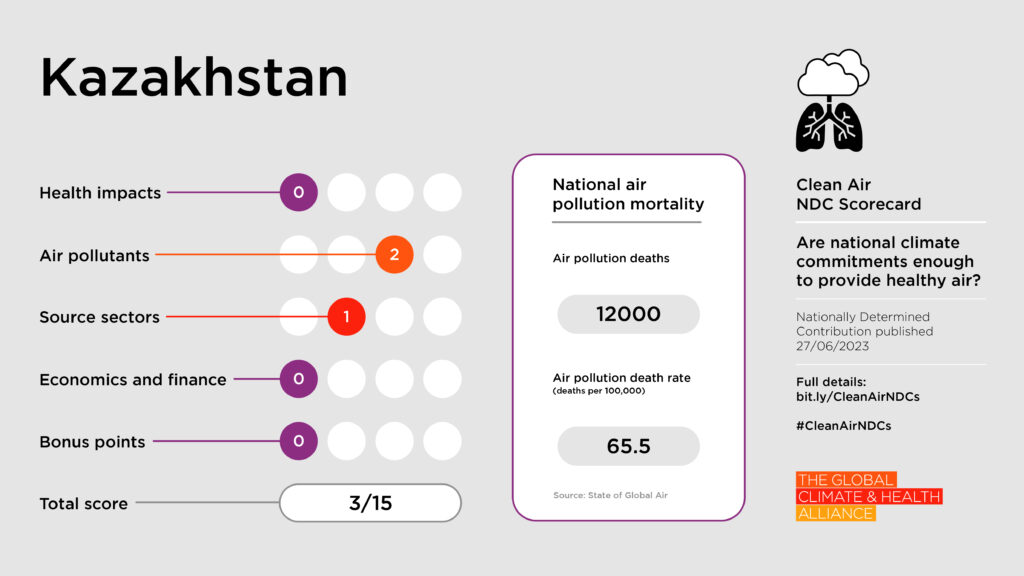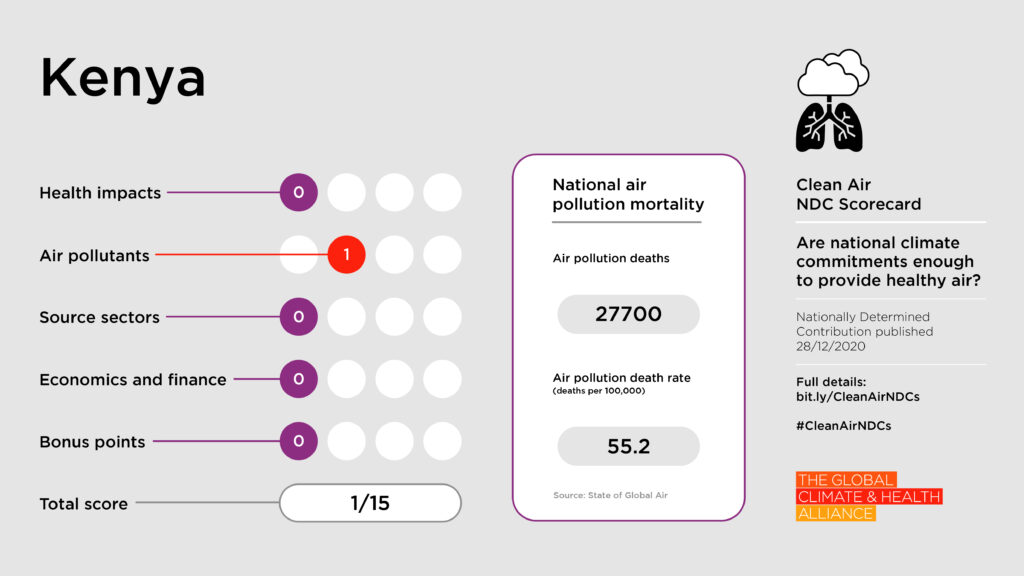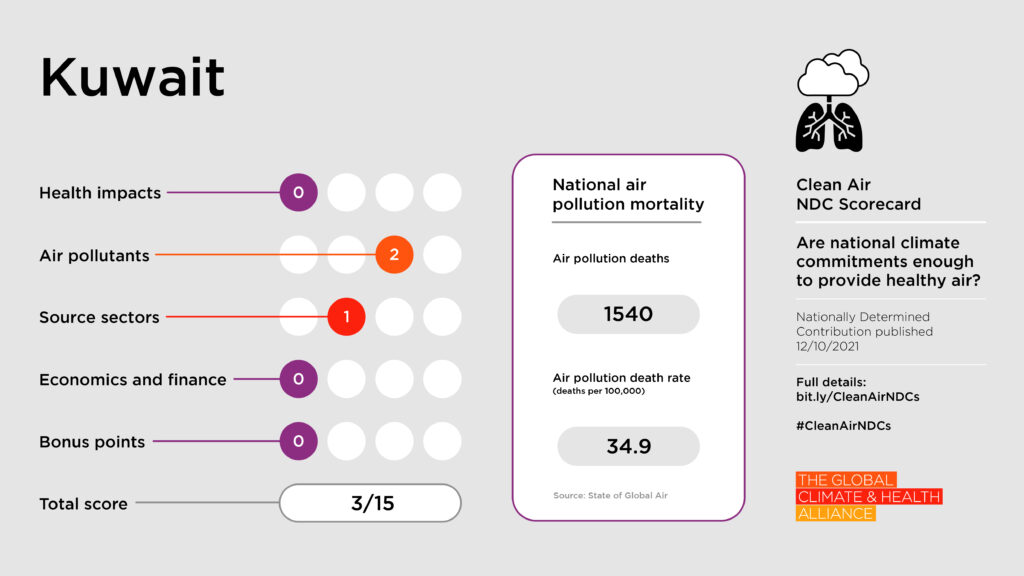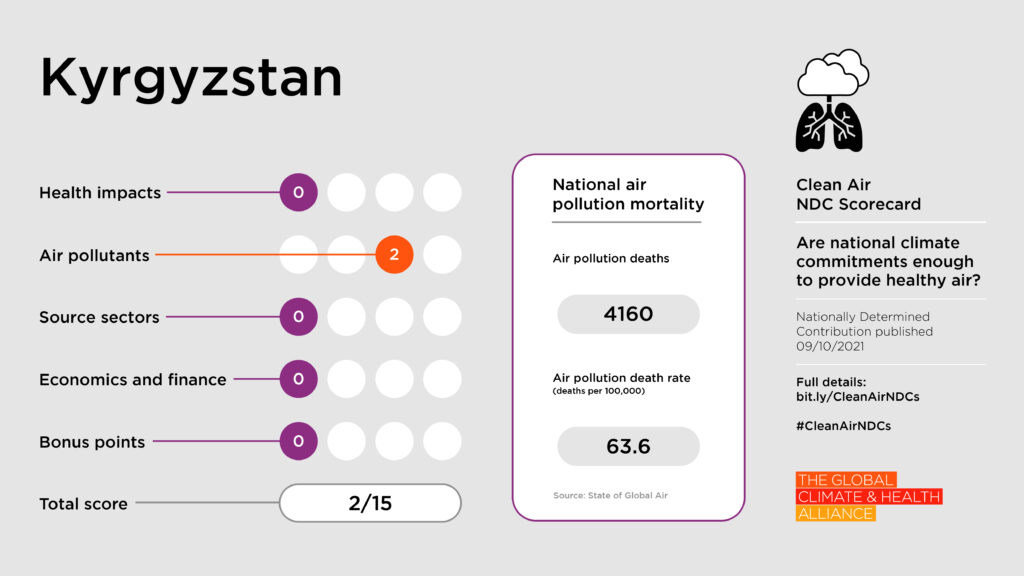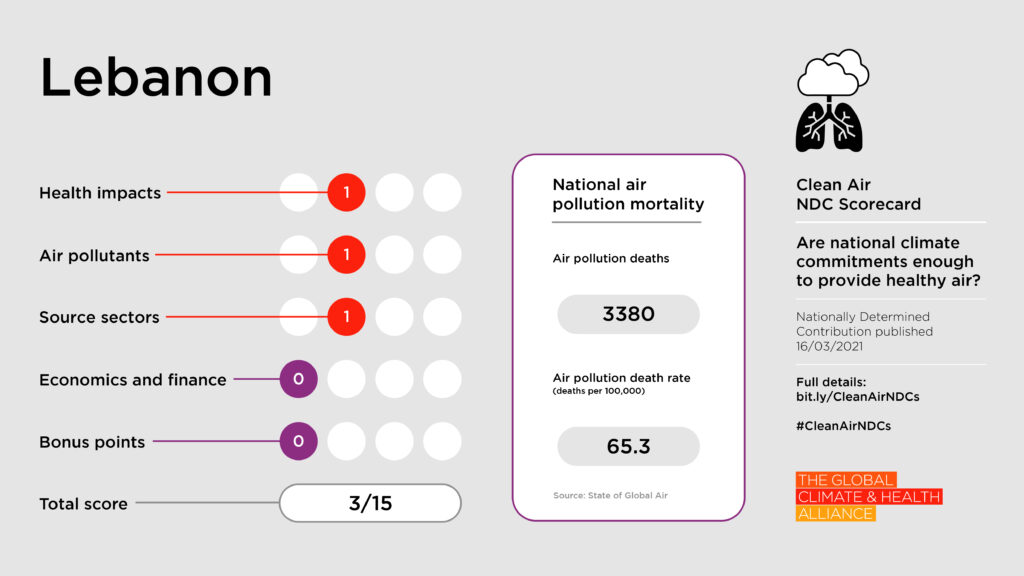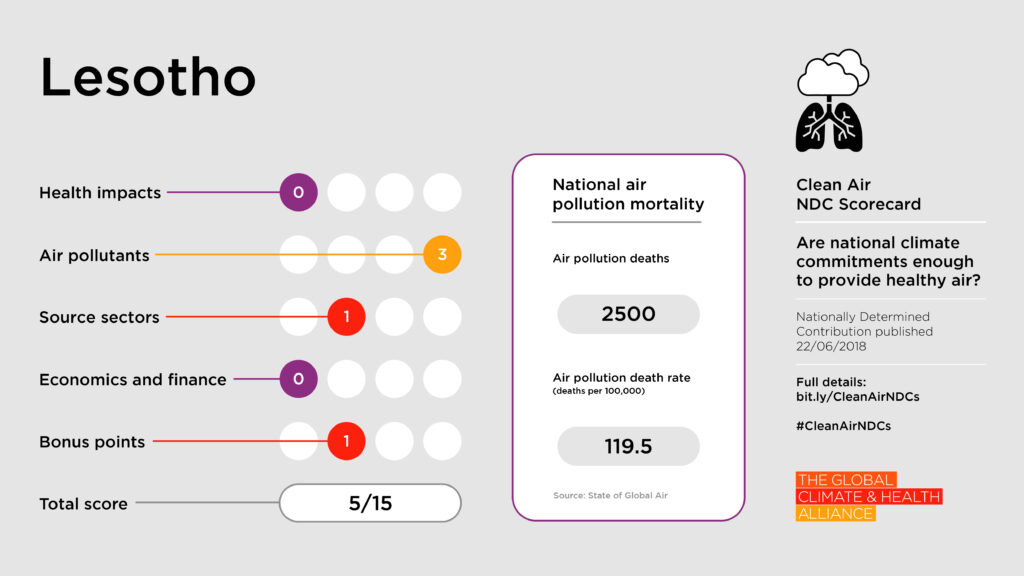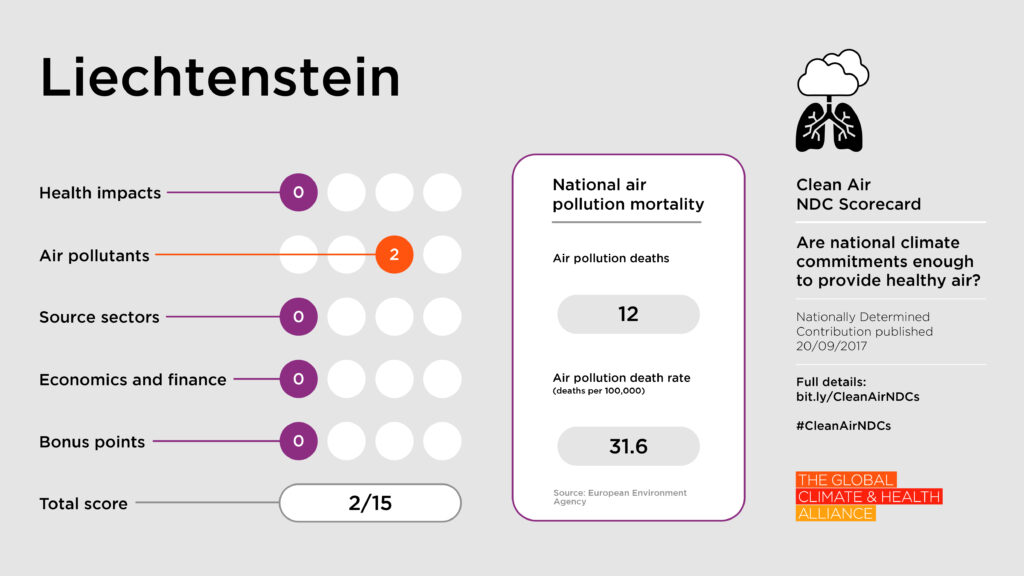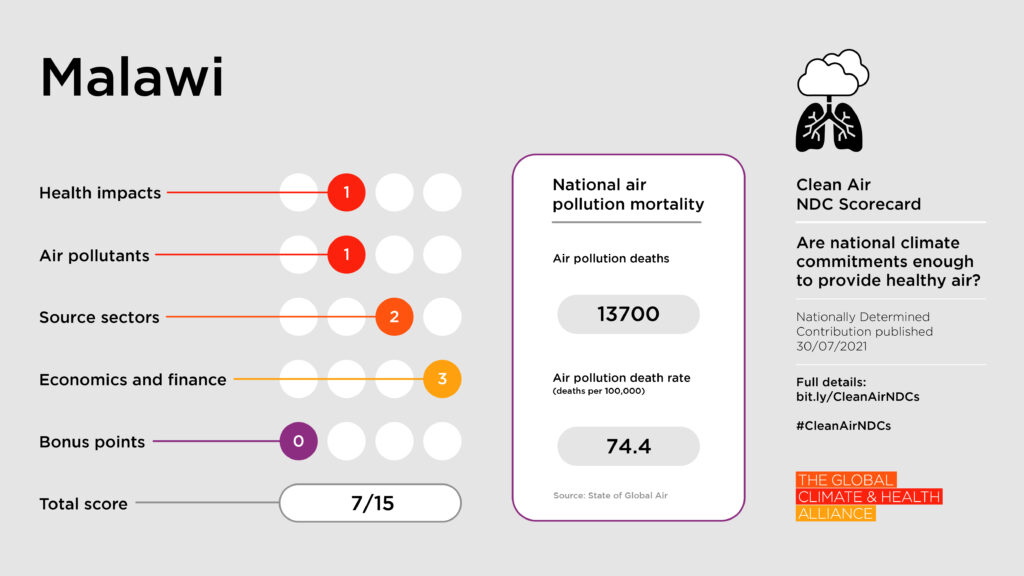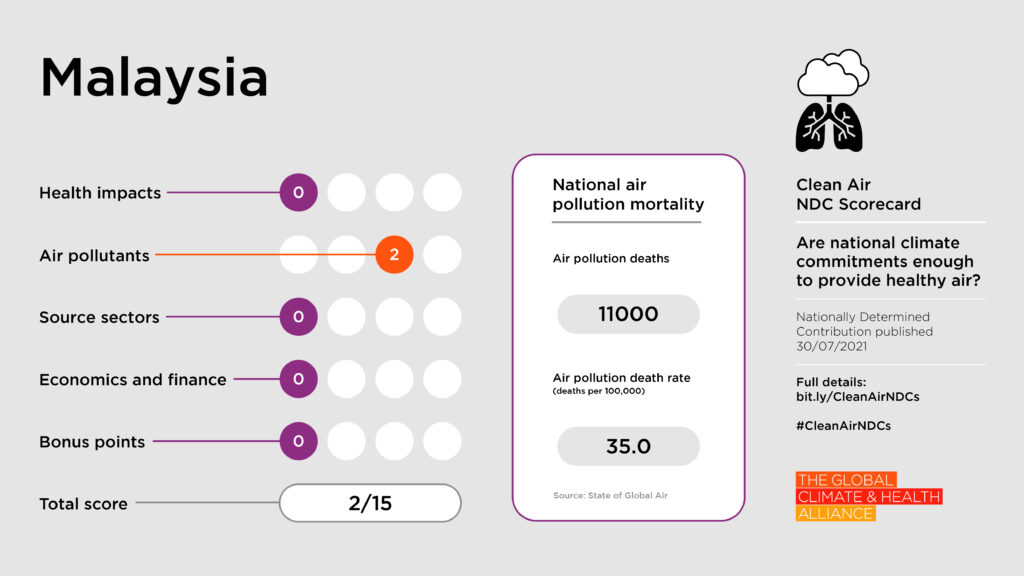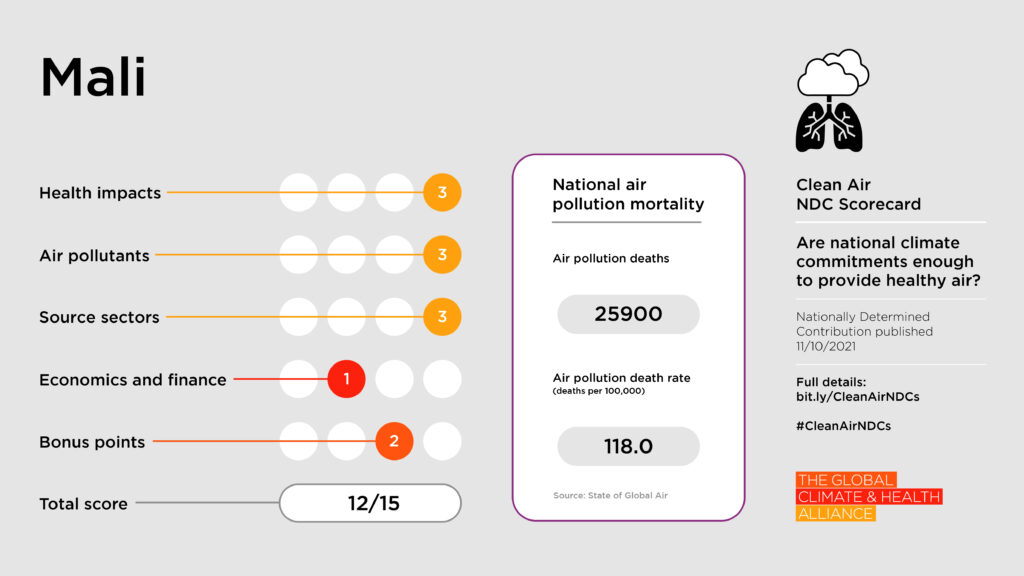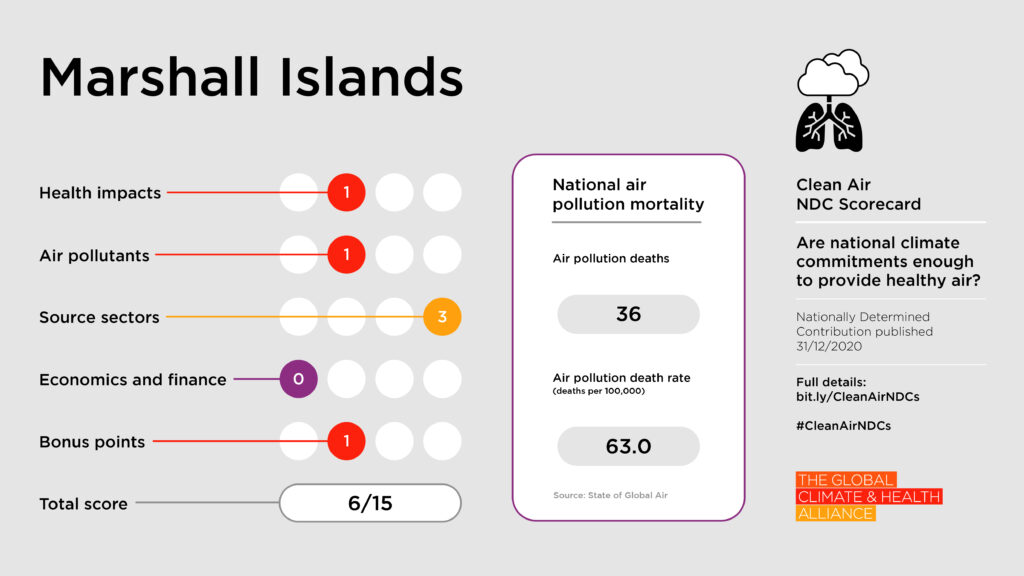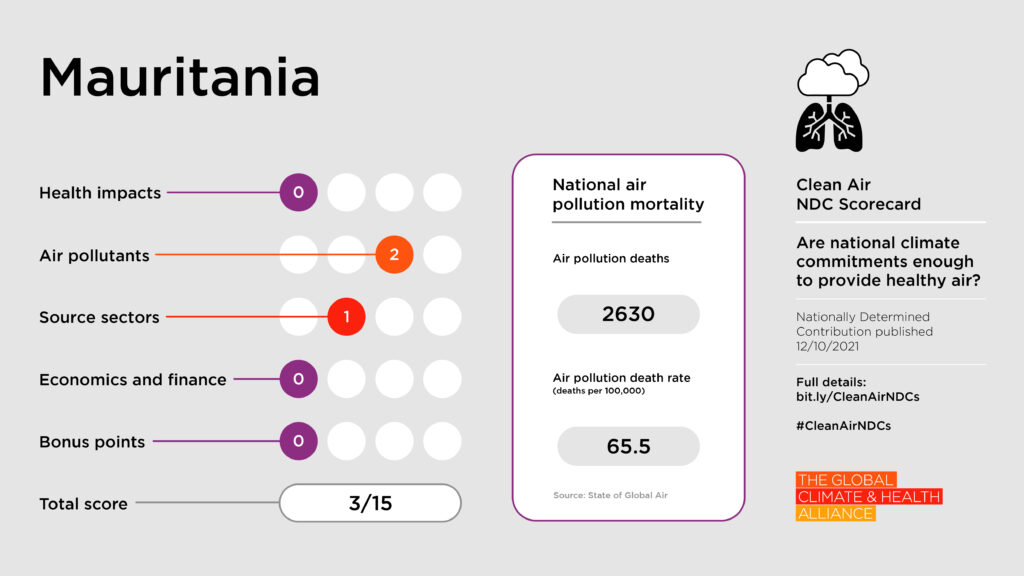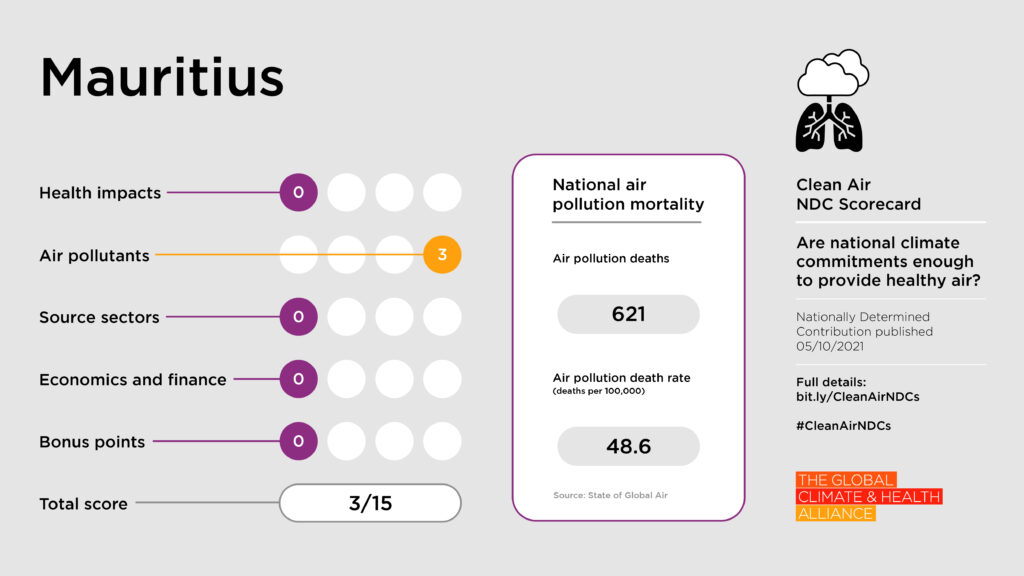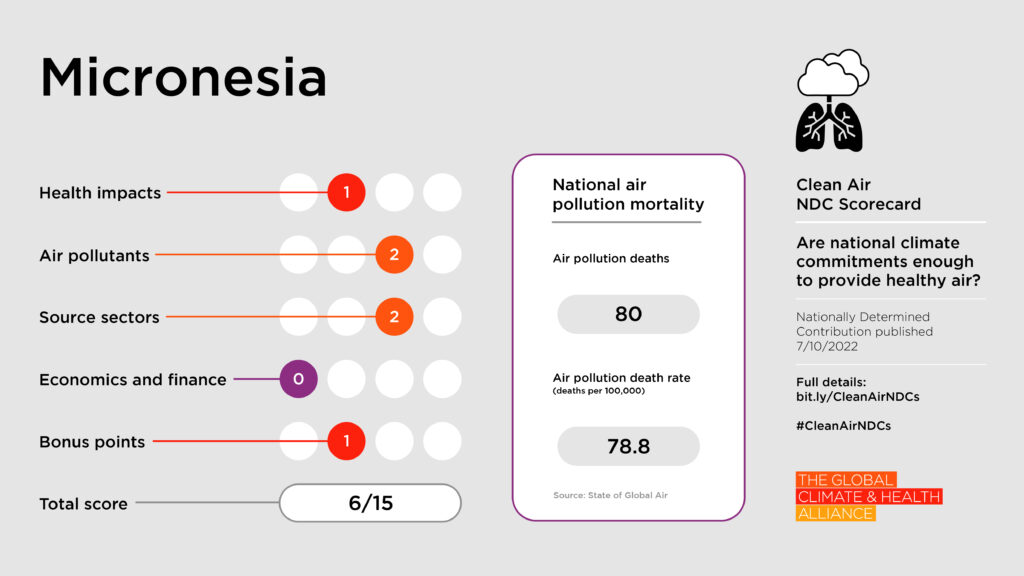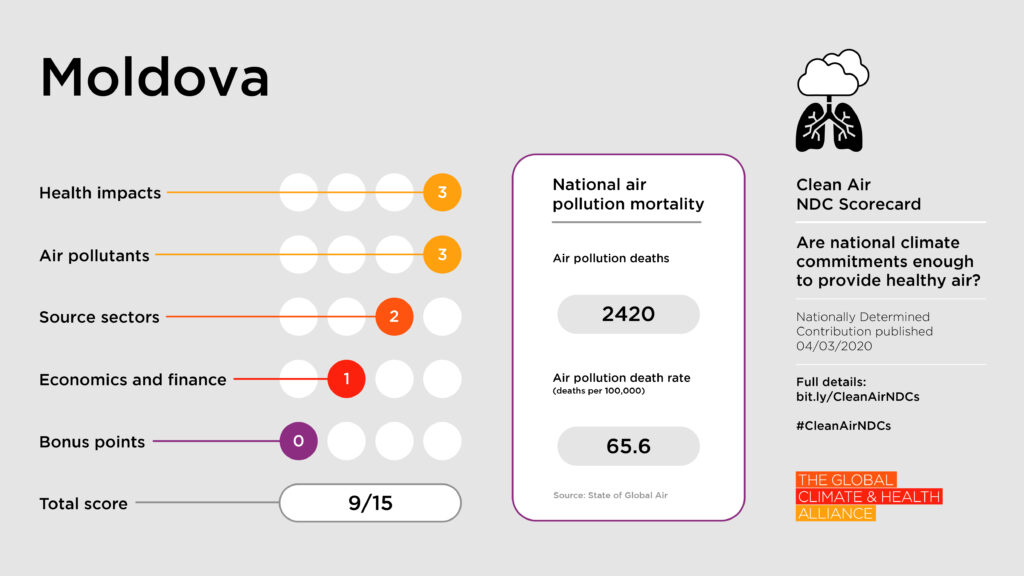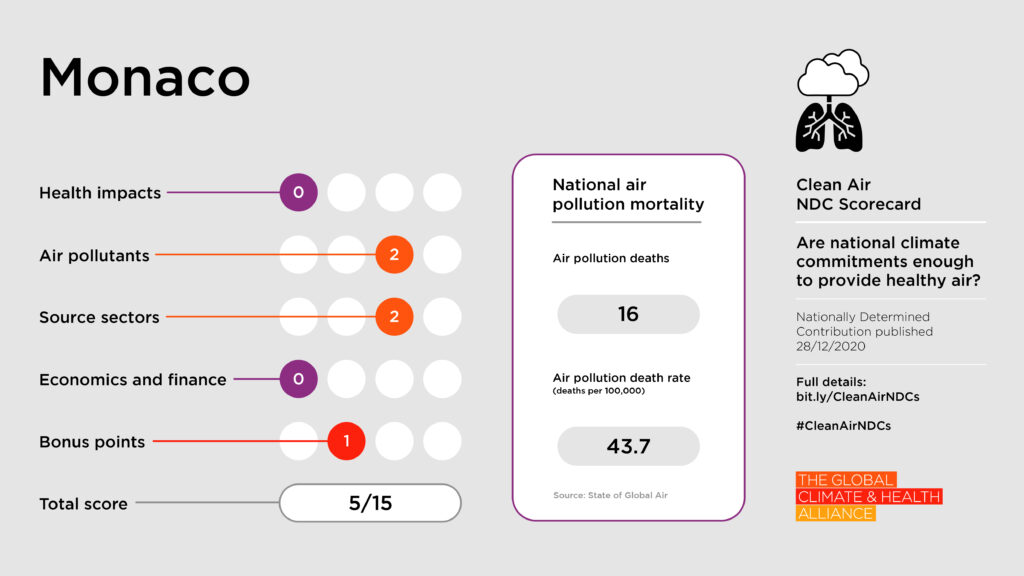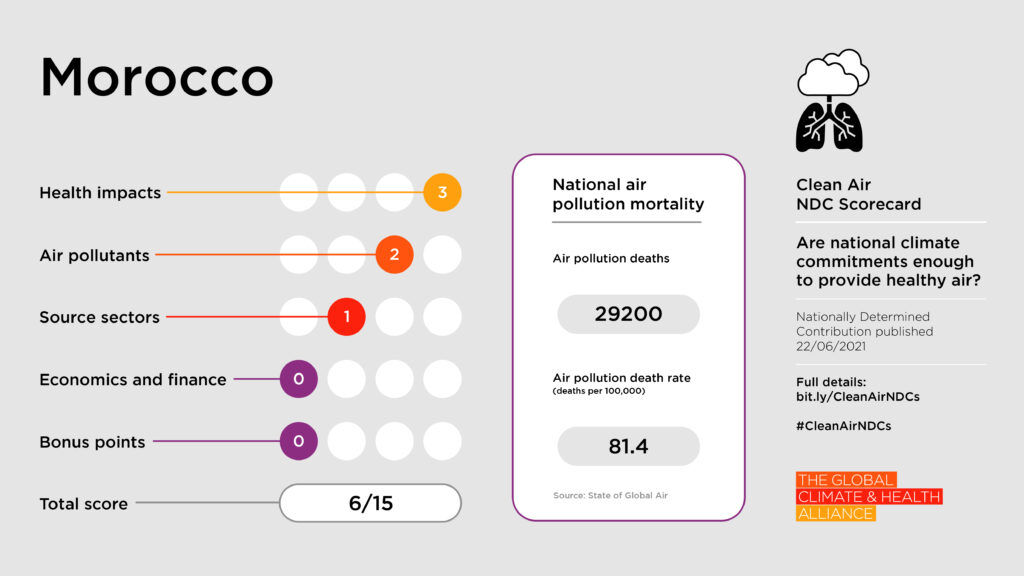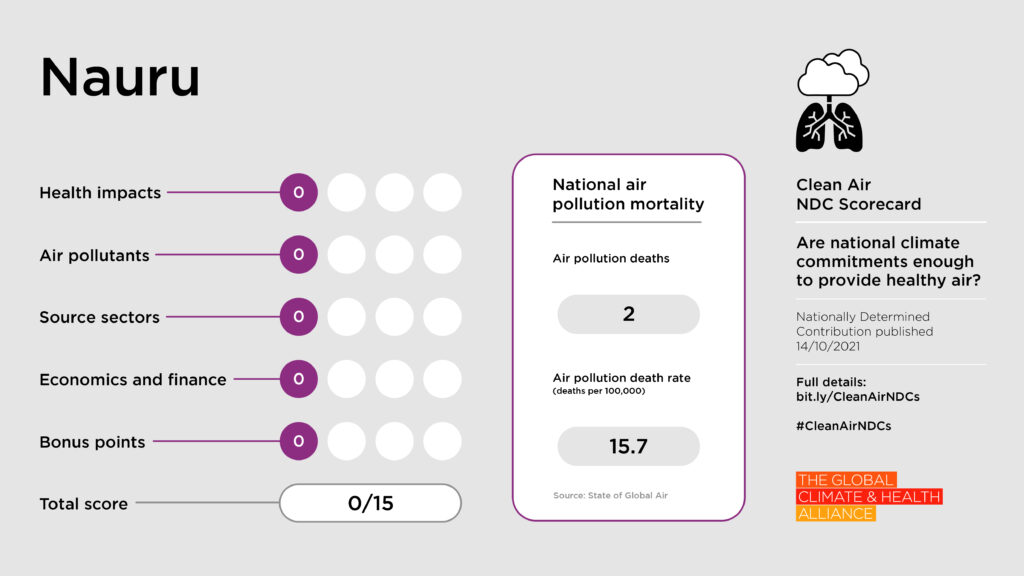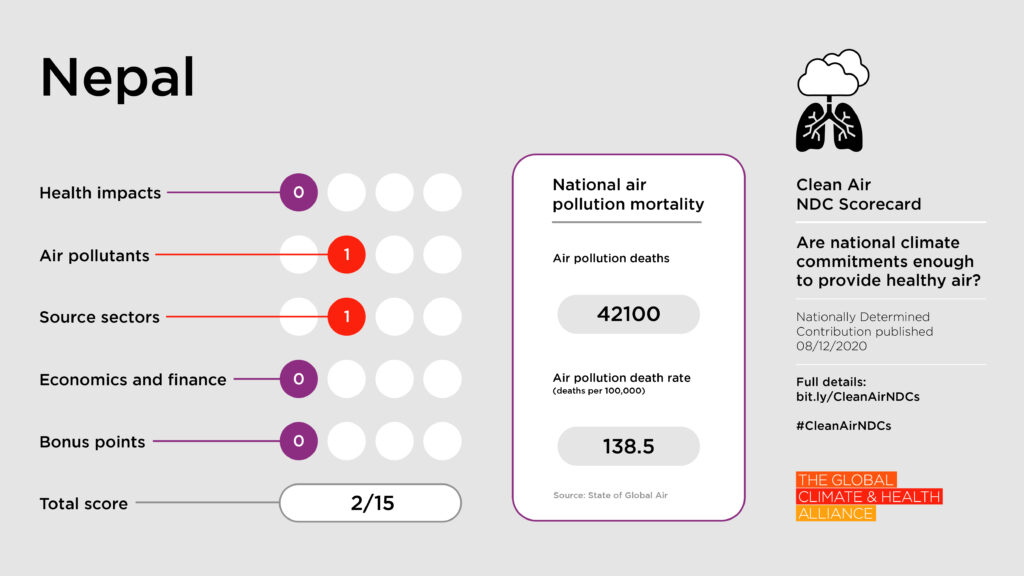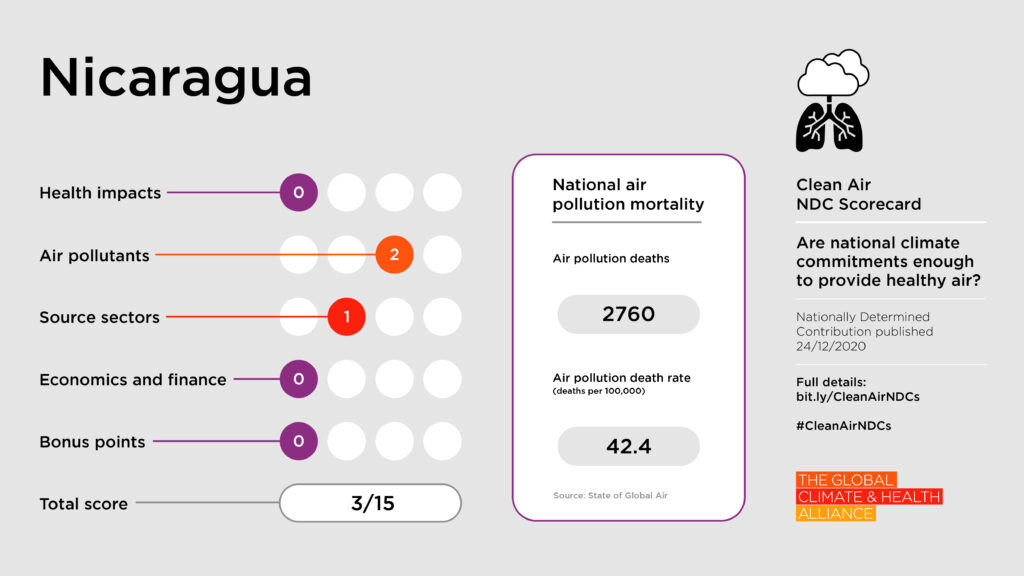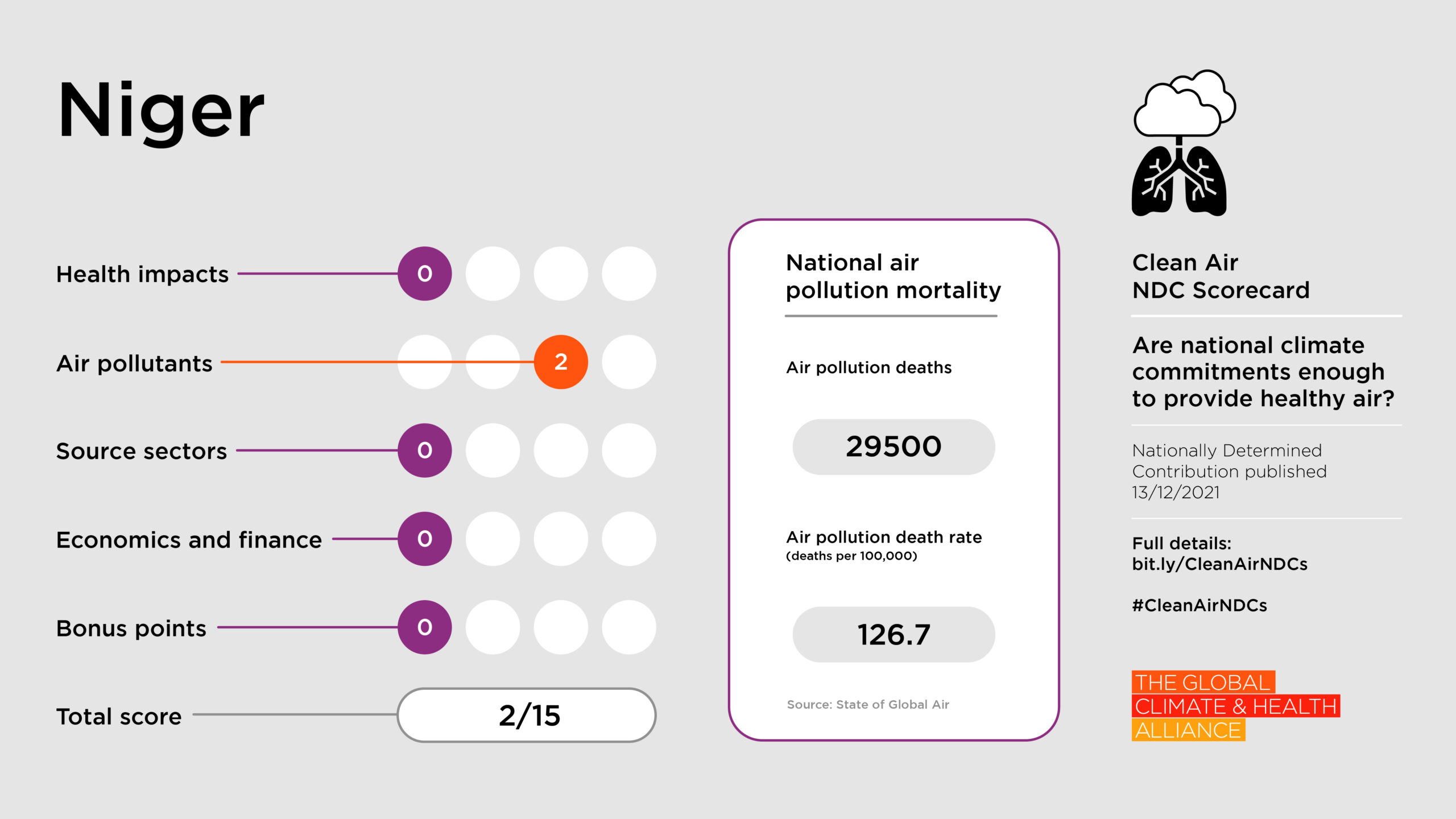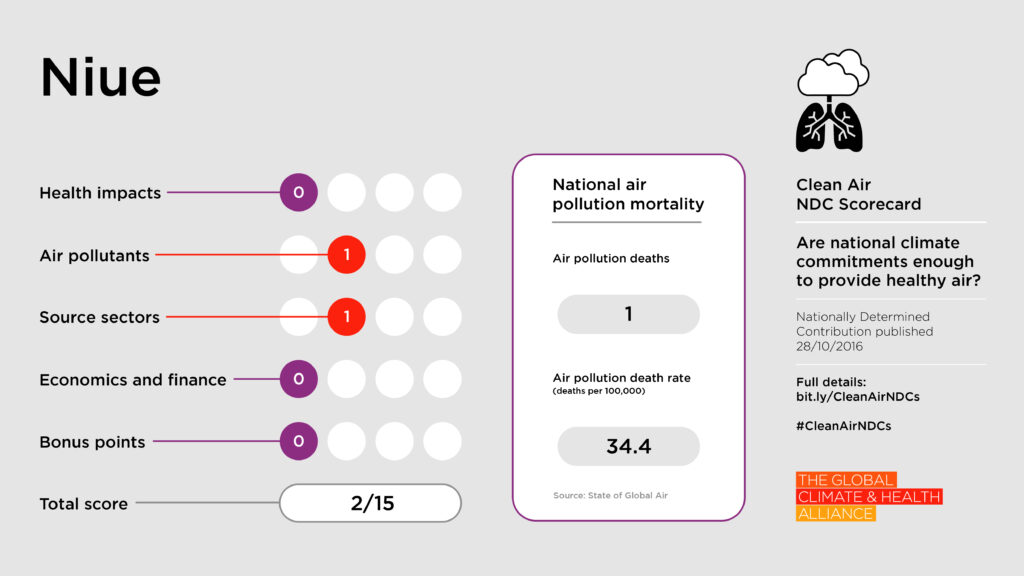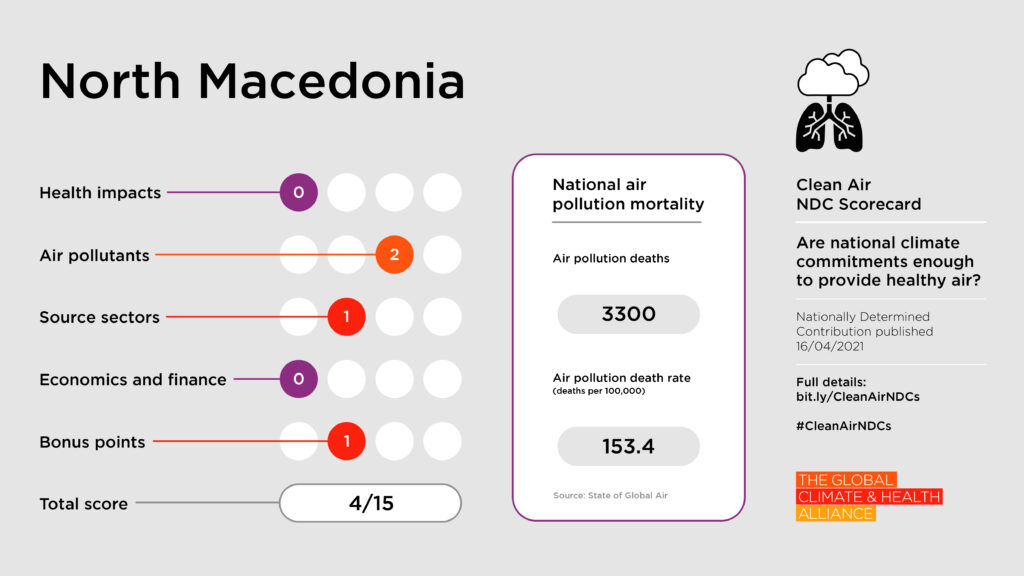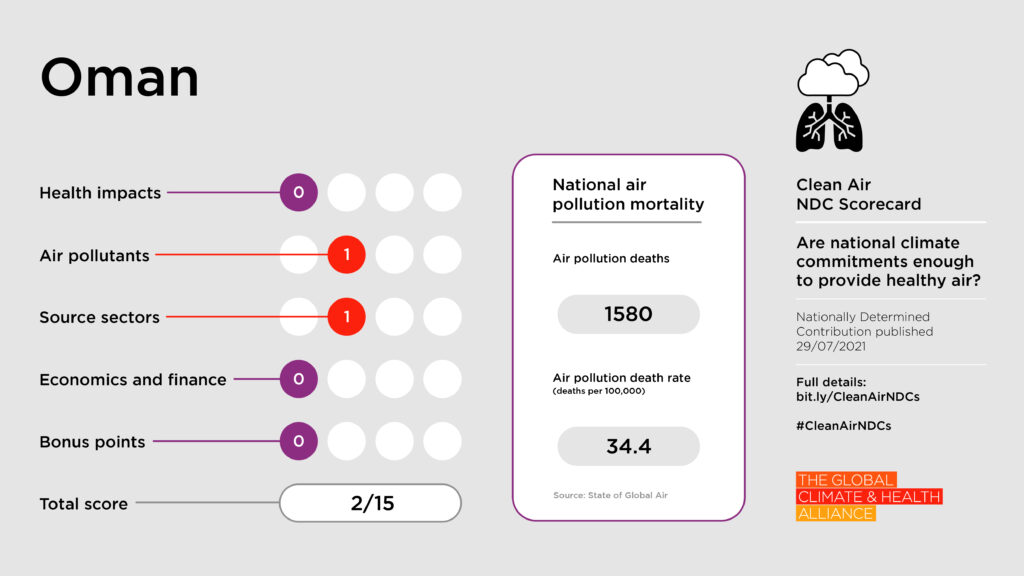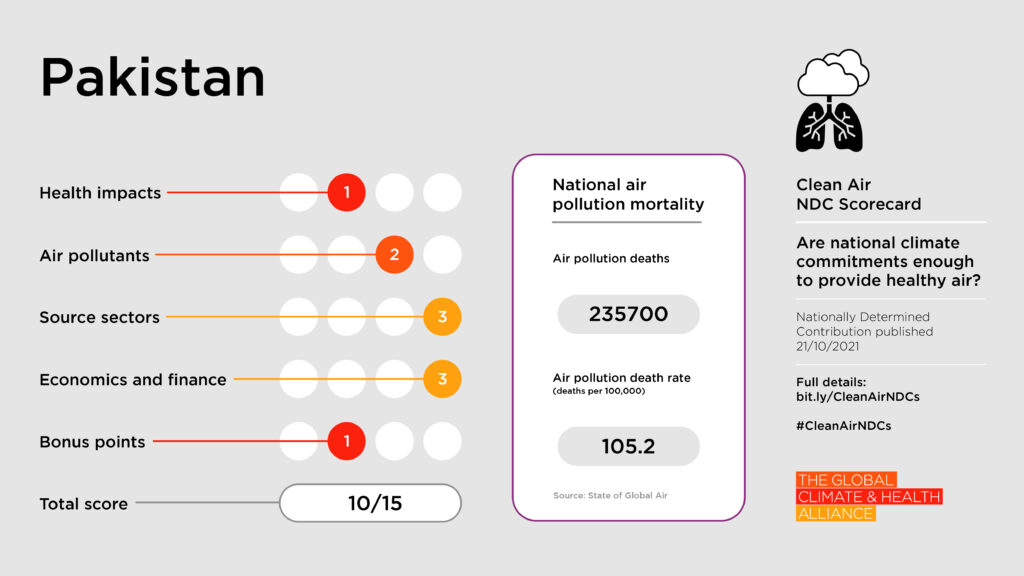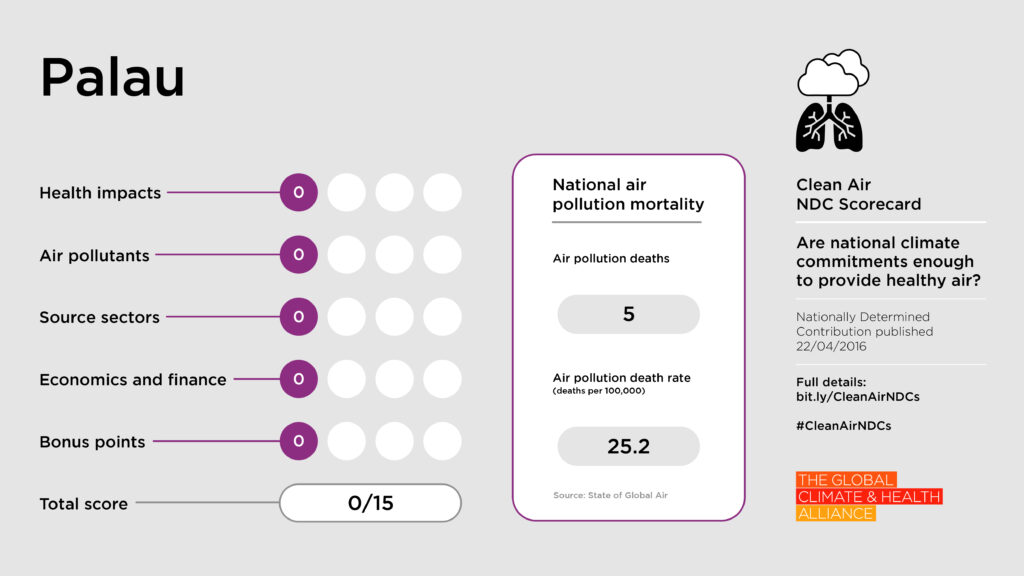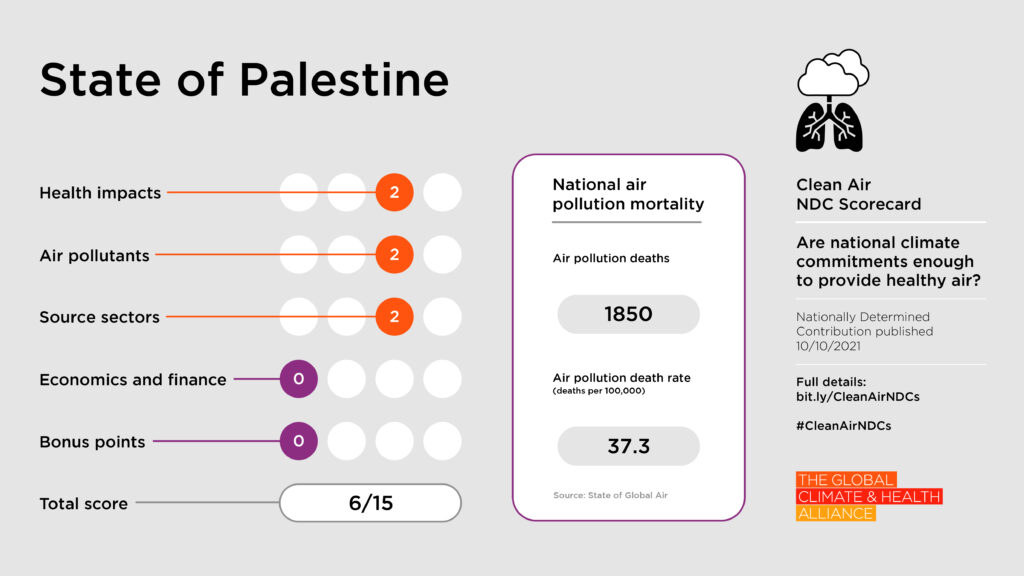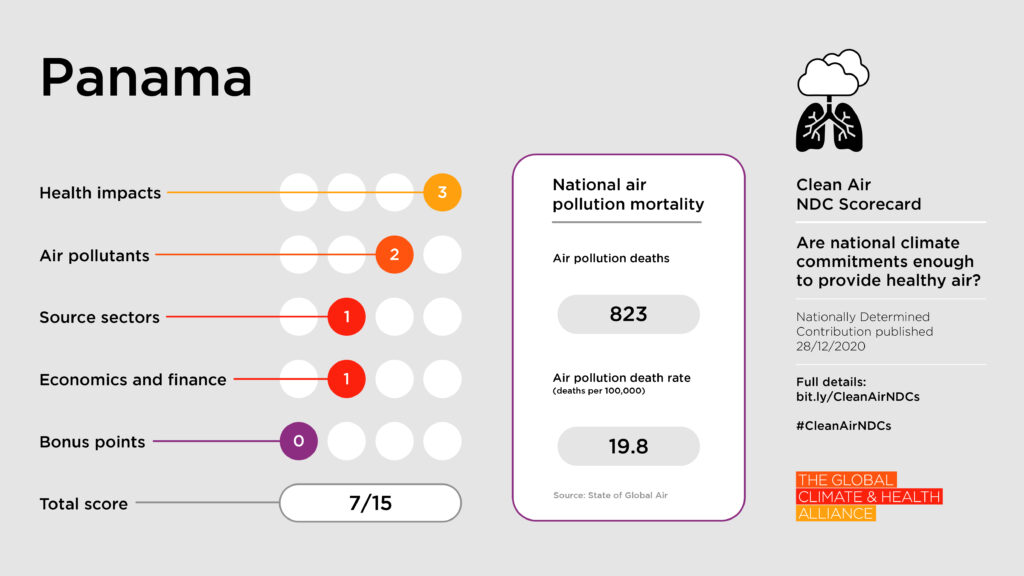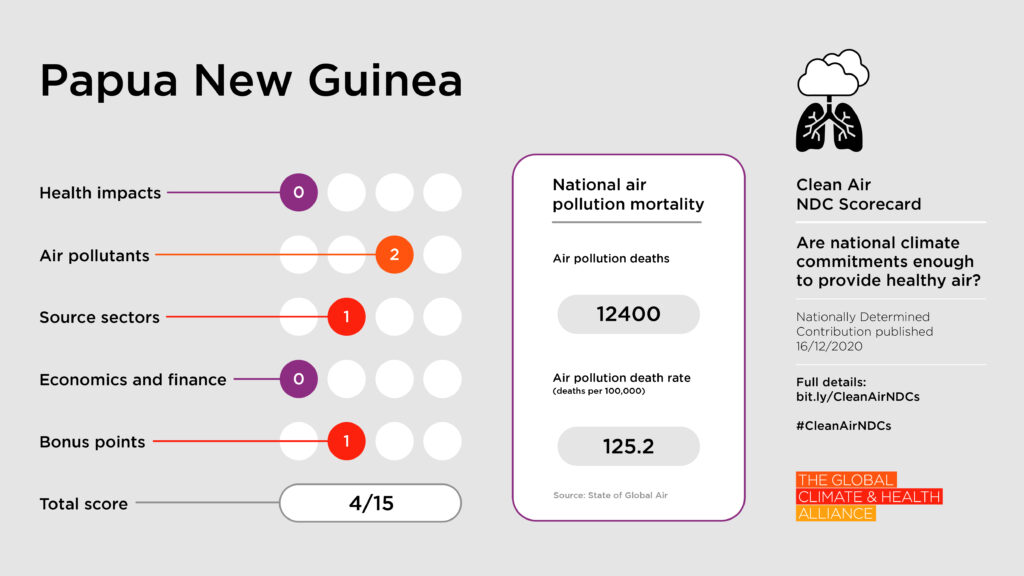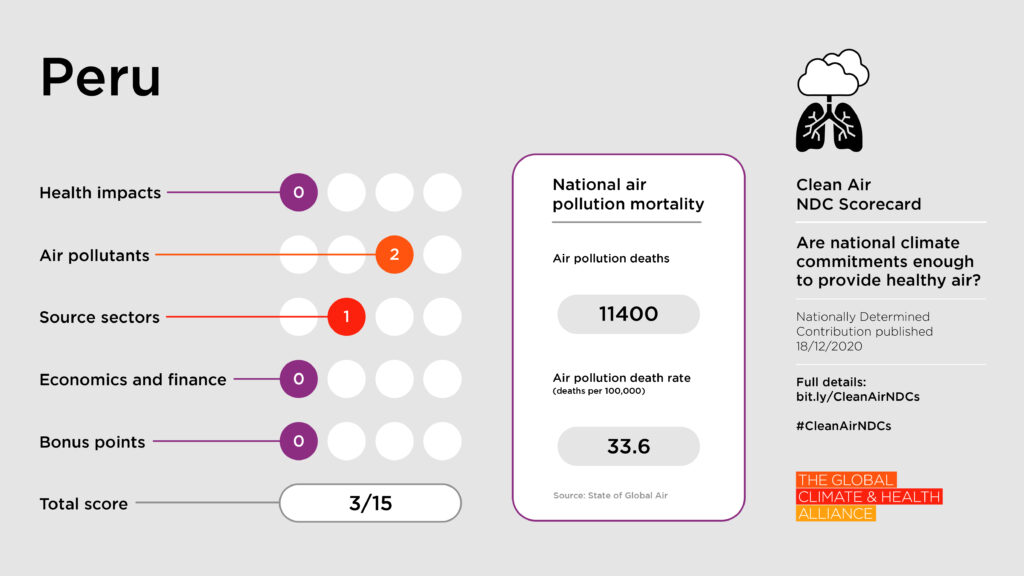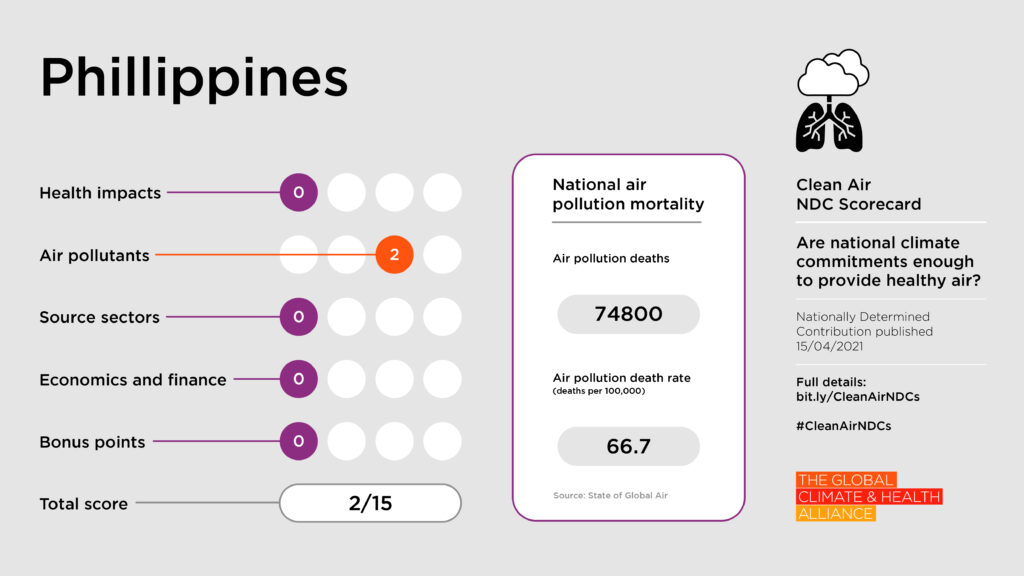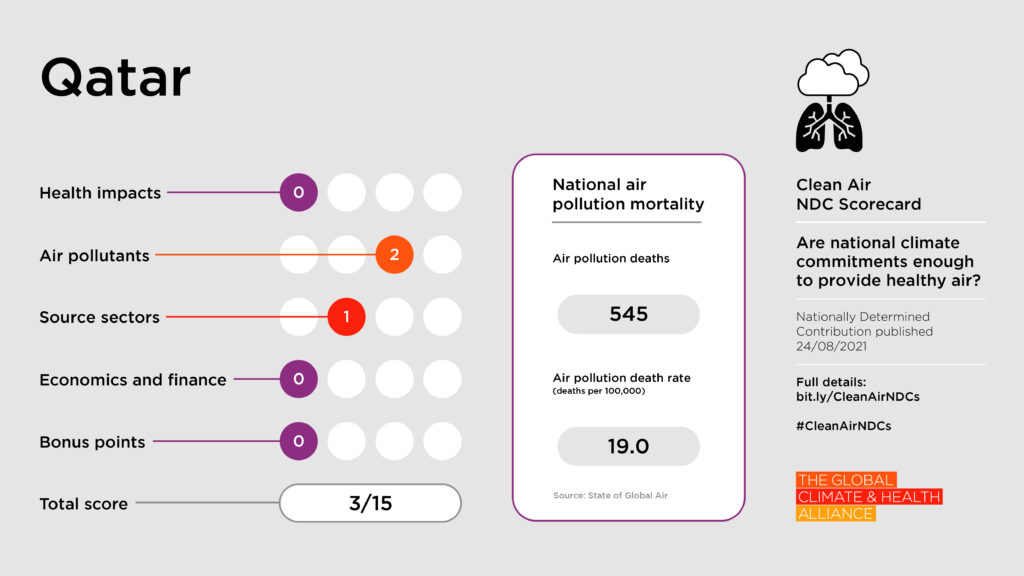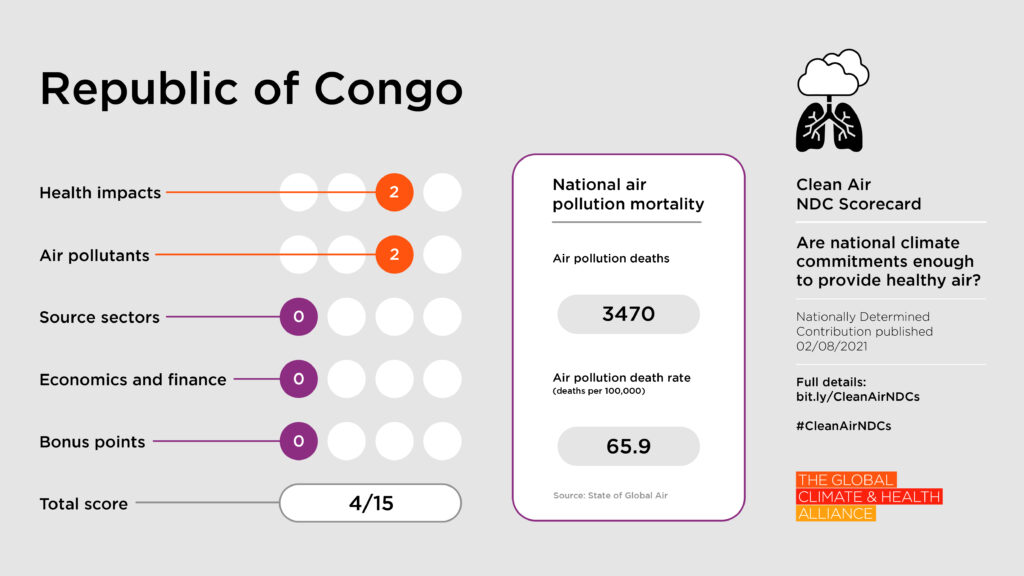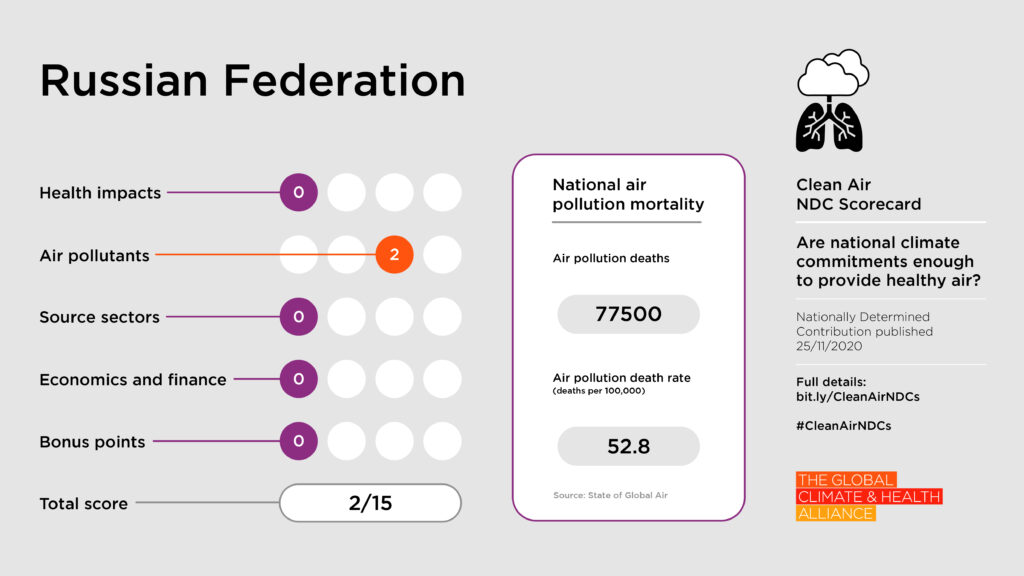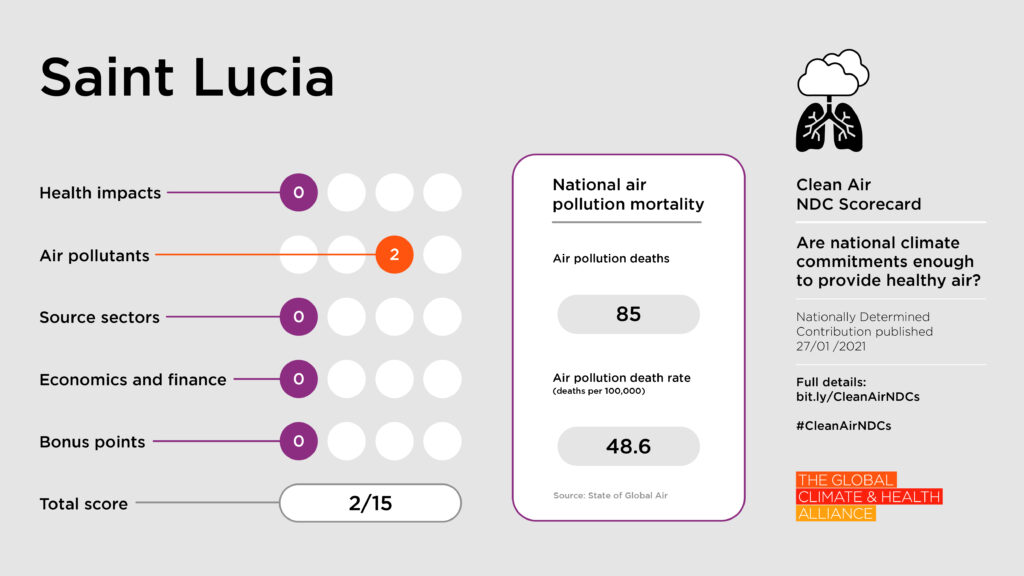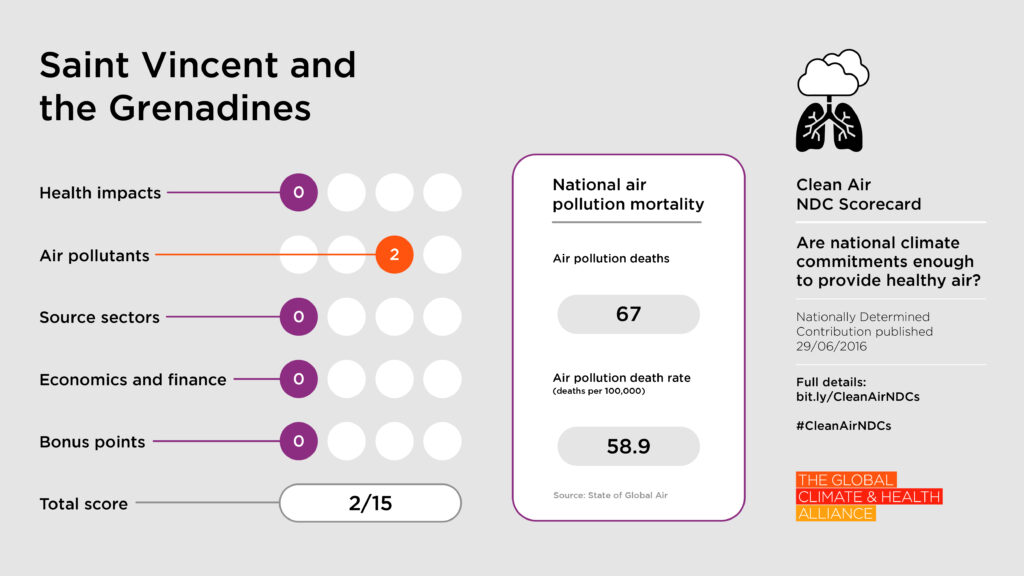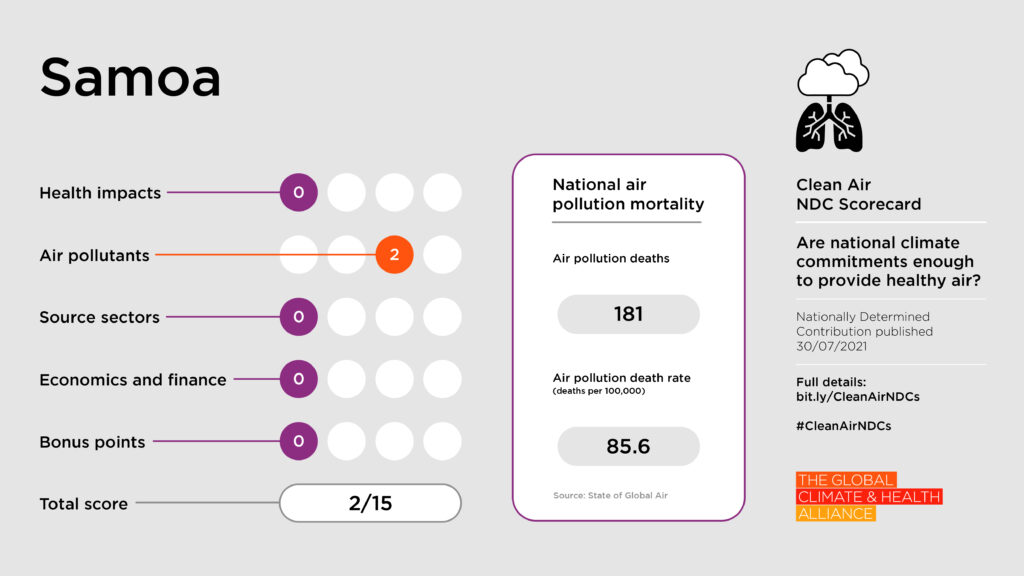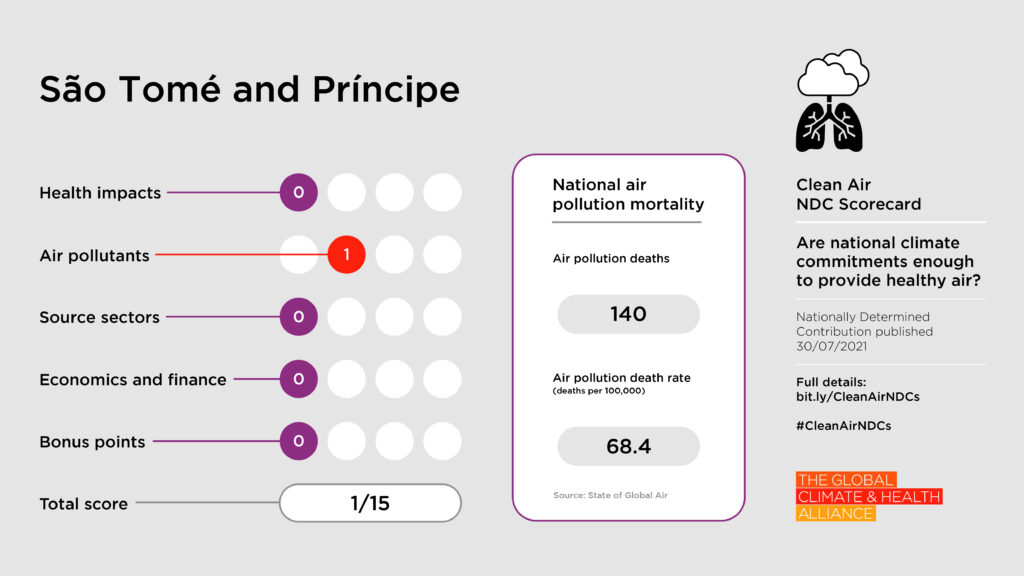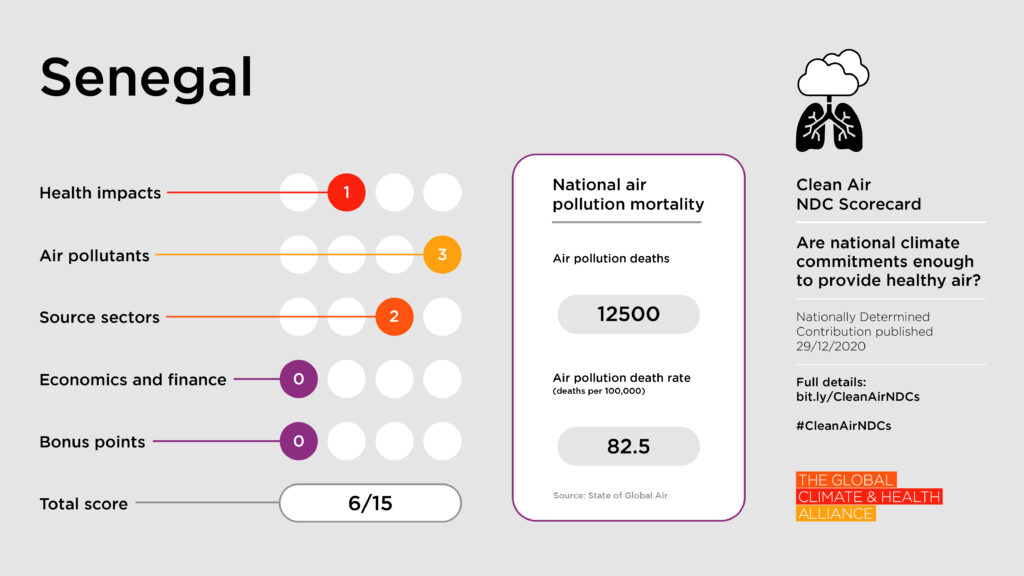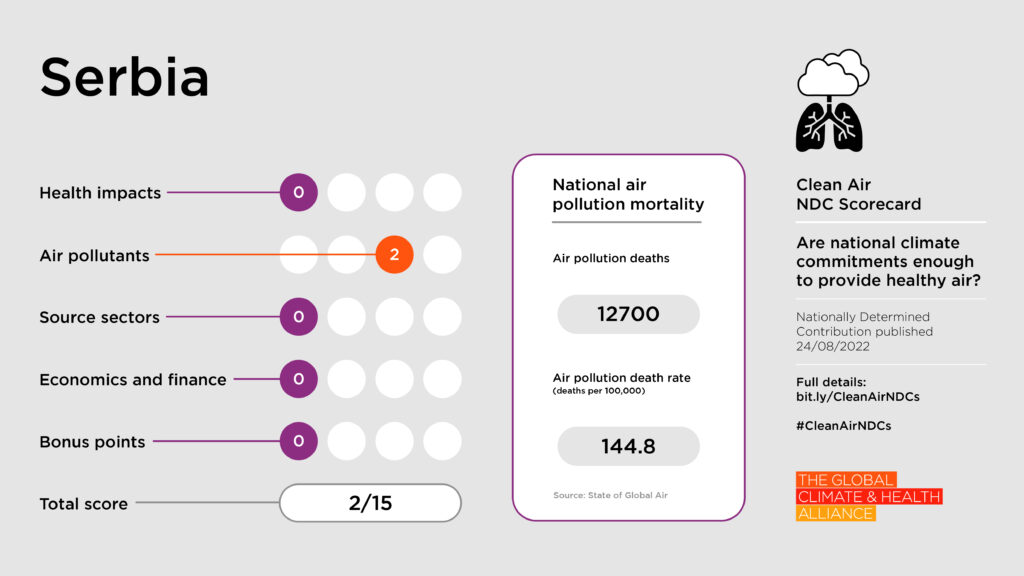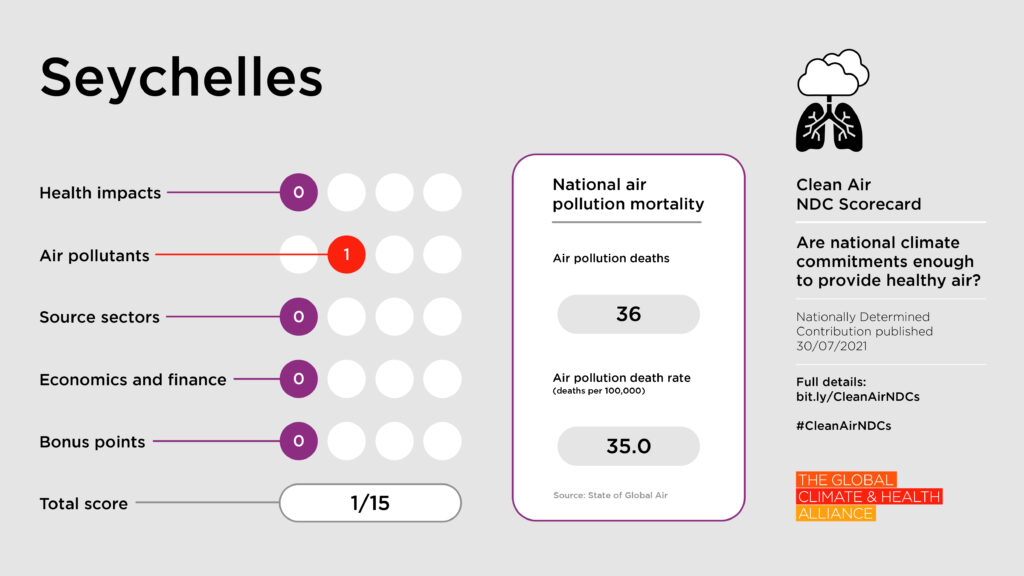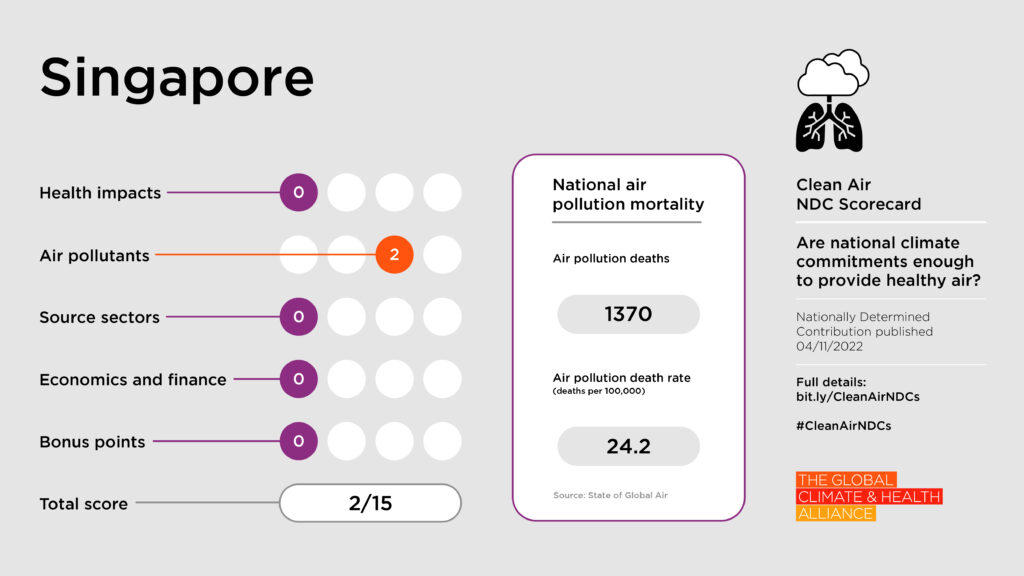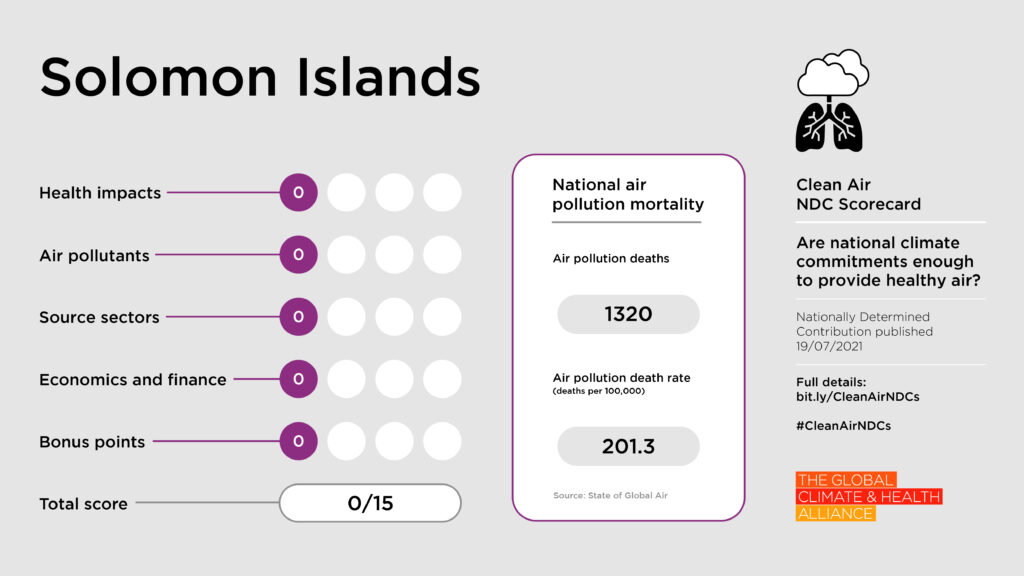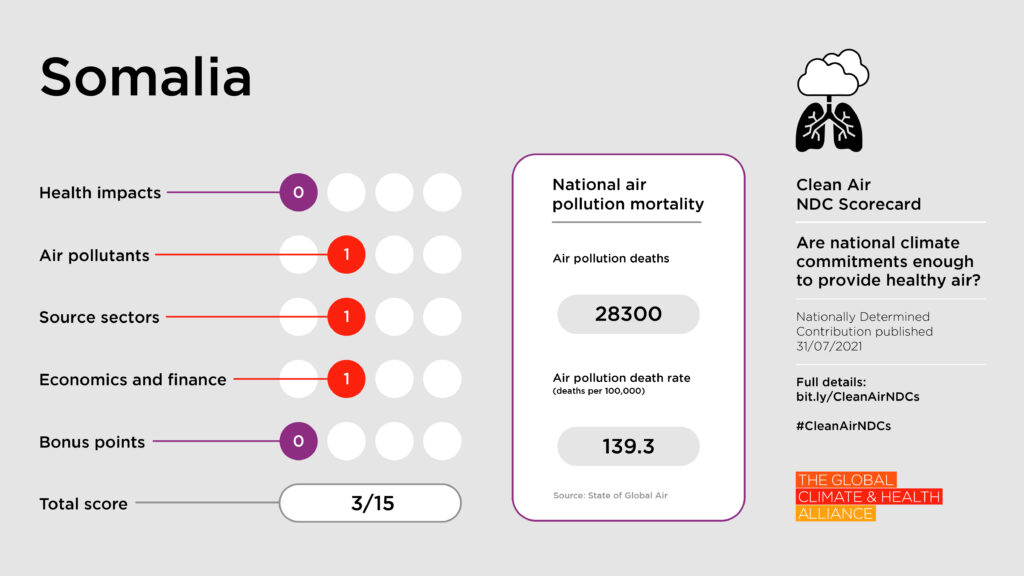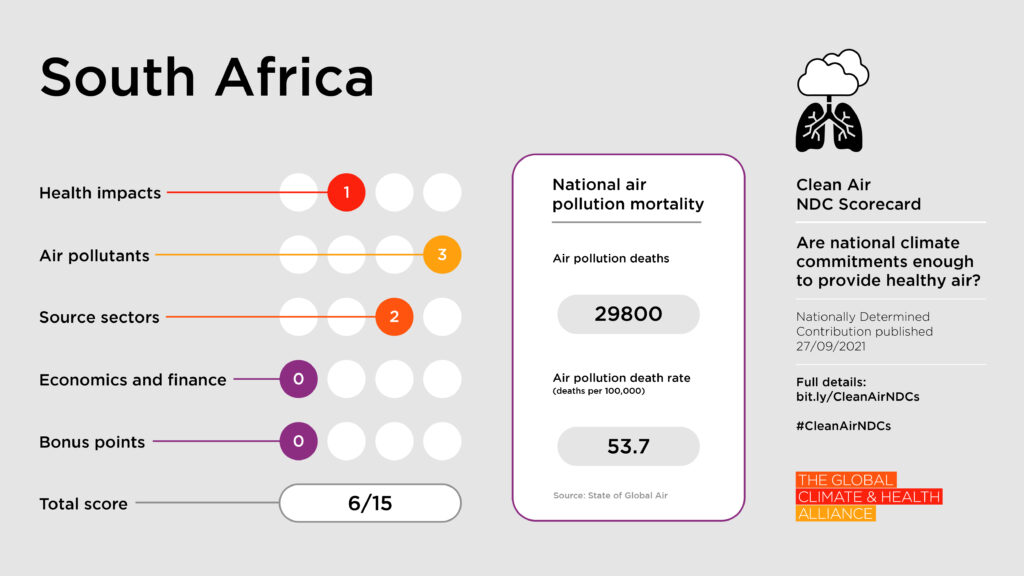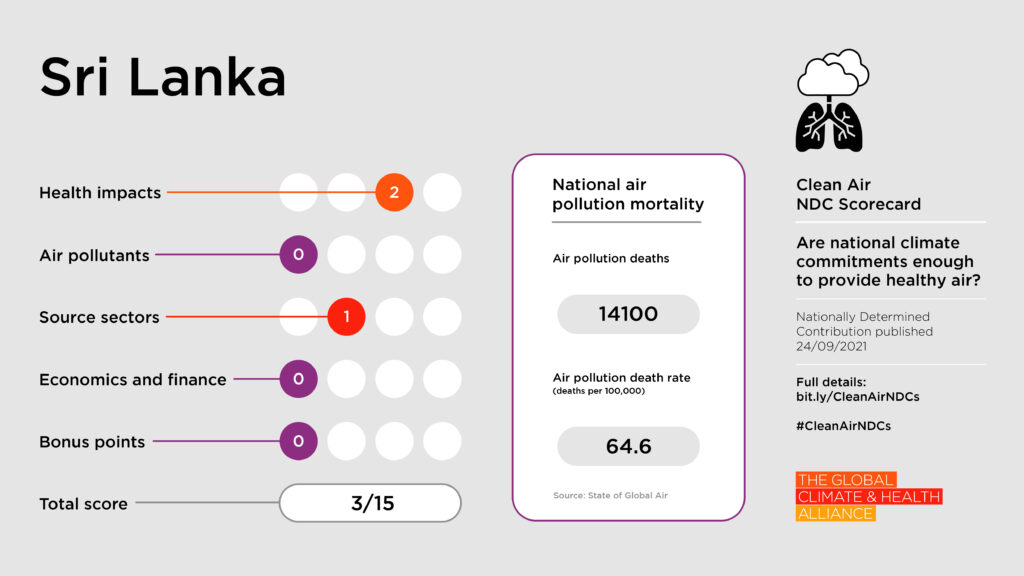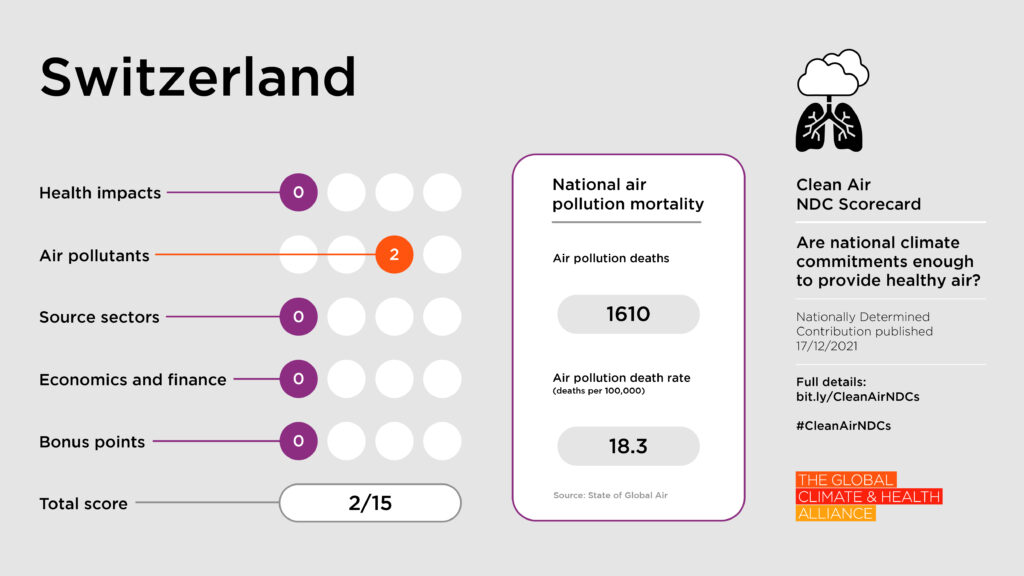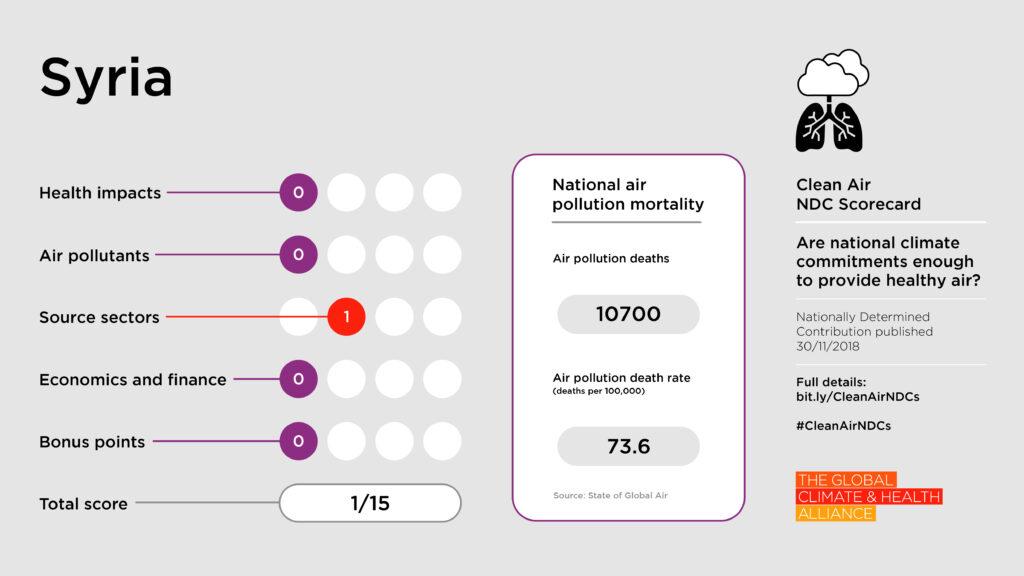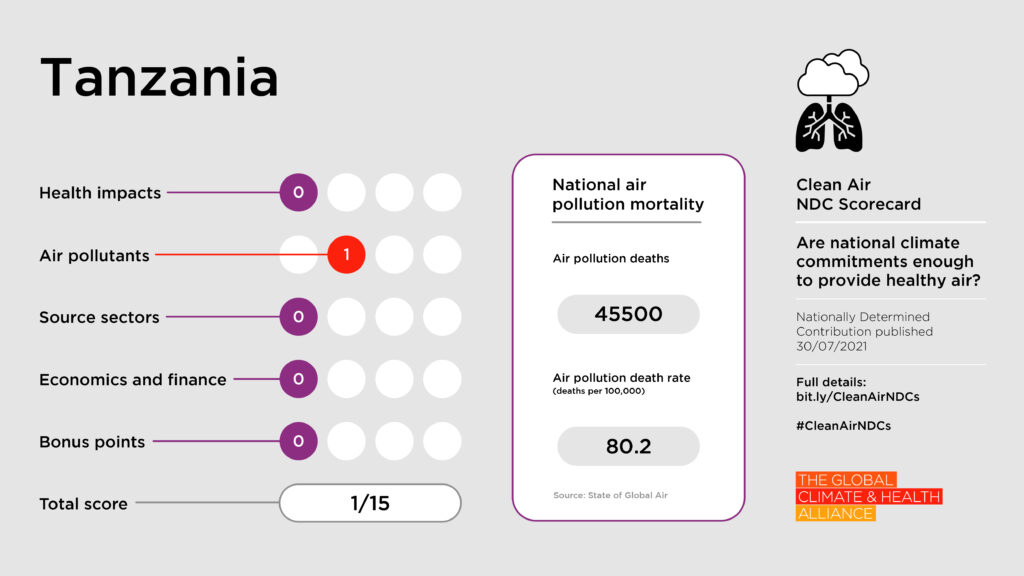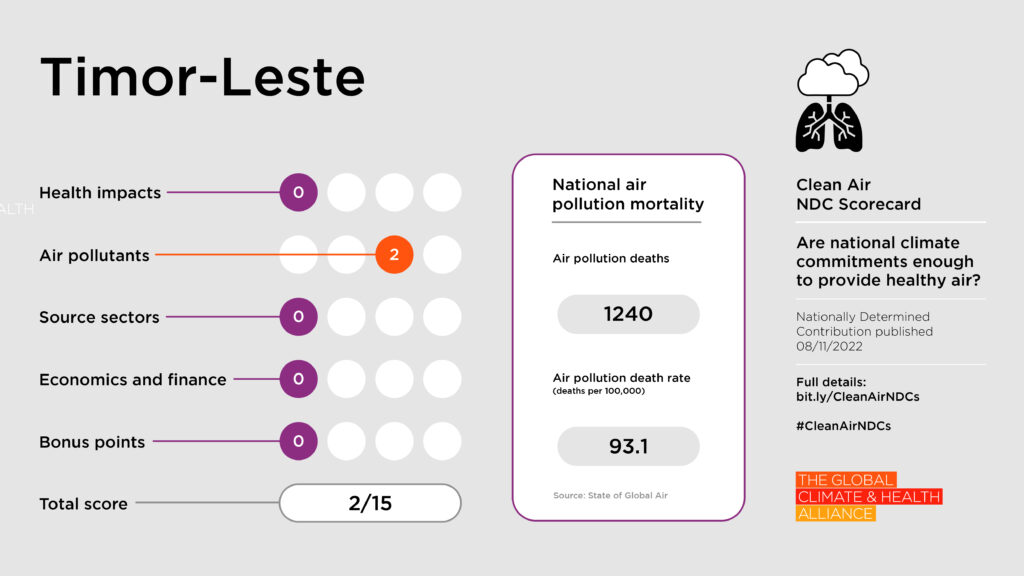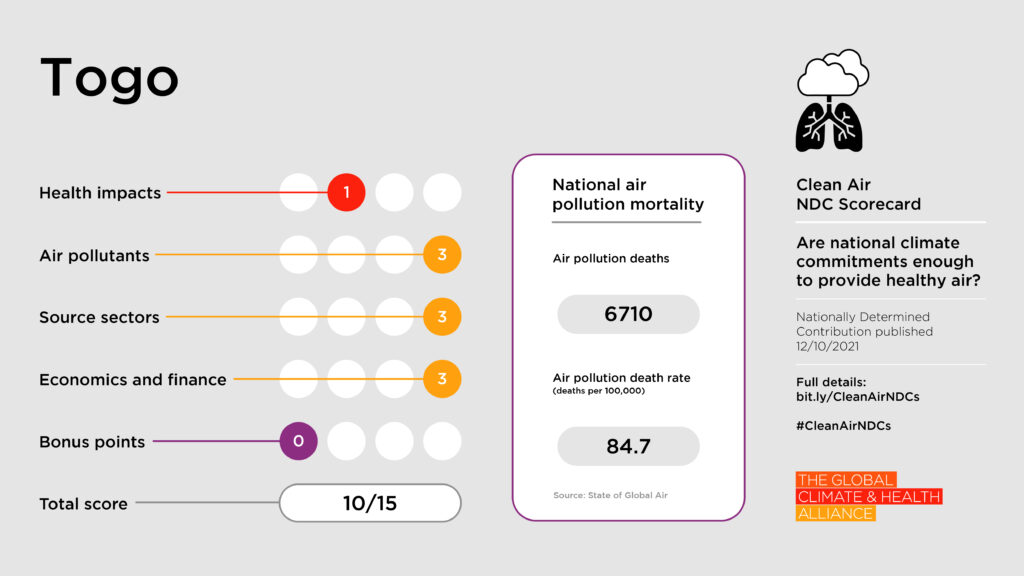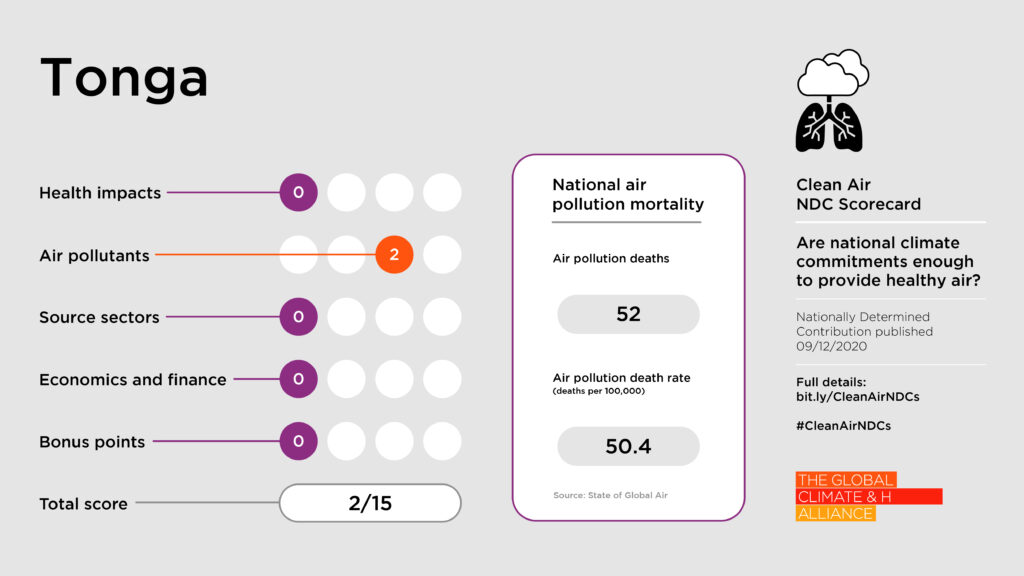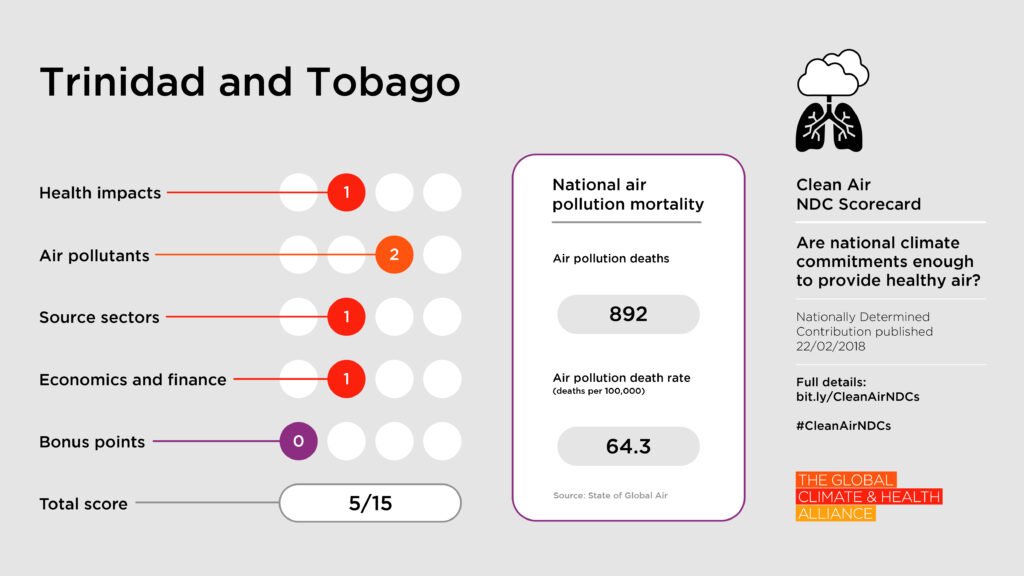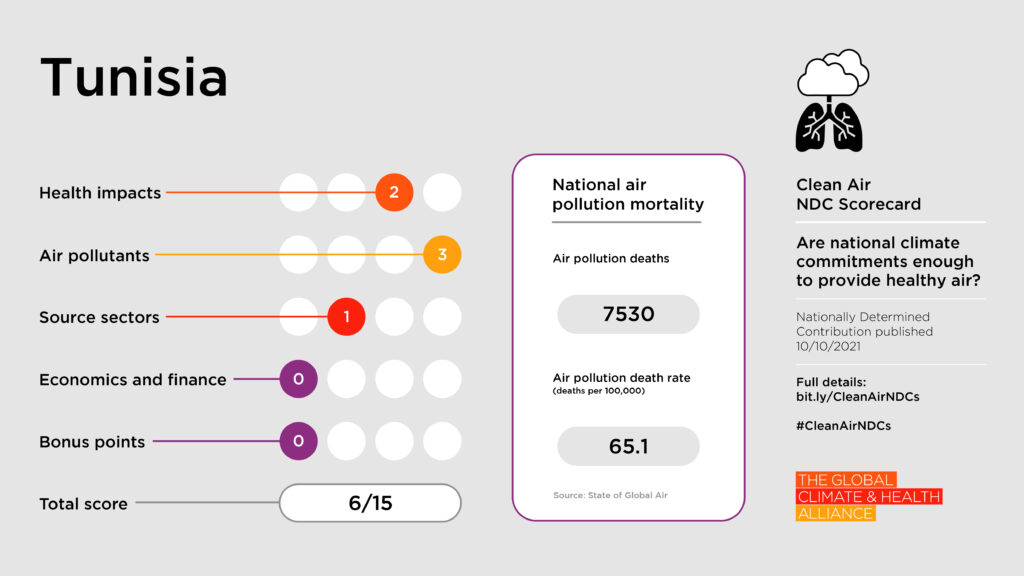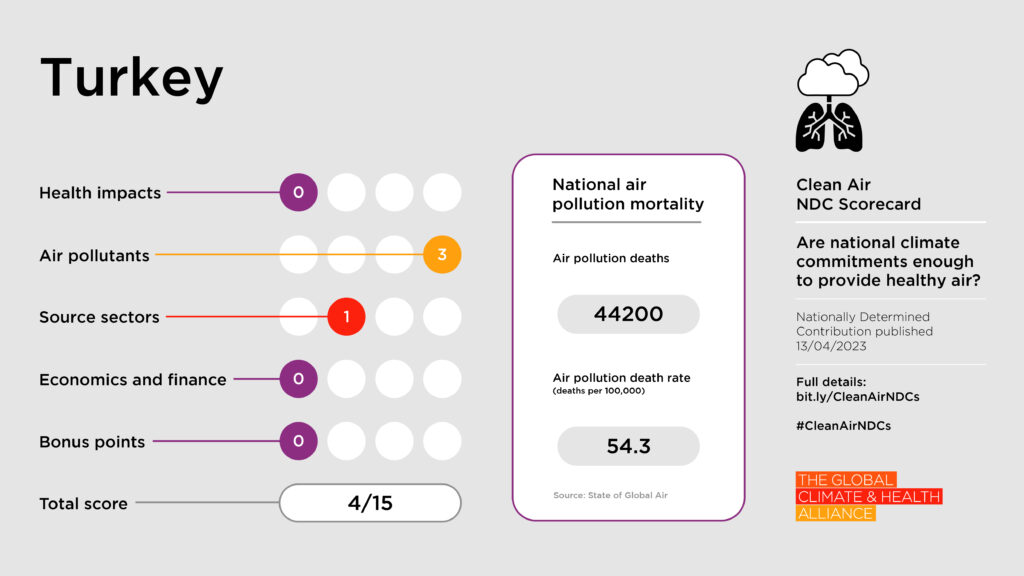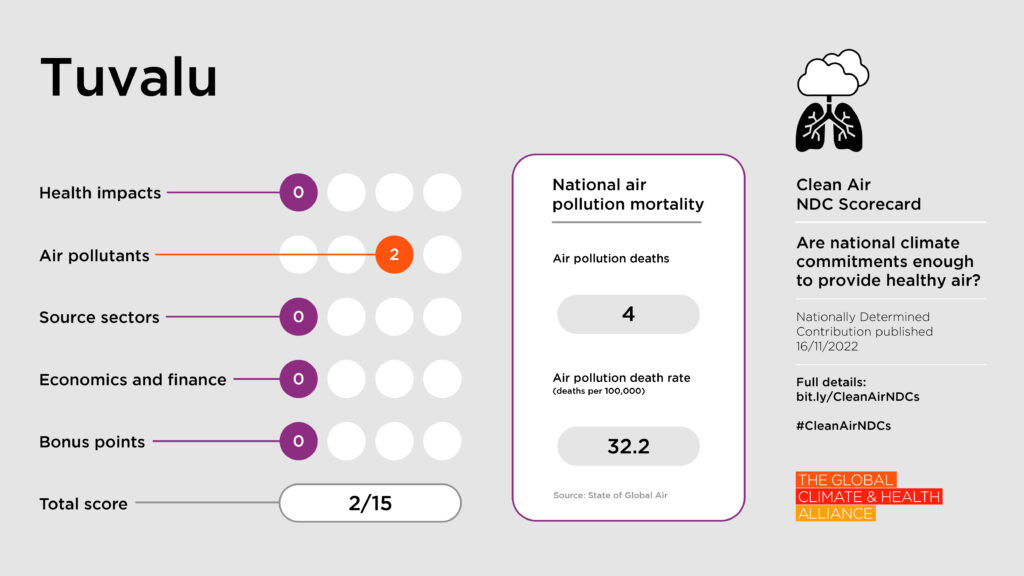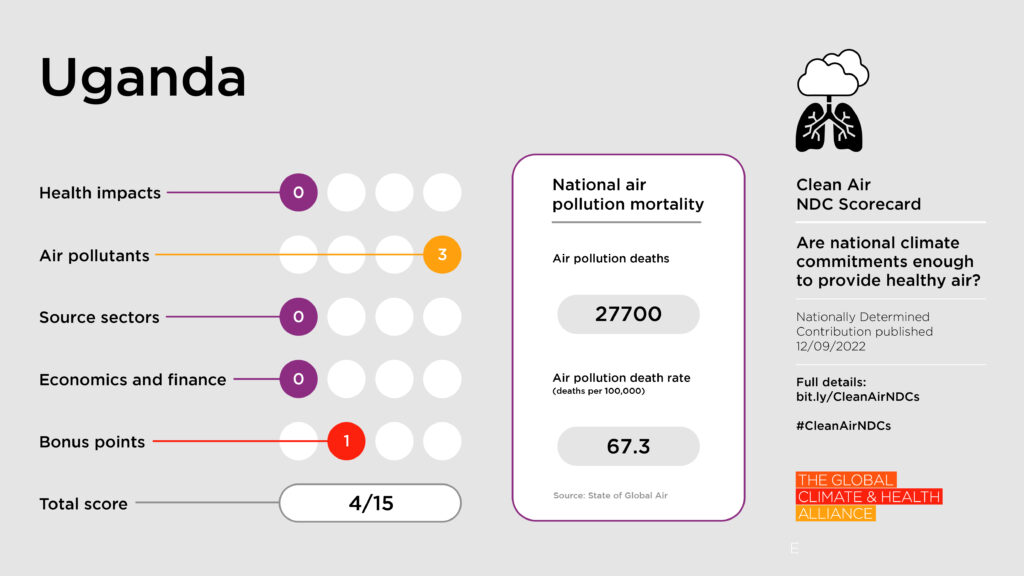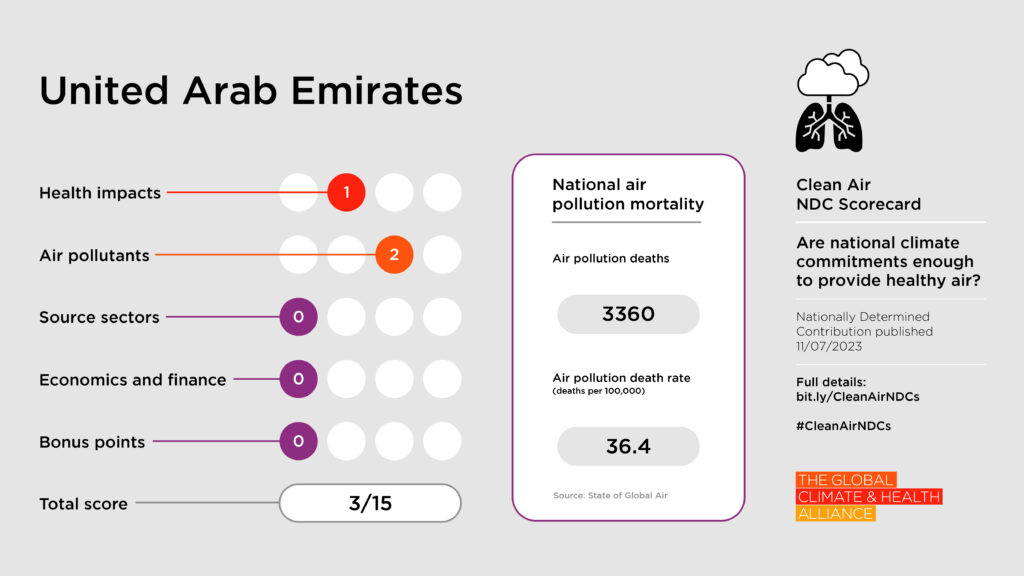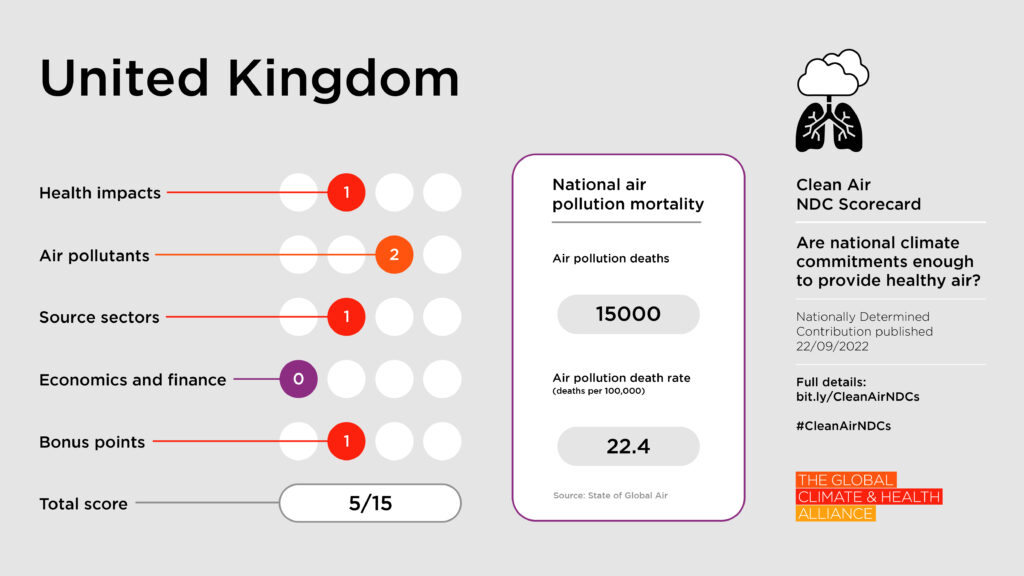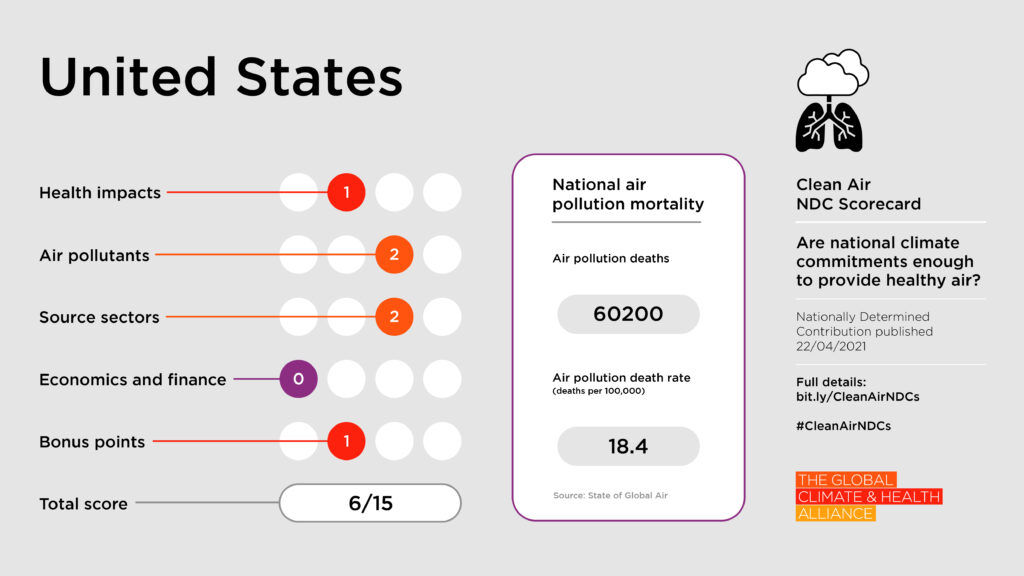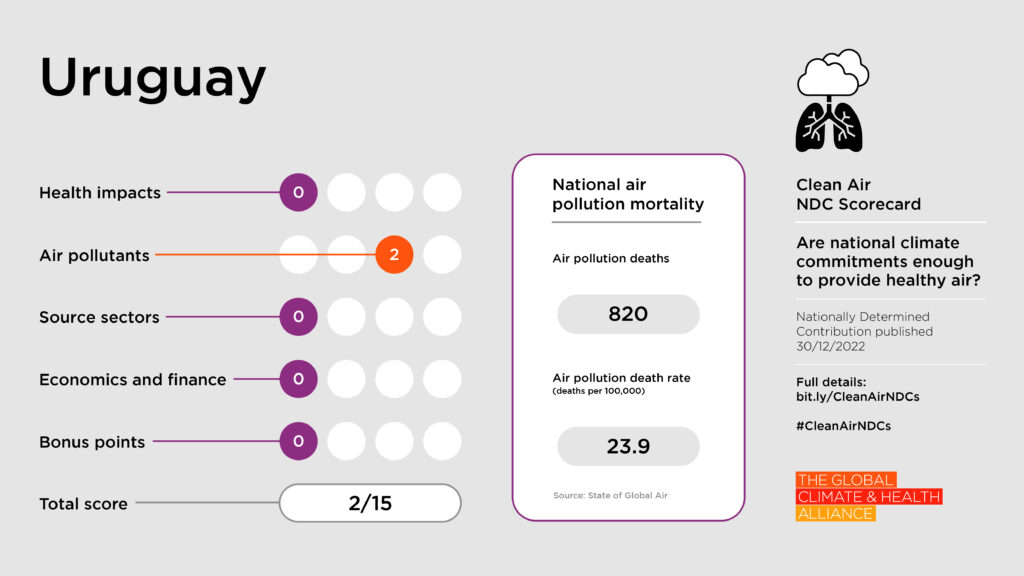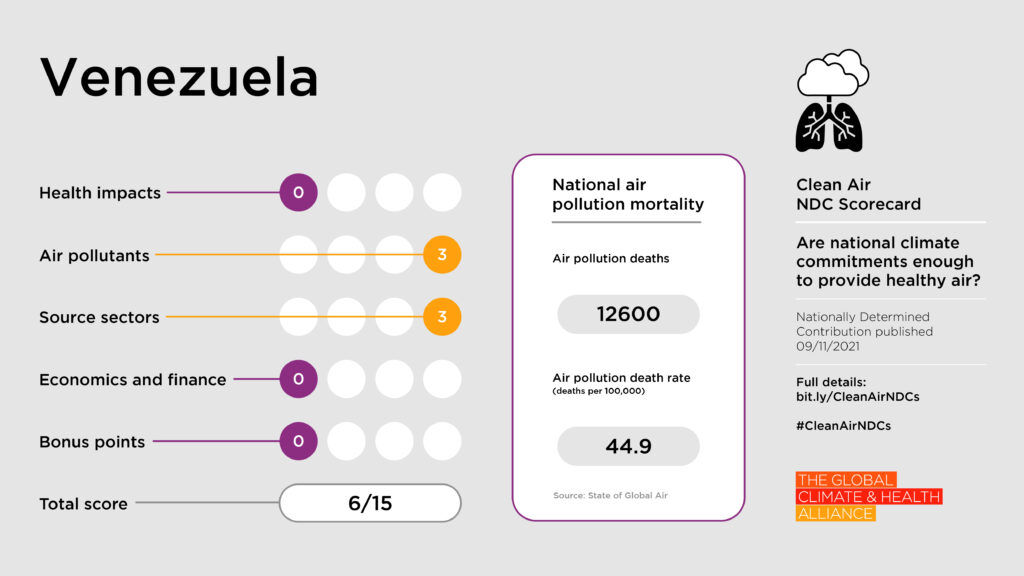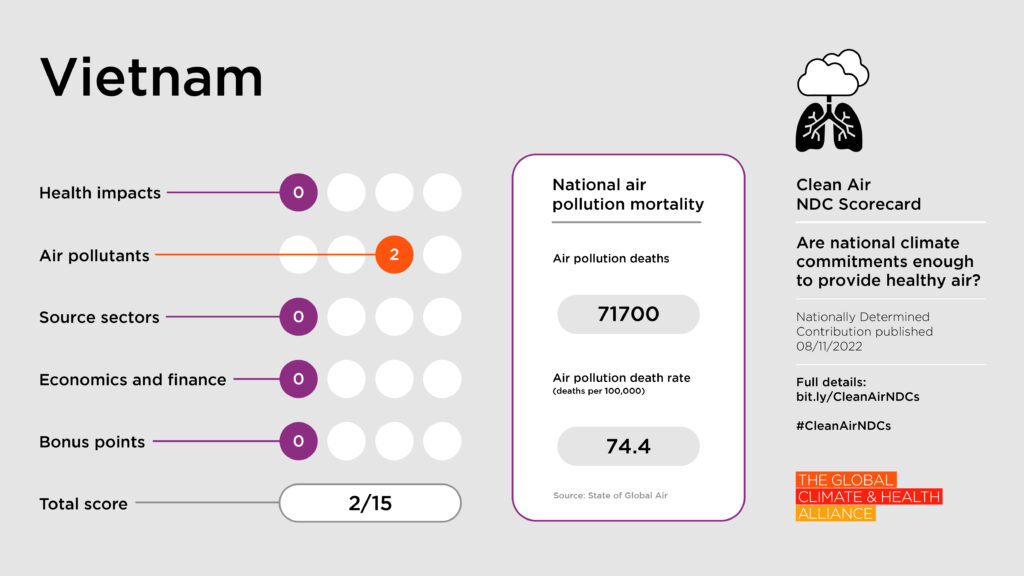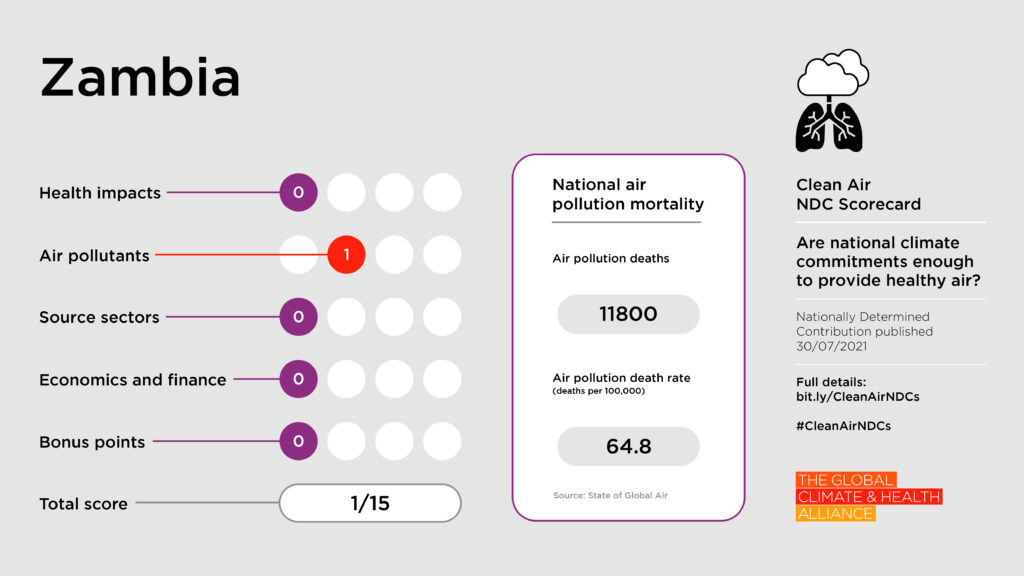Clean Air NDC Scorecard
The Clean Air NDC Scorecard assesses the integration of air quality considerations into Nationally Determined Contributions (NDCs). NDCs are country commitments to deliver the goal of the Paris Agreement, limiting global temperature rise to well below 2C, and preferably to 1.5C. Air pollution and climate change share fossil fuel combustion as a common driver. Meanwhile, climate change worsens existing air pollution. These interlinkages, and the impacts of poor air quality on human health, demonstrate the need to embed air quality actions in NDCs.
The Clean Air NDCs Scorecard ranks 170 NDCs (by 169 countries, and the European Union, which submits a joint NDC) .
NDCs were assessed based on their attention to five categories to give a total clean air score: health impacts, air pollution, source sectors, economics and finance, and bonus points. Three points were available for each category, with a total possible ‘clean air score’ of 15
In addition, the scorecard includes information on the air pollution mortality in each country, revealing whether action to achieve clean air has been sufficient. NDCs are posted on the UNFCCC website. Full details of the methodology and findings can be found in the report, and findings are summarized in the press release.
The content of NDCs provides an overall snapshot of governments’ priorities relating to climate change, and this analysis serves as a barometer for the extent to which the intrinsic links between air quality and climate change are recognised and being addressed. The ‘clean air score’ calculated by GCHA is based solely on analysis of each country’s NDC, and not other wider policies. By their nature, NDCs primarily refer to future plans and targets. While commitment is a prerequisite for ambitious action, air quality, and hence human health, will only benefit if these commitments are delivered.
GCHA is grateful to Blanca Paniello Castillo and Iris Blom for their work in developing the methodology and for carrying out the analysis for this project, and to Pallavi Pant of the Health Effects Institute for her guidance on air pollution mortality data. This work was made possible through a grant by the Clean Air Fund. If you have questions or comments, please contact Jess Beagley at [email protected].
Results
Of the 170 NDCs analysed, almost all (164) mention air pollution to some extent. Colombia and Mali lead on integration of air pollution considerations into their NDCs, achieving 12/15 possible points, followed by Chile, Côte d’Ivoire, Togo, and Nigeria with 10/15 points. Conversely, six NDCs scored 0/15 points, namely Saudi Arabia (which features in the top ten global emitters for total emissions and per capita emissions), North Korea (which has the highest rate of air pollution mortality globally), Bahrain (the second-highest per capita emitter of greenhouse gases globally), Nauru, Palau and the Solomon Islands.
GLOBAL COMPARISONS
- 14 of the 15 top-scoring countries are low- or middle-income countries (namely Colombia, Mali, Côte d’Ivoire, Nigeria, Pakistan, Togo, Ghana, Albania, Bangladesh, Cambodia, El Salvador, Honduras, Moldova, Sierra Leone, alongside Chile as the one high-income country). These countries show commitment to action for clean air, climate and health in their NDCs, and are poised to reap returns on investment in win-win actions.
- Several African countries score highly, with 5 of the 8 countries scoring 9/15 or above being Mali, Côte d’Ivoire, Nigeria, Togo and Ghana.
- Globally, results demonstrate vast room for improvement: the average score achieved in any NDC was 3.5/15 points.
- High-income countries are failing to capture clean air co-benefits and the opportunity to maximise the health gains of their climate commitments, with an average score of 2.9/15 points. Meanwhile, G20 countries which submitted an individual NDC (all except Germany and Italy) have a below average score, with a mean of 3.3/15 points.
- The top ten per capita emitters (Qatar, Bahrain, Brunei Darussalam, Trinidad and Tobago, Kuwait, United Arab Emirates, Mongolia, Oman, Australia, Saudi Arabia), many of which are major fossil fuel producers, scored an average of just 2.4/15 points, which is indicative of a lack of interest in connecting fossil fuel phase out to clean air and its potential health benefits.
- Meanwhile, the top ten total emitters (China, United States, India, European Union, Russian Federation, Brazil, Indonesia, Japan, Iran, Saudi Arabia) scored little better, with an average of 2.7/15 points.
- In several countries with higher scores, including Mali, Cambodia, Pakistan and China, high levels of air pollution mortality exist. Increased finance could enable these countries to accelerate implementation of actions described. Meanwhile, potential donor countries most often fail to recognise these links in their own NDCs.
- The ten countries with the highest rates of air pollution mortality (North Korea, Solomon Islands, North Macedonia, Central African Republic, Bosnia and Herzegovina, Serbia, Vanuatu, Somalia, Nepal, Myanmar) achieved an average of 2.5/15 points, underscoring the public health impacts of failing to recognise the links between climate action and healthy air.
As in prior iterations of the Healthy NDC Scorecard, which assessed the integration of health into NDCs, low- and middle-income countries achieved the highest scores. In the Clean Air NDC Scorecard, low-income countries have the highest average scores, with a mean of 3.7/15 points. Lower middle-income countries closely followed, with an average of 3.6/15 points, while upper middle-income countries scored an average of 3.4/15 points. High-income countries secured an average of 2.9/15 points.
TOP CLEAN AIR SCORERS COUNTRY FOCUS
Colombia has an overall clean air score of 12/15. Its NDC recognises the importance of protecting health (including respiratory health specifically) through air quality action, and of monitoring these gains. The NDC states that the integration of policies facilitating this monitoring will be formulated within the health sector. The NDC also refers to multiple air pollutants, including particulate matter and nitrogen oxides, and sets a goal to achieve a reduction of 40% in black carbon. Multiple sectors are identified as sources of air pollution, including agriculture, electricity generation, industry, and transport. In the transport sector, Colombia intends to augment the modal share of bicycle usage by 5.5% by the year 2030 across all cities, improving mobility and air quality for citizens. Colombia also refers to inequalities and vulnerabilities related to air pollution, as well as quantifying lives saved using the CaRBonH tool.
In its respective NDC, which also achieved 12/15 points, Mali notes that black carbon contributes to negative impacts on human health, and that PM2.5 impacts cardiovascular and respiratory systems. It plans to form a technical team to monitor SLCPs as they relate to human health. In addition to SLCPs, the NDC refers to multiple other air pollutants. Interventions to improve air quality are mentioned in several sectors. The NDC mentions a price tag to reduce air and water pollution linked to pesticides and other harmful products. Mali also refers to the Climate and Clean Air Coalition, and notes that improvements in air quality could avoid 2.4 million premature deaths by 2030.
Other leading clean air scores include Chile, Côte d’Ivoire, Nigeria, Pakistan and Togo with 10/15 points; Ghana with 9/15 points; and Albania, Bangladesh, Cambodia, El Salvador, Honduras, Moldova and Sierra Leone with 8/15 points.
HEALTH IMPACTS
Within the health impacts category, less than a third of NDCs (51) refer to the health impacts of air pollution, quantify the burden, or specify any action within the health sector relating to the provision of care for pollution-related health impacts, or public health actions. Fossil fuel dependence is a leading driver of climate change, air quality and health impacts – recognising these interlinkages is a first step towards the healthy and just transitions across sectors needed to protect air quality and human health. Among the countries scoring 0/15 points in the health impacts category are high emitters Australia, the European Union, Indonesia and Saudi Arabia.
AIR POLLUTANTS
Air quality targets are key for protecting human health. While the majority of NDCs (119) consider at least two named health-harming air pollutants, only 32 refer to forward-looking targets, monitoring or projections. This highlights the need for advances and greater consistency in monitoring practices.
SOURCE SECTORS
Little more than a third of all NDCs (62 of 170) refer to actions to reduce air pollutants in specific sectors. Transportation emerged as the most frequently mentioned source sector, while only two NDCs (Jordan and Venezuela) linked actions in the healthcare sector with improved air quality. Power generation, a major source of fossil fuel-driven air pollution in many countries, was only mentioned as a source of pollution in 21 NDCs. Coordinated action across sectors is necessary in order to improve air quality and protect health. Cambodia scores highly with regards to cross-sectoral action, which includes urban planning tools for climate change mitigation and air pollution reduction, plus risk analysis for electricity infrastructures to improve air quality.
ECONOMICS AND FINANCE
Only 17 of all 170 NDCs mention costs or budget considerations, or returns on investment linked to air quality. For example, Togo specifies the costs of actions, including its green mobility programme and the promotion of modern bioenergy for cooking, with US$43.7 million required to implement the latter. Financial considerations are crucial for ensuring the commitments outlined in NDCs are implemented.
BONUS POINTS
Only 20 countries achieved points in the bonus points category. This reflects the absence of references in most NDCs to the World Health Organization (WHO) Air Quality Guidelines or the Climate and Clean Air Coalition (CCAC), or to calculating the number of lives saved or other health gains through air quality action. The CLIMAQ-H tool developed by the WHO in 2023 (formerly the CaRBonH tool mentioned above22) can be used to calculate the health and economic gains associated with air quality improvements from mitigation actions, and thus returns on investment. Of the 20 NDCs which achieved points in the bonus category, only 10 refer to air pollution impacts in vulnerable populations. South Sudan specifically refers to introducing improved cooking stoves to improve indoor air quality and protect the health of women, who are disproportionately exposed to indoor air pollution.
AIR POLLUTION MORTALITY
Several countries stood out when comparing clean air scores to national air pollution mortality, including India and China. India, which has a mortality rate of 119.9 per 100,000 population, received 2/15 points, demonstrating the urgent need for strengthened policies. Meanwhile, China achieved a higher score of 7/15 points, but continues to experience an air pollution mortality rate of 129.9 per 100,000 population, making clear that commitments must be accompanied by continued translation to action. Among countries with some of the highest clean air scores, such as Mali, Côte d’Ivoire, Nigeria, Pakistan and Togo, air pollution mortality is above 80 deaths per 100,000, demonstrating the need for implementation of policy objectives, for which the provision of international finance will be essential.
Looking beyond high emitters, North Korea and Solomon Islands carry the highest air pollution mortality rate of all countries analysed, with both achieving 0/15 points. In Solomon Islands, this is driven by household air pollution, as most households do not have access to electricity and use solid fuels for cooking. These disconnects suggest a substantial blind spot when it comes to governments making the connection between air pollution, climate change, and health, even when health impacts are significant.
The barchart and country scorecards can be downloaded in multiple languages. Please share them on social media, using the hashtag #CleanAirNDCs.
- CAT: Climate Action Tracker
- HFCs: hydrofluorocarbons
- N2O: nitrous oxide
- NF3: nitrogen trifluoride
- NH3: ammonia
- NMVOC: non-methane volatile organic compounds
- NOx: nitrogen oxides
- PM: particulate matter
- SLCP: short-lived climate pollutant
- SF6: sulphur hexafluoride
- SO2: sulphur dioxide
Afghanistan’s NDC covers N2O alongside other gases. It mentions specific measures to address emissions in the agriculture sector, including reduced fertiliser application, and in households, including through clean cookstoves and fuels, which has an associated budget.
Albania cites the impact of poor air quality on cardiovascular and respiratory conditions, especially in Tirana and other cities. The NDC refers to N2O and HFCs, and mentions air quality monitoring. The document makes reference to the pillars of the EU Green Deal for the Western Balkans, which include climate action alongside fighting air pollution, while sector specific measures are also mentioned for the agriculture and waste sectors.
Algeria’s NDC mentions N2O, but did not secure points in any categories aside from the air pollution category.
Angola’s NDC refers to the negative impacts of air pollution on human health, and specifically mentions N2O. Both the agriculture and waste sectors are named as sources of air pollution, but specific actions to improve air quality are not described.
Antigua and Barbuda’s NDC refers to N2O and HFCs, but does not include content to achieve points in any other categories.
Argentina mentions health-harming air pollutants N2O and HFCs, but does not include points in any other categories. Because Argentina mentions in its 2021 NDC that the only update made to the 2020 NDC is the updated emissions reductions target, both the 2021 and 2020 NDCs were analysed for air quality content.
Armenia’s NDC refers to N2O, SF6 and HFCs. The agriculture and industry sectors are mentioned as sources of air pollution, but actions to address this are not described.
Australia is a G20 country, one of the top 10 per capita emitters of greenhouse gases, and the fifth highest producer of coal worldwide. Climate Action Tracker assesses Australia’s NDC to be in line with less than 3°C when compared to its fair share. However, it achieves a clean air score of just two points, for naming air pollutants N2O, HFCs, SF6 and NF3. Australia fails to make links in its NDC that could make the case for accelerating fossil fuel phase-out.
Azerbaijan’s NDC includes multiple air pollutants including N2O, and HFCs. However, it doesn’t achieve points in other categories.
The NDC of Bahamas refers to N2O and HFCs. Within the sectoral sources category, the sectors of electricity generation and transportation are mentioned, linking air quality benefits connected to actions such as the use of electrical vehicles, for which a costing for action is also included.
Despite being the second highest emitter of greenhouse gas emissions per capita globally, Bahrain’s NDC includes no mention of air quality considerations.
The NDC of Bangladesh refers to N2O and SLCPs, and specifically also to black carbon and HFCs. The NDC is projected to reduce black carbon emissions by 40%, and a target to reduce HFCs under the Montreal Protocol is also mentioned. The NDC mentions a National Action Plan for Reducing Short-Lived Climate Pollutants, which was developed with the Climate and Clean Air Coalition. The plan focuses on identifying and implementing the most cost-effective measures for large-scale implementation of SLCP mitigation. Actions relating to clean cookstoves and HFCs from air conditioning are two measures mentioned to reduce air pollution from households and buildings, while nitrogen-based fertilisers are mentioned as an additional source of air pollution.
In its NDC, Barbados names air pollutants including N2O, HFCs and SF6, but does not include points in any other category.
The NDC of Belarus covers N2O, HFCs, and SF6. The document also refers to a 2008 law concerning the protection of atmospheric air.
In its NDC, Benin observes that the implementation of mitigation measures results in local benefits with respect to exposure to air pollution and human health by reducing emissions pollutants including black carbon. Other air pollutants are also named, including NH3, PM2.5, PM10, NOx, and NMVOCs. Measures in the energy sector (assumed to cover electricity generation) are projected to lead to 14.2% reductions in black carbon by 2030, with the residential sector also named as a source.
In its NDC, Bolivia mentions N2O,d HFCs among other air pollutants. Agriculture is mentioned as a source of N2O from enteric fermentation.
Bosnia and Herzegovina names N2O, and HFCs in its NDC, but does not achieve points in any other category.
Brazil is among the top 10 greenhouse gas emitters worldwide. Brazil’s NDC mentions N2O, and HFCs, but does not achieve points on any other issue. As the forthcoming host of COP30, Brazil could demonstrate leadership by making links that could help make the case for accelerating much emissions reductions, which would yield substantial health benefits both locally and globally.
Brunei’s NDC notes that rising levels of air pollutants exacerbate cardiovascular and respiratory diseases. Specific reference is made to O3 and N2O.
Burkina Faso recognises the linkage between air pollution and health in relation to mitigation action in the transport sector. Additionally, the NDC mentions N2O, HFCs, and SF6.
In its NDC, Burundi refers to illnesses resulting from smoke from the combustion of wood, and air pollution from vehicle emissions. N2O and NF3 are named in the NDC. In addition to naming some sectoral sources of air pollution, the NDC mentions improved air quality as a co-benefit of mitigation across sectors, and refers to improved cookstoves in schools, as well.
The NDC of Cambodia includes N2O and describes plans to establish air quality monitoring for public information. The NDC refers to measures to address air pollution multiple sectors, including industry, transport, waste and urban planning. Some notable actions are the monitoring of air quality in factories, emission inspections of vehicles to reduce air pollution, and improved insulation of buildings to reduce air pollution from open burning of garment waste, with notable detail on costing for implementing various actions to address air quality.
In addition to its main NDC document, Canada, a G20 country, submitted a document detailing Greenhouse Gas and Air Pollutant Emissions Projections, which was also analysed. Canada’s NDC describes air quality as important for all Canadians on account of its broad impacts, including on human health. Canada refers to black carbon, N2O, HFCs, SF6, and NF3. Notably, Canada’sambient air quality standards are framed as aiming to protect human health and the environment. A commitment by Canada and other Arctic States to a collective, aspirational goal to reduce emissions of black carbon by 25-33% below 2013 levels by 2025 is referred to. When it comes to sectoral sources, multiple sectors are mentioned including agriculture, electricity generation, transportation, industry, urban planning and waste. Specified actions in the NDC include control of VOC emissions from architectural coatings to protect health, as well as various regulations to reduce air pollutants from vehicle engines imported and manufactured in Canada, and a general mention of action to reduce SLCPs such as black carbon. Canada’s clean air score of 7 is linked to its relatively low air pollution mortality, though this may also be supported by relatively low population density. Air pollution mortality, and global health burden associated with Canada’s climate ambition (assessed by Climate Action Tracker to be aligned with a less than 3°C world), could be greatly reduced by more concerted national action on fossil fuel phase-out.
Cabo Verde mentions in its NDC that the air quality in many localities is considered to be unsafe, and refers to respiratory conditions caused by cookstoves and dust. Named air pollutants include N2O and HFCs. The contribution of vehicle emissions in the transport sector, and the consideration of peri urban ecosystems to ensure clean air are described.
China is one of the top 10 greenhouse gas emitters globally, with climate ambition less than °4C. The National Health Commission has compiled technical guidelines for health protection in air pollution. The NDC covers SO2, HFCs and NOx. Air quality will be improved by plans to establish coordinated monitoring. Sectoral interventions include clean heat and public transport electrification.
Colombia’s NDC, which is aligned with less than 2°C. I recognise the importance of protecting health (including respiratory health specifically) through air quality action, and of monitoring these gains. The NDC states that the integration of policies facilitating this monitoring will be formulated within the health sector. The NDC also refers to multiple air pollutants, including particulate matter and nitrogen oxides, and sets a goal to achieve a reduction of 40% in black carbon. Multiple sectors are identified as sources of air pollution, including agriculture, electricity generation, industry, and transport. In the transport sector, Colombia intends to augment the modal share of bicycle usage by 5.5% by the year 2030 across all cities, improving mobility and air quality for citizens. Colombia also refers to inequalities and vulnerabilities related to air pollution, as well as quantifying lives saved using the CaRBonH tool.
high levels of indoor and outdoor pollution, and notes that implementation of the commitments outlined in the NDC could yield substantial benefits in terms of improving air quality and public health. It cites that, according to the World Health Organization (WHO), more than 34,000 premature deaths per year in Côte d’Ivoire are associated with atmospheric air pollution. In addition to naming specific air pollutants, the NDC also includes targets to reduce black carbon emissions by 58% in 2030; PM emissions by 64% in 2030; and NOx by 42% in 2030. The NDC states that air pollution be significantly reduced through the implementation of mitigation measures including switching to cleaner fuels for cooking, transportation, power generation and industries. As a member of the Coalition for Climate and Clean Air (CCAC) since 2013, Côte d’Ivoire reaffirms its commitment to integrated measures that simultaneously improve air quality in Côte d’Ivoire, while mitigating climate change. It notes that the effects of improving indoor and outdoor air quality could save 7,000 premature deaths in the year 2030.
Malawi’s NDC refers to the health harms of air pollution, and specifically names N2O. In addition, the NDC describes sectoral actions including production of charcoal to meet energy demand using less wood feedstock through use of efficient kilns, resulting in reduced N2O emissions; interventions in the transportation sector, with complementary detail on costs and budget required.
Malaysia’s NDC mentions N2O, SF6, HFCs and NF3. However, it doesn’t obtain points in other categories.
The Maldives notes the relationship between noncommunicable diseases and poor air quality, and promotes research to understand issues at the nexus of climate change and health, including air quality. The NDC also refers specifically to N2O.
Mali notes that black carbon contributes to negative impacts on human health, and that PM2.5 impacts cardiovascular and respiratory systems. It plans to form a technical team to monitor SLCPs as they relate to human health. In addition to SLCPs, the NDC refers to N2O, SO2, NOx and NH3. Interventions to improve air quality are mentioned in several sectors. The NDC mentions a price tag to reduce air and water pollution linked to pesticides and other harmful products. Mali also refers to the Climate and Clean Air Coalition, and notes that improvements in air quality could avoid 2.4 million premature deaths by 2030.
The Marshall Islands notes the threat of household air pollution to health. Specific reference is made to N2O. To address household air pollution, the Marshall Islands is implementing a project entitled ‘One Smokeless Stove Per Home’, with the importance of addressing vulnerability of women and children highlighted in the NDC. In the transport sector, the benefits of walking and cycling for air pollution and public health are noted. The waste sector is also identified as a source of air pollution.
In its NDC, the Marshall Islands acknowledge the impact that air pollution has in health, together with the particular public health concerns women and children have, thus connecting inequalities to air quality. Furthermore, multiple sectors are identified as sources of air pollution, such as household electricity and clean cooking stoves, transport and the promotion of public vehicles, and waste. Additionally, it addresses the air pollutant N2O.
Within its NDC, Mauritania cites diverse air pollutants including N2O, HFCs, SO2, NOx, NMVOCs, and CO. It also recognises the opportunities to improve air quality through mitigation measures across sectors.
Mexico’s NDC recognises the health implications of air pollution such as SLCPs. The NDC covers N2O, HFCs and SF6. A goal is included to reduce black carbon emissions by 51% unconditionally by 2030, and 70% conditionally. The transport and waste sectors are identified as a sources of air pollution, while teleworking may offer a partial solution to reducing pollution from the transport sector.
Micronesia’s NDC acknowledges the importance of addressing air pollution to protect health and well-being. It refers to methane (including specific health impacts through generation of tropospheric ozone), HFCs, and black carbon. The NDC describes plans to reduce SLCPs more generally, including through rapidly replacing fossil fuel energy sources with renewable energy sources. Finally, the NDC mentions how Micronesia is a partner of the Climate and Clean Air Coalition.
Moldova acknowledges the increased health risks and premature deaths linked to air pollution exposure. Air quality monitoring stations are being developed (with required investment specified), and awareness, education and prevention measures are described to inform the general public about the danger of air pollution. The NDC covers N2O, HFCs, SF6, and NF3. Air quality data is monitored and evaluated. Moldova intends to reduce air pollution by 30% by developing sustainable transport.
Monaco’s NDC refers to N2O, HFCs, SF6, and NF3. Sectoral actions to address air pollution include a transition to electric vehicles, and increased green urban infrastructure. The NDC mentions the partnership between Monaco and the Climate and Clean Air Coalition.
Montenegro’s NDC refers to N2O, HFCs, and SF6. The NDC notes that some climate mitigation measures, such as sustainable transport and technological improvements in an aluminium production facility will have substantial co-benefits for the reduction of air pollutants. With regard to economics and finance, €100 000 is defined for the purchase of electric and hybrid vehicles.
In its NDC, Morocco describes the increased burden of respiratory disease as a result of air pollution. It refers to the need to strengthen the capacities of the health system by setting up alert mechanisms and tools to improve information and warn people during periods of high air pollution, as well as reinforcing actions to monitor consequences of air quality on health. The NDC covers N2O, HFCs, NOx, SO2, NMVOCs, and CO. The NDC refers to enhanced vehicle emission standards and the obligation of car manufacturers to produce cars with compliant PM and NOx emission rates.
In its NDC, Mozambique mentions N2O, SF6 and HFCs. However, it doesn’t attain points in other categories.
Myanmar’s NDC recognises the health risks of air pollution, and notes that worldwide ambient air pollution accounts for up to 29% of all deaths from lung cancer and 43 % of chronic obstructive pulmonary disease. The NDC identifies actions which would improve air quality, including clean cooking, active transport and investment in public transport (a sum of US$ 200 million is specified for the transport sector), and conservation and expansion of peri-urban and urban green spaces.
Nauru’s NDC does not make any mention of air pollution, resulting in a score of zero points across all categories.
In its NDC, Nepal mentions N2O, and the adoption of low emission technologies in brick and cement industries to reduce coal consumption and air pollution
In its NDC, New Zealand mentions air pollutants including N2O, NF3, SF6, and HFCs. However, it doesn’t attain points in other categories.
Nicaragua identifies the agricultural sector as a source of air pollution and mentions N2O and HFCs.
Niger’s NDC mentions air pollutants including N2O, and fluorinated gases. However, it doesn’t attain points in other categories.
Nigeria’s NDC acknowledges increased short-lived climate pollutants have implications for climate change and for human health. It projects that 97,000 lives could be lost by 2030 due to poor air quality in the home. Named air pollutants include N2O, HFCs, PM, NOx, SO2, NH3, NMVOC, BC, carbon monoxide, and SLCPs. The national SLCP reduction plans supports 83% reduction in BC by 2030 and 80% reduction in HFCs by 2047. The NDC notes the particular gains of cleaner cooking for women, with the potential to save 30,000 lives in total by 2030.
In its NDC, Niue highlights that mitigating greenhouse gas emissions can have substantial benefits including an improved local air quality. Additionally, it specifically refers to N2O.
North Macedonia’s NDC mentions N2O, HFCs, CO, NOx, NMVOC, SO2, NH3 and SF6. The need to address air pollution is described in terms of protecting economic growth and preventing regression on poverty reduction.
Norway’s NDC mentions multiple air pollutants including N2O, SF6, NF3 and HFCs. However, it doesn’t attain points in other categories.
Pakistan’s NDC recognises the health risks of air pollution. N2O, HFCs and SLCPs more generally are mentioned. Electric vehicles and emissions standards in the transport sector are expected to reduce air pollution, as is improved energy efficiency. Addressing air pollution is also suggested as a cross cutting theme of the NDC.
Palau does not include any air quality considerations in its NDC, resulting in a score of zero points across all categories.
The State of Palestine’s NDC acknowledges the increased health risks posed by air pollution, including respiratory and cardiac problems caused by methane leakage, and respiratory problems, exhaustion, and heatstroke linked to air pollution from road transport which also exacerbates the urban heat island effect. The NDC notes that older vehicles used in Palestine emit much more PM and NOx than newer vehicles. The NDC also mentions N2O. In the energy sector, the NDC describes the need to improve energy security through promoting domestic renewable energy production, and improve energy efficiency, with co-benefits for air quality.
Panama’s NDC recognizes the increased health risks associated with air pollution, providing details about its impact on the respiratory system, with economic quantification of the avoidable burden. The NDC enumerates several air pollutants, including N2O and HFCs. Particular gains are associated with transitions in the energy sector. The NDC mentions cost savings for the healthcare system of action to improve air quality.
Papua New Guinea’s NDC lists N2O, HFCs, and SF6, among other air pollutants. The NDC notes that access to electricity or affordable renewable energies will benefit women and young people in particular, including through better air quality, due to their exposure to cooking-related air pollution.
In its NDC, Paraguay mentions the need to reduce dust from industrial ovens to improve air quality. It covers N2O, PFCs, SF6 and HFCs.
Qatar is one of the highest emitting countries ranked by per capita emissions worldwide. Within its NDC, Qatar mentions the links between fuel source and health. The NDC includes N2O and refers to measurement of air quality and an index.
The Republic of Congo’s NDC recognizes the increased health risks associated with air pollution, and the related need to ensure sustainability of health functions and service. The NDC mentions several air pollutants, including N2O, SF6, and HFCs.
The NDC of South Korea, which is assessed by CAT as being consistent with less than 4°C of warming, mentions an array of air pollutants, namely including HFCs, N2O, NF3, SF6, but does not score points in any other categories.
Saint Lucia’s NDC mentions N2O, and NMVOCs. However, it doesn’t achieve any points in other categories.
Sudan’s NDC mentions N2O from the transport sector and more general air pollution from the waste sector, but does not identify actions to address this.
Switzerland’s NDC refers to N2O, HFCs, SF6 and NF3, but does not achieve points in any other category.
In its NDC, Togo acknowledges the links between health and air quality. Multiple air pollutants are mentioned: N2O, SLCPs including HFCs and black carbon, PM2.5 and PM10, NOx, VOCs and CO. Togo notes that implementation of the NDC is expected to yield substantial benefits in terms of reducing short-lived climate pollutants and air pollutants, improving air quality and public health. Specifically, NOx are expected to decline 51% by 2030; black carbon 80%; PM 58% and HFCs 9%. Air quality measures are described include clean cooking, electric vehicles and improved waste management, with costings included for implementing several sectoral actions to address air pollution.
In its NDC, Trinidad and Tobago recognises the health case for acting on air pollution and refers to the associated public health costs, as well as opportunities of action across sectors. The NDC also lists multiple air pollutants: N2O, HFCs, and SF6.
Tunisia notes the aggravation of diseases related to air pollution in the context of climate change, including respiratory diseases exacerbated by fine particles and ozone coupled with pollen. The NDC refers to N2O and HFCs, as well as the need for air quality monitoring. The NDC also describes how creation of urban and peri-urban forests and parks can improve air quality.
Türkiye’s NDC refers to N2O, HFCs, SF6 and NF3. Schedules for phasing down HFCs have been established. Air quality monitoring efforts include The National Air Quality-Monitoring Network and actions relating to the Air Quality Assessment and Management By-law of 2008. In the transport sector, emission regulations for vehicles have been aligned with EU standards to reduce air pollution.
Turkmenistan refers to respiratory diseases exacerbated by climate impacts, with fossil fuels identified as a major source of not only GHG emissions, but also air pollution in general. The document lists several pollutants, including N2O, CO, NMVOC, SO2, and NOx from the transport sector. The NDC proposes measures such as public transport development, traffic flow optimization, transport infrastructure enhancement, vehicle fleet renewal, and the exploration of cleaner fuel alternatives to mitigate these effects, as well as referring to a cross-sectoral law on the Protection of Atmospheric Air.
The NDC of Tuvalu mentions N2O, CO, SO2, NMVOC, and NOx, but does not achieve points in any other category.
Uganda intends to develop a national emission inventory of SLCPs such as black carbon and HFCs. The NDC also mentions that Uganda joined the Climate and Clean Air Coalition in 2021
The United Arab Emirates, the host of COP28, acknowledges the exacerbation of respiratory problems due to climate change, noting that air pollutants can irritate the respiratory system and worsen conditions like asthma. The UAE’s Space Agency has initiated the Space Analytics and Solutions project, which aims to strengthen GHG and air quality inventory collection. Despite this content and action, the UAE NDC is in line with less than 4°C NDC, according to CATr. In fact, the NDC covers N2O, but notably does not cover HFCs, while many other countries choose to incorporate these gases in their NDCs.
The United Kingdom’s NDC identifies air pollution as the top environmental risk to human health. The NDC refers to the UK Clean Air Strategy, which outlines measures to address various air pollutants, aiming to improve air quality and reduce health inequalities. The UK refers to gases N2O, HFCs, SF6, and NF3. The UK’s Clean Air Strategy sets out how the UK will tackle all types of air pollution, making the air healthier to breathe and protecting nature. It is noted that the Clean Air Strategy will save lives and reduce health inequalities, in line with protecting the right to health as set out in the Paris Agreement. This recognition of air quality and health links should be translated into action to raise the UK’s climate ambition about the less than 3C rating given by CAT, including through accelerated phase-out of fossil fuels.
The United States is in the top 10 total greenhouse gas emitters worldwide. The US NDC refers to the rationale to reduce air pollution to improve health, and mentions N2O, and SLCPs including HFCs. In terms of action across sectors, the NDC notes that zero-carbon solutions in the United States will create good jobs and improve the health of families and communities, and mentions a goal to reach 100 percent carbon pollution-free electricity by 2035, and that eliminating greenhouse gases from the electricity sector will also reduce air and water pollution, improving public health while supporting good jobs building modern infrastructure. Local air pollution reductions associated with actions in the NDC are projected to avoid tens of thousands of premature deaths by 2030, while air quality action is linked to intergenerational equity. The United States’ climate ambition (assessed by CAT to be aligned with a less than 3°C world), could be greatly improved by more concerted national action on fossil fuel phase-out.
Vanuatu’s NDC highlights the critical importance of biodiversity to the nation’s livelihood, emphasizing the threat of climate change to nature’s contributions to fresh air and human survival. The NDC alsomentions NO2.
In addition to mentioning CO, Venezuela sets targets to reduce NOx emissions and PM. Sectoral actions identified to improve air quality include building homes with local materials, reducing air pollutant emissions from public transport, and controlling air quality from healthcare incinerators.
Zimbabwe’s NDC notes the link between air quality and health. N2O, HFCs, black carbon and SLCPs, PM2.5, NOx, SO2, NMVOCs and CO are all mentioned. Expected emissions reductions of several pollutants by 2030 are also specified. Air quality co-benefits are recognised from actions across several sectors.
View the Press Release
Press enquiries to Dave Walsh: [email protected]


